- Analytics
- News and Tools
- Market News
CFD Markets News and Forecasts — 31-01-2022
- Gold prices grind higher after a positive start to the key week.
- S&P 500 Futures fail to extend Wall Street gains, yields struggle for clear direction amid unimpressive Fedspeak, Russia-Ukraine updates.
- DXY licks its wounds after declining the most in a month as traders shift attention from Fed.
- Gold Price Forecast: Corrective advance capped by selling interest aligned at around $1,800
Gold (XAU/USD) buyers flirt with the $1,800 threshold, keeping the previous day’s bounce off a seven-week low during a quiet Asian session on Tuesday.
In doing so, the precious metal ignores downbeat US stock futures, as well as sluggish Treasury yields, after mixed updates from the Fed and positive news over the Russia-Ukraine tussles seem to have recalled the buyers.
Having witnessed the Fed’s hawkish halt the last week, various Fed policymakers conveyed their dissatisfaction with the higher inflation and favored rate hikes in March. However, a lack of clarity on the pace of rate lift seems to have weighed on the US Dollar Index (DXY), which in turn favored gold, the previous day. Among the key Fed speakers were Atlanta Fed President Raphael Bostic and Kansas City Fed President Esther George, not to forget Federal Reserve Bank of San Francisco President Mary Daly.
Elsewhere, the Washington Post (WaPo) conveyed the news of Russian response to the US proposal over Ukraine, citing an anonymous Senior Diplomat. “The Russian government has delivered a written response to a U.S. proposal aimed at de-escalating the Ukraine crisis.” It’s worth noting that UK PM Boris Johnson is also scheduled to visit Ukraine on Tuesday whereas US Secretary of State Antony Blinken and Russian Foreign Minister Sergei Lavrov will also hold meetings today.
In addition to the mixed Fed updates and receding pressure on the Russia-Ukraine issue, a light calendar and the market’s attention off the Fed’s hawkish communication also favored the Wall Street benchmarks to post an upbeat start to the week. The same challenged the US 10-year Treasury yields while the US Dollar Index (DXY) dropped the most in a month, which in turn backed gold buyers.
Looking forward, gold traders will keep their eyes on the US ISM Manufacturing PMI for January, expected 57.5 versus 58.7 prior, for immediate direction. However, major attention will be given to the Fedspeak and developments concerning Russia.
Read: ISM Manufacturing PMI January Preview: Fed policy counts on a continuing US expansion
Technical analysis
Gold prices hold onto the week-start bounce off 50% Fibonacci retracement (Fibo.) of August-November 2021.
Given the steady RSI and bearish MACD signals, the gold sellers are yet to convince markets before retaking controls.
This highlights a convergence of the 50-DMA and previous support line from August, near $1,802, as the nearby key resistance.
Following that, a confluence of the 200-DMA and 38.2% (Fibo.) near $1,806 will also challenge gold buyers before directing them to the December 2021 peak surrounding $1,831.
On the contrary, the aforementioned 50% Fibonacci retracement level near $1,782 restricts the quote’s immediate pullback.
Gold: Daily chart
Following that, 78.6% Fibo. on the four-hour (4H) chart near $1,773 will challenge the gold sellers before directing them to December’s low of $1,753.
It’s worth noting that the RSI and MACD conditions do favor XAU/USD buyers on the 4H, suggesting an extension of the latest recovery moves.
Gold: Four-hour chart
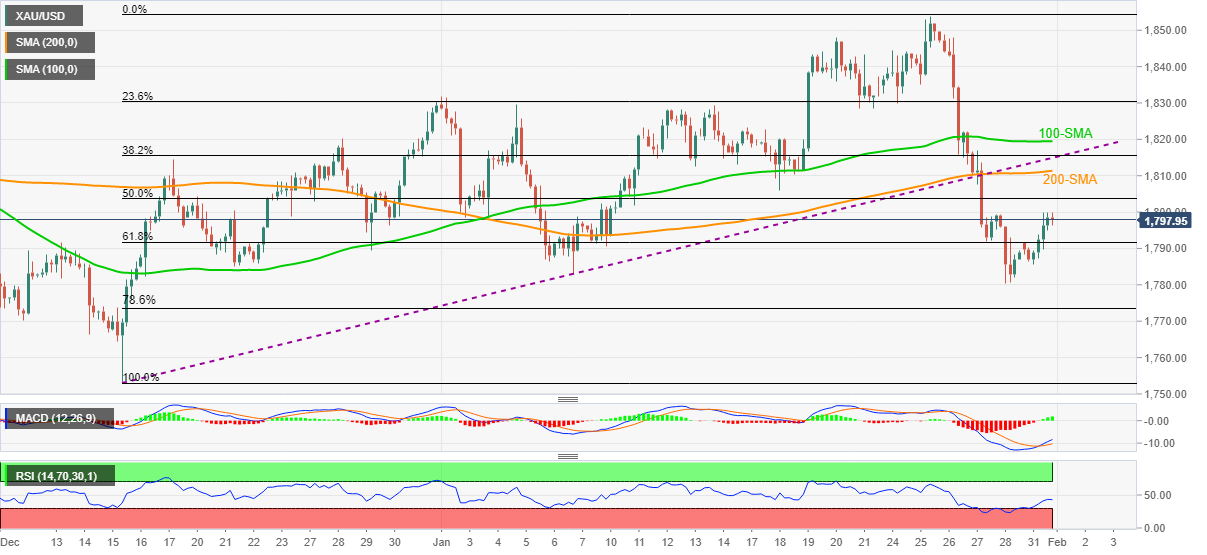
To sum up, gold prices are up for consolidating the Fed-led losses but the bulls have strong challenges to justify their strength.
- The USD/JPY pair begin on the wrong foot in the Asian session.
- Unchanged US T-bond yields boosted the Japanese yen, the USD fell.
- USD/JPY is upward biased, but it would need a daily close above 115.50-70.
As the Asian Pacific session kicks in, the USD/JPY is trading at 115.11 at the time of writing. The US cash equity markets closed in the green, while the US 10-year T-bond yield, which correlates positively with the USD/JPY, is flat at 1.784% at press time.
The market sentiment is upbeat. Asian equity futures are mixed, led by the Hang-Seng rising, while the biggest loser is the Australian ASX7200.
In the New York session, Fed speaking was in the spotlight. Most of them agreed that a hike rate in the March meeting is on the cards. Nevertheless, some divergences in the balance sheet loom. So any chances of the Quantitative Tightening (QT) starting in the March meeting seems unexpected.
Over the weekend, Atlanta’s Fed President Raphael Bostic crossed the wires. He stated that a 50 basis points hike is possible, but it would depend on economic data. Meanwhile, San Francisco Fed President Mary Daly said that she is uncomfortable with inflation this high and sees rate hikes as early as March. Daly further noted that if the Federal Funds Rate (FFR) hits 1.25% by the end of the year, it would still be supportive despite being a lot of tightening.
Later on, Kansas City Fed President Esther George noted that a more aggressive reduction of the balance sheet, coupled with hiking rates, would alter the yield curve, so she backpedaled some of her “hawkish” monetary policy stance.
Therefore, USD/JPY traders would lean on Japanese economic data crossing the wires at 23:30 GMT. Japanese Unemployment Rate for December came at 2.7%, below the 2.8% foreseen, in line with the previous reading. Later at 00:30 GMT, the Jibun Bank Manufacturing PMI for January could offer some cues to give direction to the pair.
USD/JPY Price Forecast: Technical outlook
On Monday, early in the Asian session, the USD/JPY peaked around 115.59, at the R1 daily pivot point, to then retreat towards the daily pivot point at 115.35 in the European session. However, when the North American session began, the pair slid under the 50-hour simple moving average (SMA), pushing the pair towards the 100-hour SMA at 114.90. As the session progressed, the US T-bond yield recovered the 1.78% threshold, and the pair jumped above the 115.00 figure.
That said, the USD/JPY is upward biased. The daily moving averages (DMAs) reside above the spot price, confirming the bias, but an upslope trendline around the 115.50-70 would be challenging to overcome for USD bulls. If the USD/JPY break above the previous mentioned, that would open the door towards 116.00. A breach of the latter would expose the YTD high at 116.35.
- GBP/USD grinds higher after posting the biggest daily gains in a month.
- A confluence of 50-DMA, fortnight-old descending trend line restricts short-term downside.
- 50% Fibonacci retracement guards immediate upside ahead of 100-DMA.
GBP/USD holds onto the previous day’s resistance break around 1.3440-45 during a quiet start to Tuesday’s Asian session.
The cable pair rose past a downward sloping trend line from January 14 following its bounce off the 61.8% Fibonacci retracement (Fibo) of December 2021 to January 2022 upside.
However, the 50% Fibo. level guards the quote’s further advances around 1.3450, a break of which will direct the GBP/USD prices towards the 100-DMA level of 1.3517.
It’s worth noting that the 1.3500 threshold will act as an intermediate halt whereas the 1.3600 round figure may lure GBP/USD bulls past 1.3517.
Meanwhile, a convergence of the 50-DMA and resistance-turned-support line near 1.3420 becomes the key nearby support to watch during the quote’s pullback moves.
Following that, the 61.8% Fibonacci retracement level and the recent swing low, respectively around 1.3385 and 1.3355, will challenge the GBP/USD sellers.
Overall, GBP/USD prices have recently crossed a short-term key hurdle and hence may witness further recovery.
GBP/USD: Daily chart
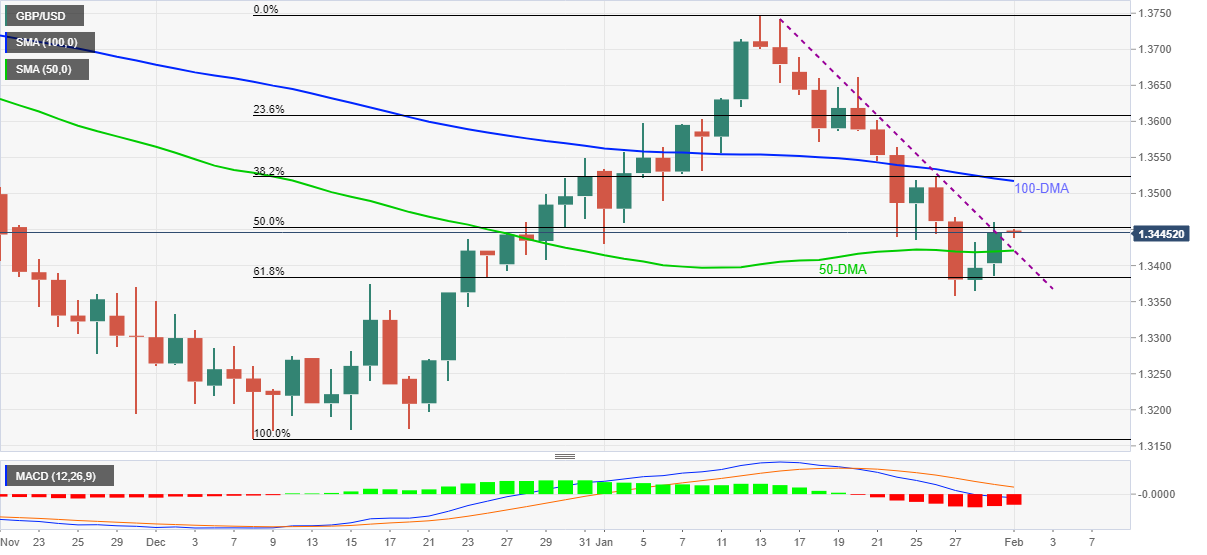
Trend: Further upside expected
Early Tuesday morning in Asia, the Washington Post (WaPo) quotes an anonymous US Official saying, “The Russian government has delivered a written response to a U.S. proposal aimed at de-escalating the Ukraine crisis.”
“It would be unproductive to negotiate in public, so we’ll leave it up to Russia if they want to discuss their response,” adds the US diplomat.
The news also stated, “The official declined to provide details about the proposal, delivered ahead of an upcoming phone call between Secretary of State Antony Blinken and Russian Foreign Minister Sergei Lavrov on Tuesday.”
“We remain fully committed to dialogue to address these issues and will continue to consult closely with our allies and partners, including Ukraine,” adds the US official per WaPo.
It’s worth noting that UK PM Boris Johnson is also scheduled to visit Ukraine on Tuesday.
Market reaction
The news eases the pressure from the oil traders and hence WTI crude oil prices begin Tuesday’s Asian session on a back foot, down 0.20% around $87.40 at the latest.
“Indirect talks between the United States and Iran on returning to the 2015 nuclear agreement are entering the “final stretch,” with all sides having to make tough political decisions,” per a Senior US State Department Official, said Reuters during late Monday.
During a telephonic updates from Vienna, the official also mentioned, “Iran may choose not to go down the road of compliance with the agreement, and Washington is ready to deal with that contingency.”
FX implications
The news should have ideally helped the riskier assets but the risk-barometer AUD/JPY remains pressured ahead of the key Reserve Bank of Australia (RBA) meeting.
Read: AUD/JPY stays above 81.00 amid firmer sentiment ahead of RBA
- AUD/JPY consolidates the heaviest daily in rise, battles 13-day-old resistance line.
- Risk appetite improves at the week’s start without major positives.
- Aussie data came in positive, China PMIs signaled downbeat start of 2022 ahead of Lunar New Year holidays.
- Hawkish expectations from RBA tests bulls ahead of the event, Japan’s Omicron updates, jobs report important as well.
AUD/JPY struggles to extend the heaviest daily jump in over a month by grinding around 81.30-40 amid the pre-RBA caution on early Tuesday.
The risk barometer pair rose the most since January 13 before a fortnight-old resistance line challenged the bulls ahead of the key monetary policy meeting of the Reserve Bank of Australia (RBA). Additionally, the softer-than-forecast Commonwealth Bank of Australia Manufacturing PMI for January, 55.1 versus 55.3, also probes the AUD/JPY buyers of late.
AUD/JPY began the week on a positive note, tracking the general market mood, as traders licked the Fed-led moves amid a light calendar. Also favored the riskier assets were Japanese PM Fumio Kishida’s rejection to call another virus-led state of emergency and softer prints of Japan’s Retail Trade, as well as Industrial Production, figures for January.
It’s worth observing that China’s official activity numbers for January came in softer while the Caixin Manufacturing PMI marked a contraction in activities with 49.1 figures.
On a broader front, the US 10-year Treasury yields hovered around 1.78% but a positive performance of the Wall Street benchmarks favored the AUD/JPY to print daily gains.
Looking forward, pre-RBA caution may keep the AUD/JPY prices below the aforementioned short-term resistance. However, hawkish expectations from the Aussie central bank can become a reason for the currency pair to remain weak afterward.
Market consensus favors a formation end to the A$350 billion bond-buying program and signals hints for the rate hikes. “We expect the RBA to forecast trimmed mean inflation of 3% by mid-2022, with unemployment falling below 4% by the end of the year. Despite this we expect the RBA Board to say it will wait until wages growth accelerates further before it lifts the cash rate,” said ANZ.
Ahead of the RBA, Australia Retail Sales for January and Japan’s job numbers will entertain the AUD/JPY traders. However, nothing matters more than the Aussie monetary policymakers’ verdict.
Read: Reserve Bank of Australia Preview: A hawkish surprise from Lowe & Co?
Technical analysis
A downward sloping trend line from January 13 restricts immediate AUD/JPY upside around 81.45, a break of which will direct the pair towards the 200-DMA hurdle of 82.51. Meanwhile, 23.6% Fibonacci retracement (Fibo.) of October-December 2021 downside, near 80.55, precedes the 80.00 threshold to keep AUD/JPY buyers hopeful.
- AUD/USD bulls move in on the 50% mean reversion zone.
- The RBA will be the critical event where volatility is likely to occur.
As per the start of the week's analysis, AUD/USD Price Analysis: Bulls accumulating, mark-up could be on the cards, traders move din on the bid and took the price higher to test the 0.7080s.
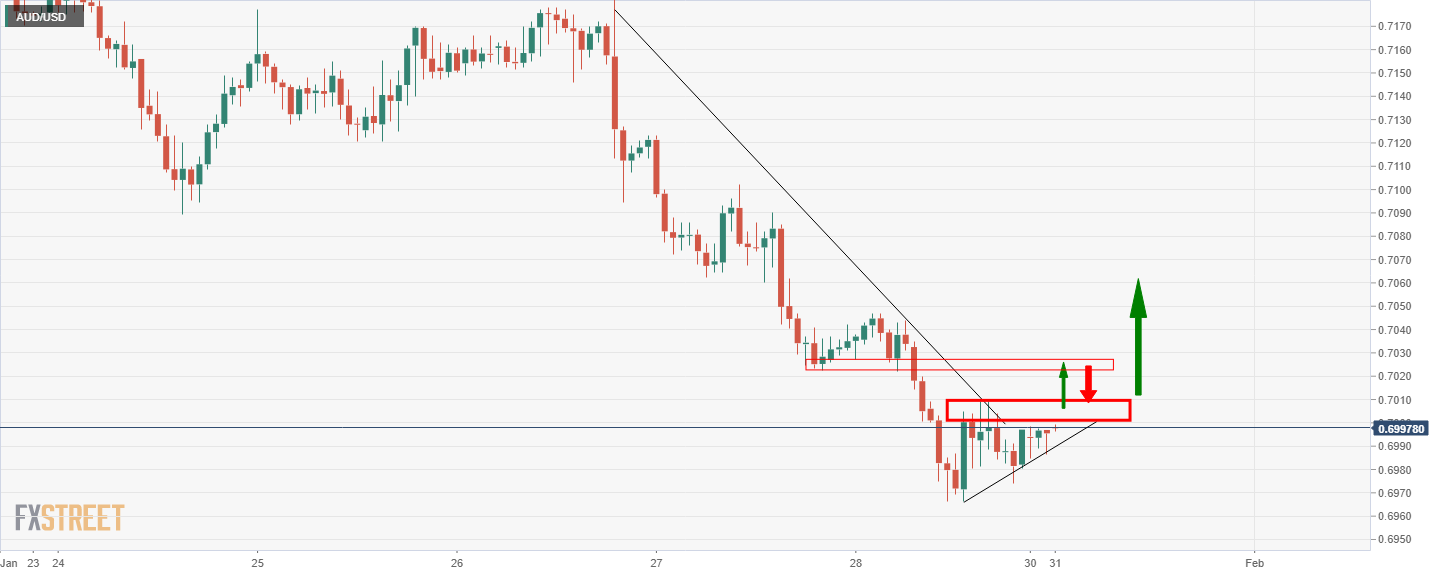
AUD/USD live market

The price has started to stall here and is carving out dynamic support that could come under pressure again in the session ahead as traders get set for the Reserve bank of Australia tomorrow.
In the start of the week's analysis, AUD/USD: It's a big week for the Aussie, a come back could be on the cards, it was stated, from a daily perspective that a correction would be the most typical course for the pair at this juncture prior to further downside:
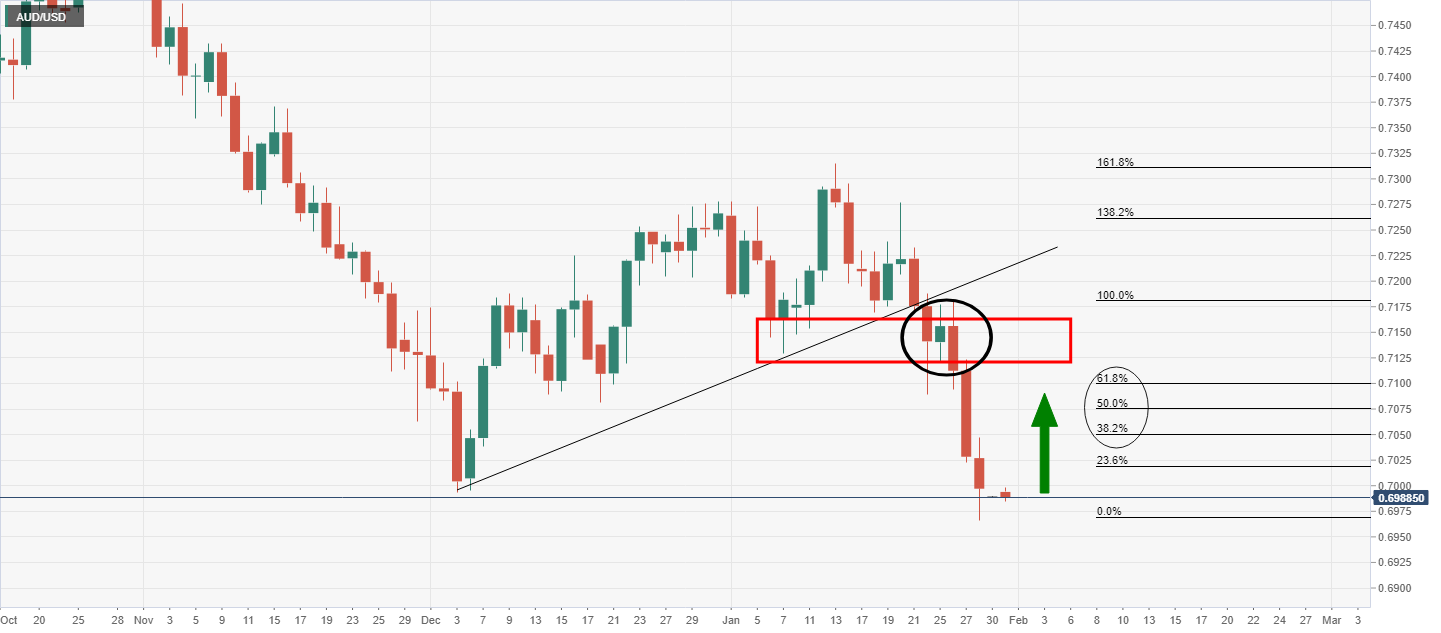
AUD/USD live market
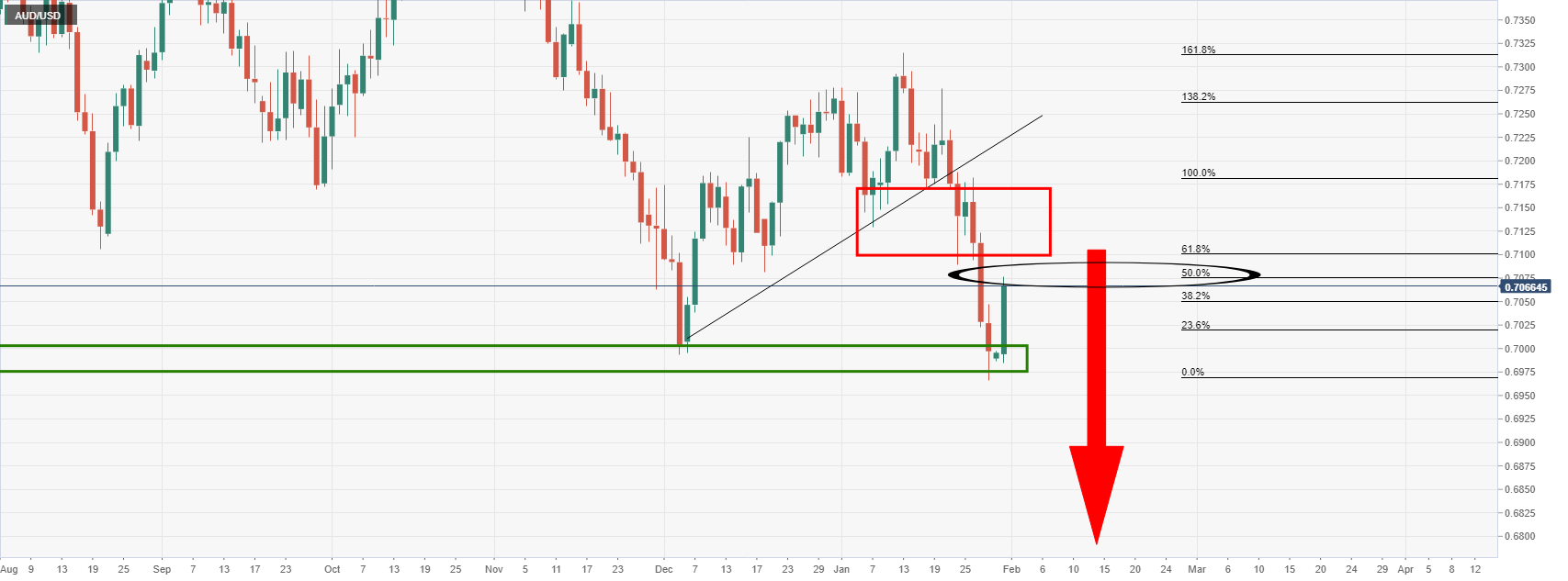
As illustrated, the price has moved in on the forecasted target zone, but there could be more to come from the bulls in the days to come prior to the next test of the 0.6950s.
- Indecision in the NZD/JPY pair keeps the cross-currency range-bound.
- A risk-on market mood keeps the NZD in the bid, weighed on the safe-haven JPY.
- NZD/JPY is downward biased, but in the event of a daily close above 76.00 would open the door for further gains.
The NZD/JPY snaps two days of losses, steady around 75.70 at the time of writing. US equity indices print gains as the New York session finishes. Alongside that, commodity currencies like the NZD, the AUD, and the CAD, rose by 0.76%, 1.03%, and 0.45%, respectively. Contrarily, safe-haven peers led by the USD and the JPY
NZD/JPY Price Forecast: Technical outlook
On Monday, in the Asian session, the NZD/JPY rose higher up to 76.01, to then retreat some towards 75.71. Following the retracement, American traders got to their desks reached a daily high around 76.11, following the path of US equities, but failed to break above that resistance area, sending the pair tumbling towards the daily lows around 75.50s.
The NZD/JPY daily chart depicts a downward bias. The daily moving averages (DMAs) reside above the spot price, providing the direction of the trend. Furthermore, failure to break the resistance above 76.00 keeps the cross-currency pair trading near the tops of the 75.27-75.96 range.
If the NZD/JPY pair prints a daily close above 76.00, that would open the door for further gains. The next resistance would be the January 20 daily low, previous support-turned-resistance at 77.05, followed by the 50-DMA at 77.46.
On the flip side, the first support would be the July 2021 lows at 75.27, followed by 2021 yearly lows at 74.56.
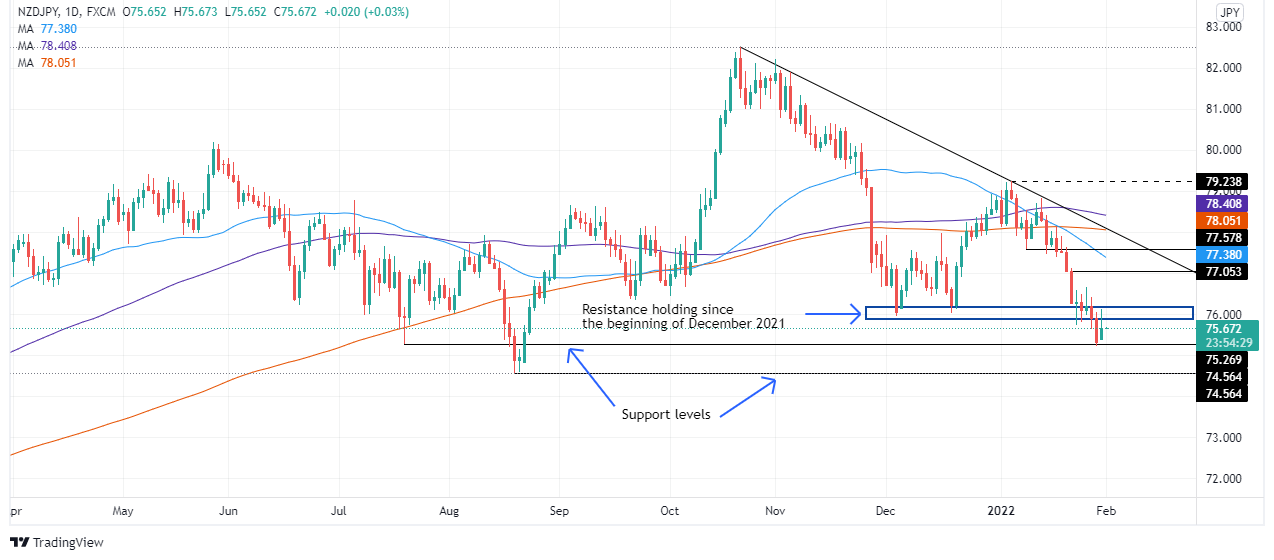
- NZD/USD bulls step in as the US slides at the start of the week.
- The central bank meetings will start off with the RBA.
NZD/USD is firm into the closing part of the New York session having rallied from a low of 0.6538 to a high of 0.6597. At 0.6582, the cross is 0.67% higher on Monday as the US dollar slides on the back of prospects of a centralised effort to contain inflation by global central banks, bridging the divergence between the Federal Reserve.
The dollar index (DXY) was down 0.63% at 96.56 putting it on track for its largest daily fall since Jan. 12 as central banks’ focus this week will be on securing a sustainable business cycle. ''That means emergency monetary policy accommodation will need to be unwound in most geographies in the foreseeable future,'' analysts at ANZ bank explained.
This has led to a rebound of global risk appetite. The three main benchmarks on Wall Street all traded higher. By 20:37 the Dow Jones Industrial Average rose 0.83% the S&P 500 1.49% and the Nasdaq Composite 2.61%.
Meanwhile, the Reserve bank of Australia is going to be taking the spotlight in Asia tomorrow.''While no hike is expected, we do expect the RBA to formally end QE, and to signal that QT will start from next month as the bonds it owns start to mature, and it’s the market’s take on this that has and will influence the AUD,'' analysts at ANZ bank said. ''Commodities continue to boom, with the broad CRB Index up just under 1% to a 7yr high. All of this has potential to support the NZD down here, or limit the downside.''
- EUR/JPY rallied to one-week highs in the 129.30s on Monday amid a broad uptick in macro risk appetite.
- The real test, from a technical perspective, will come when the pair hits the 129.50 balance area.
EUR/JPY saw a decent rebound on Monday, a function of a broad improvement in global risk appetite rather than broadly in line with expected Eurozone Q4 GDP and flash January inflation data. The pair rebounded from under 128.50 to jump back to the north of the 129.00 level and proceed to hit a one-week high in the 129.30s and also move above the 50-day moving average at 129.28. At current levels around 129.30, the pair trades with gains of 0.7% on the day, the best such one-day performance since early December.
From a technical perspective, the recent push into the 129.30s and to fresh one-week highs is a good sign for momentum this week, but the real test will come when EUR/JPY challenges the 129.50 area. This zone has been a key area of both resistance and support in the last few months. If traders expect the risk-off flows that dominated throughout most of January to be the dominant force in the coming months, then a retest of 129.50 might be seen an attractive entry point to reload on short positions.
Fundamentally speaking, one problem for that outlook is the fact that Eurozone/Japan rate differentials continue to move in the former’s favour as ever more ECB tightening is priced into the long-end of the Eurozone rate curve. The German 10-year on Monday hit its highest level since May 2019 at 0.03%, while the German 2-year broke out to its highest level since April 2019 at -0.525%. Focus this week will be on Thursday’s ECB meeting, which is not expected to deliver any policy changes.
Traders will be eagerly assessing whether the bank can add further fuel to the recent rise in Eurozone bond yields which has, so far, been primarily driven by the spillover impact of rising US yields. If so, that could EUR/JPY back towards 130. If this week’s US data and Fed speak spurs fresh hawkish Fed bets and further US bond yield upside, that might also help, as long as it doesn’t also trigger a sell-off in equities that spurs safe-haven yen demand.
Federal Reserve Bank of Richmond President Thomas Barkin said that he would like the Fed to get better positioned, speaking in an interview with CNBC on Monday. How fast we go depends on how the economy develops, he added, saying also that the pace of rate hikes will depend on the pace of inflation. I'd like us to be closer to neutral than we are now, he said, before reiterating that he expects goods prices to ease.
Moving on to discuss the labour market, he said what he is really watching is labour wage pressure and that we are at "interim" full employment, but there is still some upside ahead. Barkin added that he is expecting a strong job market to continue into the spring and summer. Moving on to the economy, there is no question we saw a demand issue in January, he added, but he has his fingers crossed for a stronger spring. The Fed is still a long way from triggering any recession, he added, saying that he is not seeing any weakening in core demand, and that it is not the focus of the Fed to worry about a recession when demand is still strong.
Market Reaction
FX markets do not seem to have reacted to the latest remarks from Barkin.
- GBP/JPY building up the base for a significant downside breakout.
- Bearish wedge formation is potentially at an extreme and the market could be due for a shakeout of longs.
As per the prior analysis, GBP/JPY bulls are on the move early doors, eyes on central bank divergences, GBP/JPY moved in on the liquidity pool target and subsequently sold off aggressively.
GBP/JPY prior analysis
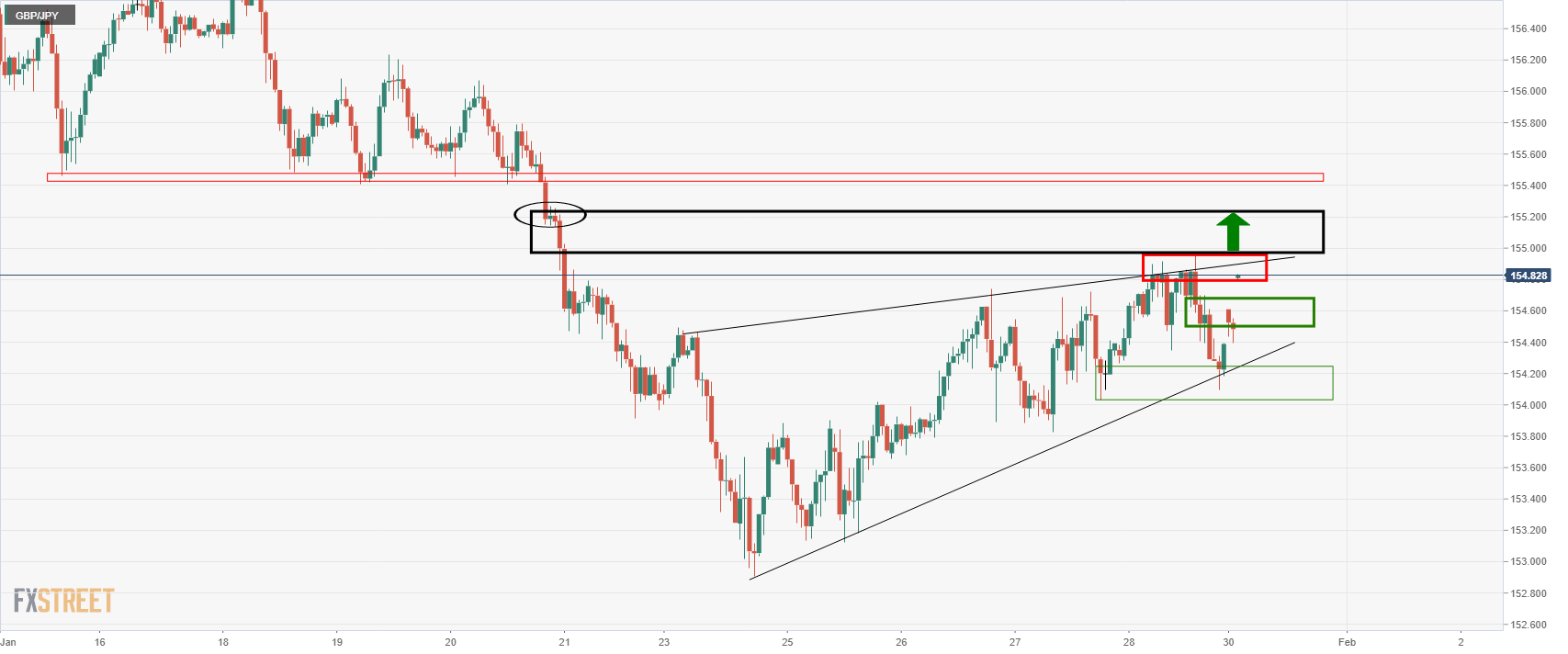
GBP/JPY live market
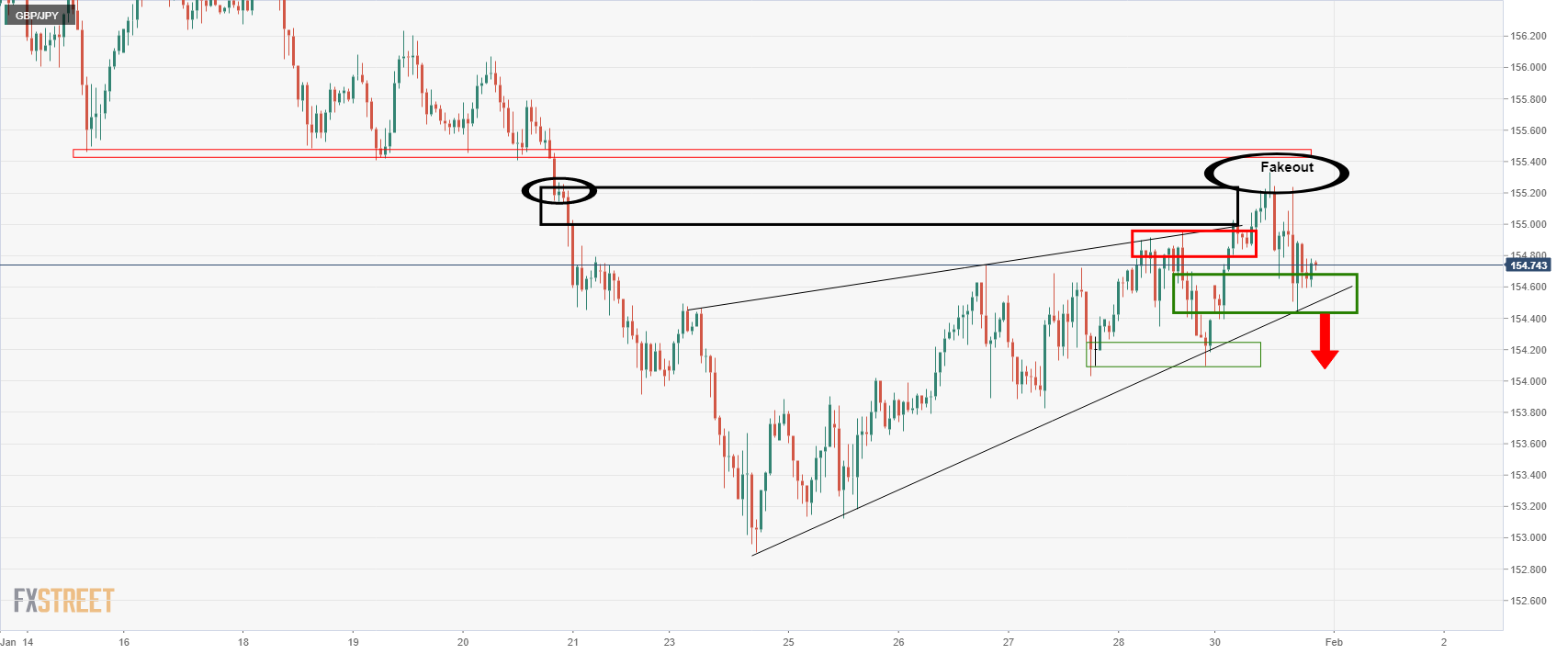
The price is now back into the old wedge formation following a spike through resistance in what could be termed as a fake-out that simply went to grab more liquidity from an area that was previously marked as a target for the open.
At this juncture, there is a bias to the downside and a break of 154.40 opens the risk of a test to 154 the figure as the last defence of a potentially significant downside breakout of the bearish wedge formaton.
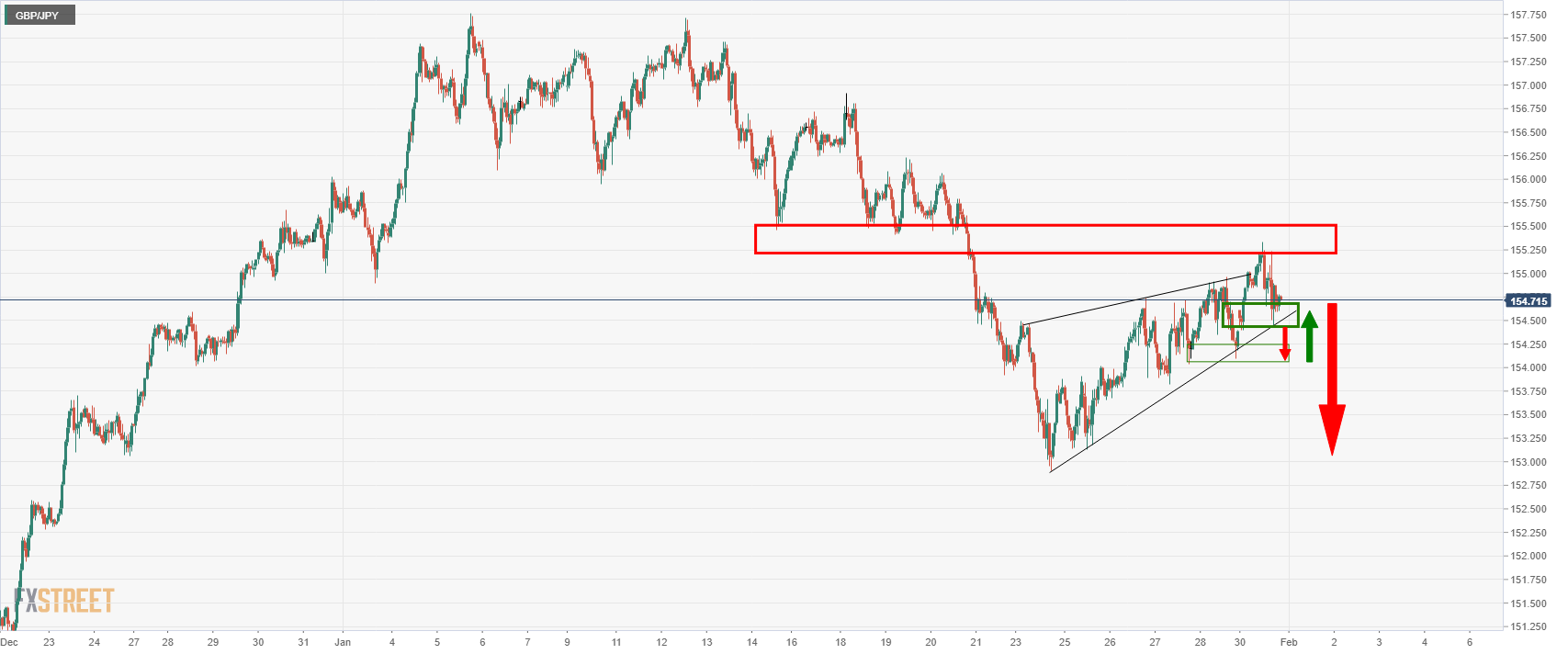
What you need to know on Tuesday, February 1:
The greenback edged lower against most major rivals, as speculative interest completely digested the US Federal Reserve’s aggressive tightening pat and as attention shifts to other central banks and US employment figures.
The Reserve Bank of Australia will announce its monetary policy decision early on Tuesday, with market participants anticipating the end of the pandemic-related QE and a possible announcement of sooner-than-planned rate hikes amid mounting inflationary pressures.
Later in the week, the European Central Bank and the Bank of England will have monetary policy decisions. Finally, on Friday, the US will publish the January Nonfarm Payrolls report.
Stocks staged a nice comeback, with Wall Street holding on to substantial gains heading into the daily close, adding pressure on the American currency. US government bond yields, in the meantime, ticked lower with that on the 10-year Treasury note settling at around 1.77%.
The EUR/USD pair trades in the 1.1230 region, while GBP/USD stands at 1.3460. Commodity-linked currencies posted intraday gains, with AUD/USD now trading at around 0.7070 and the USD/CAD pair just below the 1.2700 figure. Safe-haven currencies also advanced vs their American rival.
Spot gold struggles to overcome the $1,800 threshold, holing nearby. Crude oil prices are marginally higher, helped by Wall Street’s strength, with WTI trading at $88.12 a barrel.
British Prime Minister Boris Johnson still risk his premiership after a report by senior civil servant Sue Gray, uncovered multiple parties, some of which the PM attended, and a failure of leadership in his government in the early stages of coronavirus lockdowns. According to the report, gatherings were "difficult to justify."
Binance creates $1 billion insurance funds against hackers, benefiting BNB price
Like this article? Help us with some feedback by answering this survey:
Swiss National Bank Chairman Thomas Jordan said on State TV on Monday that he sees no sign of a Swiss wage-price spiral and that inflation is more or less at its peak and will recede. The strength of the Swiss franc limits Swiss inflation, he added, but remarked that stubbornly high inflation above 2.0% elsewhere in the world would lead to policy tightening. Finally, Jordan said that the Swiss franc had remained stable in real terms.
Market Reaction
The Swiss franc was unreactive to Jordan's latest remarks, which stuck to the bank's usual script.
- Silver is flat after reaching a week of losses, though as the New York session end approaches, silver is flat.
- The US 10-year T-bond yield is flat at 1.777%, despite Fed policymakers piling to raise rates in March.
- XAG/USD Technical Outlook: Downward biased, but upside risks remain, as shown by the bullish harami.
Silver (XAG/USD) grinds higher during the North American session, trading at $22.48 at the time of writing. The market sentiment remains upbeat, with US equity markets trading in the green, while the US dollar remains under heavy downward pressure. The US Dollar Index, a measurement of the greenback’s versus a basket of six rivals, drops near 0.70% sits at 96.61.
Meanwhile, the US 10-year Treasury yield, which when It raises weighs on non-yielding assets, is flat at 1.777%.
Regional Federal Reserve Presidents favor rate hikes
An absent US economic docket kept precious metals investors glued to their screen as Fed speakers crossed the wires. Over the weekend, Atlanta’s Fed President Raphael Bostic (voter 2024) said that he foresees three rate hikes by the end of 2022 and would not discount a 50 basis points increase to the Federal Funds Rate (FFR).
On Monday, earlier in the day, San Francisco Fed President Mary Daly (voter 2024) said that “inflation is too high” and added that the US central bank is “not behind the curve at all.” Worth noting that if the FFR ends at 1.25% in 2022, Daly said that “that is quite a bit of tightening, but still supporting the economy.”
An hour later, Kansas City Fed President Esther George (voter 2022), who leaned to the hawkish tilt in the FOMC board, noted that the risks of a “large” balance sheet should not be ignored. Furthermore, She said it could be “appropriate to move earlier on the balance sheet relative to the Fed’s last tightening cycle.” Worth noting that a steep path for rate hikes coupled with “modest” reductions of the balance sheet could lead to more financial risk.
The US economic docket will feature the JOLTS Openings report for December on Tuesday. That, alongside the ISM Manufacturing Prices and the Dallas Fed Index for January, could give XAG/USD traders some cues about the US Dollar.
XAG/USD Price Forecast: Technical outlook
From a technical perspective, XAG/USD is downward biased. Nevertheless, the last couple of trading sessions failed to break below a one month-upslope trendline, which provided support, around $22-3545 region.
To the upside, the first resistance would be the 50-day moving average (DMA) at $22.91. A breach of the latter would expose the 100-DMA at $23.22. A break above it would open the door for a January 3 daily high test at $23.40.
The S&P 500 surged towards a key area of resistance at the 4500 level on Monday, though was unable to surpass the big figure for now. Nonetheless, the indice's on-the-day gains currently stand at roughly 1.4%, taking the two-day run of gains to more than 3.5%. The tech-heavy Nasdaq 100 index is seeing even more impressive gains of over 2.5% on the session and is now up more than 5.0% in the last two sessions. The Dow is up 0.8% and probing its 200-day moving average at the 35K level, up about 2.5% in the last two sessions. The S&P 500 CBOE Volatility Index or VIX saw a sharp 2.5 point drop to around 25, taking it to now more than 13 points below last week’s highs near 39.
Some analysts put the strong gains, particularly in the hard-hit tech sector, down to month-end factors. “Today's and Friday's bounce is just some of the institutional guys saying Nasdaq was due for end of the month rebalancing… It is simply a little bit of a relief rally after such a sharp sell-off," said an analyst at Ally Invest. But the Nasdaq 100 index was also helped by a more than 9.0% jump in Tesla’s share price after being upgraded to “outperform” at Credit Suisse, and amid a nearly 10.0% jump in Netflix after shares were labeled as “buy” at Citigroup.
Nonetheless, the Nasdaq 100 looks set to close out the month 9.1% lower, the S&P 500 5.6% lower and the Dow 3.7% lower. Fed tightening fears have been the major driver of the downside, with markets now expecting five 25bps rate hikes in 2022 and with Fed speakers so far this weak doing nothing to dampen this speculation. Fed speakers have also done nothing to dampen speculation that the first move, expected in March, could be a 50bps rate hike. Fed’s Raphael Bostic, speaking over the weekend and again on Monday, explicitly outlined a 50bps as a possibility (though not his base case assumption).
Looking ahead this week, the Fed tightening story will receive further inputs in the form of plenty more Fed speak, as well as key US data releases, most important of which is Friday’s January labour market report. The report will be closely scrutinised for signs of wage inflation and a further tightening of the labour market, given that this is what the Fed is mostly focused on right now. The headline NFP number won’t be as important, with economists and the Fed expecting a weaker number compared to recent months given the impact of Omicron.
Another important equity market theme this week is the ongoing Q4 earnings season. Following last week’s decent results from Apple and Microsoft last week, Alphabet (Google), Amazon and Meta Platforms (Facebook) will be reporting. According to Refinitiv data cited by Reuters, 77.4% of S&P 500 companies who have reported earnings thus far (about one-third of the index) have beaten analyst expectations. To shield equity markets from further Fed tightening fears induced downside, this strong run of earnings will need to continue.
- GBP/USD bulls are moving in for an attack on critical resistance.
- The US dollar is weak and the pound is benefitting from BoE sentiment.
At 1.3448, GBP/USD is firming in mid-day New York trade and moves in towards the highs of Monday near 1.3455. The US dollar has come under further pressure in recent trade and the US dollar index DXY was down 0.61% 96.624, putting it on track for its largest daily fall since January 12.
Investors have consolidated gains in the US dollar ahead of the closely-watched monthly employment report later this week and the pound is bid as traders expect the Bank of England to be raising interest rates for the second time in as many months.
The BoE meets on Thursday
Most economists polled by Reuters expect the BoE to raise rates to 0.5% on Feb. 3 from 0.25%. Reaching the 0.5% threshold would also see the bank stop reinvesting maturing gilts and start to reduce its 875 billion-pound government bond holdings.
However, there are some analysts that are calling for a far more aggressive move from the central bank. Goldman Sachs is calling for interest rates at 1% in May and 1.25% in November to show "the MPC (Monetary Policy Committee) is serious about the inflation target, and will act to ensure the UK does not face the risk of a wage-price spiral."
Analysts at Rabobank said that ''the money market has been positioned for a fair amount of tightening this year. That said, fears of a spike in the cost of living in the UK question whether the BoE be able to match these expectations.''
In the lead into this week's meeting, we heard from several BoE policymakers who have commented on inflation risks in recent weeks. The governor of The Old Lady, Andrew Bailey, was suggesting the risk of second-round inflation effects was a source of concern and that the bank would do "everything we can do".
GBP/USD technical analysis
As per the start of the week's analysis, GBP/USD Price Analysis: Bears lurking at critical daily resistance near 1.3440, the price is moving in on the critical resistance.
GBP/USD, prior analysis
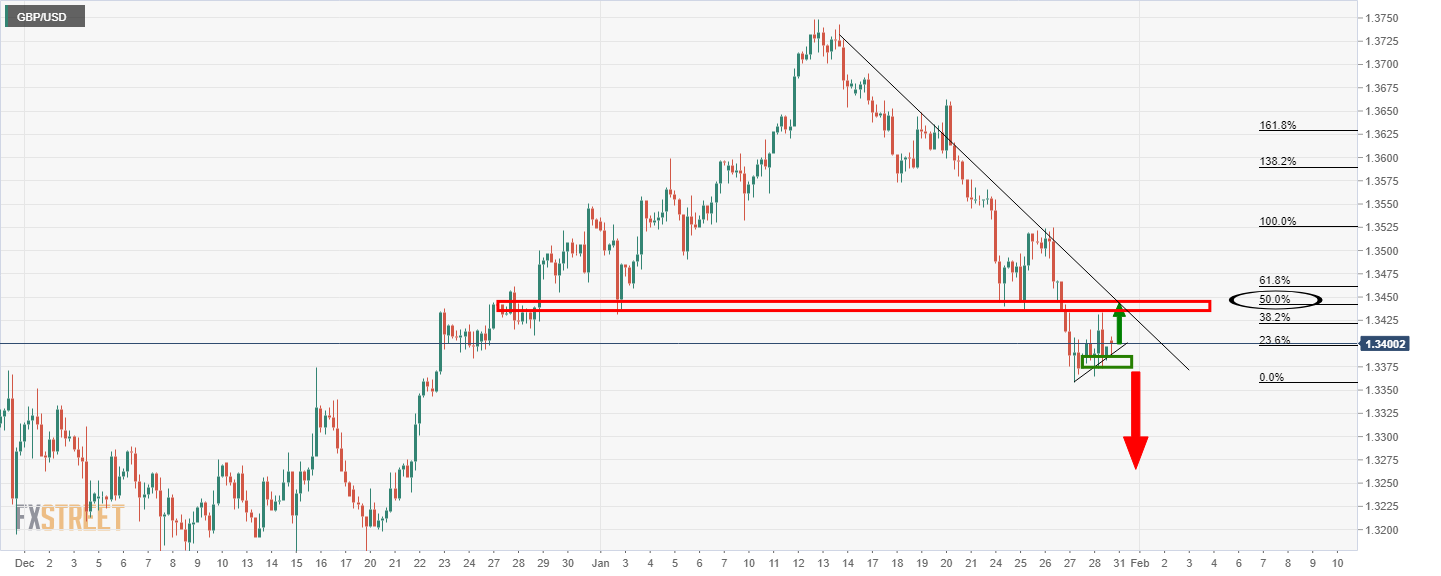
GBP/USD live market
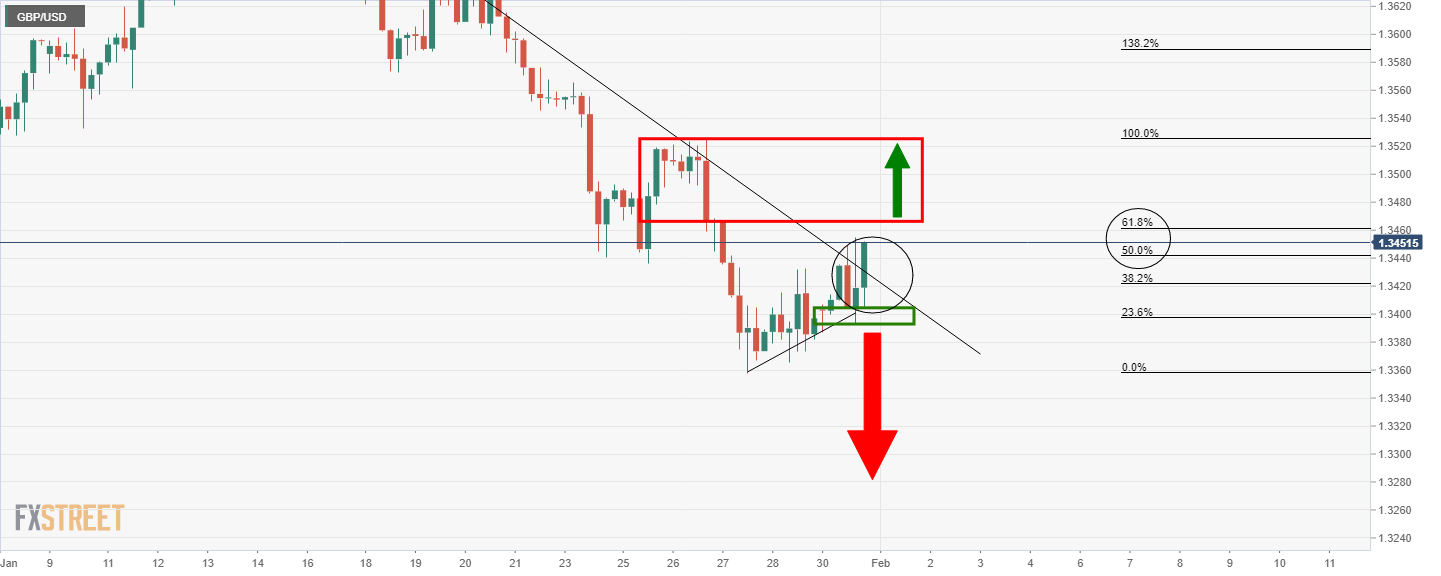
The price has penetrated into resistance and there are prospects of a continuation into the 1.3520's on a break of the 1.3470.
- AUD/USD is on course for its best one-day rally since June 2021 and is more than 1.5% above Friday lows.
- The pair is trading in 0.7060s, up about 1.1% ahead of a highly anticipated RBA policy announcement.
- The focus will then switch to US data for the rest of the week, culminating in Friday’s official jobs report.
A positive start to the week, as far as global equity markets are concerned, and profit-taking following last week’s hawkish Fed policy announcement induced surge have seen the US dollar turn sharply lower on Monday. Stronger than expected January Chicago PMI figures and commentary from Fed policymakers which broadly stuck to the bank’s new hawkish script was unable to turn the tide for the US dollar. The Aussie has been the major G10 beneficiary of buck weakness as focus turns to Tuesday’s RBA monetary policy announcement.
AUD/USD has rallied more than 1.1% on Monday to the 0.7060s and is on course for its best one-day performance since June 2021, putting the pair now nearly 1.5% above the sub-0.6970 19-month lows it hit last Friday. Aussie traders will be closely scrutinized the upcoming RBA meeting with regards to 1) its decision on QE and 2) its interest rate guidance. Regarding the former, consensus expectations are for the bank to ax bond-buying in its entirety and regarding the rate guidance, markets expect some pivot towards admitting that the conditions for a rate hike could be met in 2022. However, the scope for the RBA to hawkishly surprise the market, which is pricing in a full 25bps rate hike by the end of H2 2022, is somewhat limited.
That may limit any post-“hawkish RBA policy shift” gains in AUD/USD to underneath resistance in the 0.7100 area. Indeed, any rally past these levels might be seen by US dollar bulls anticipating inflationary and tight US labour market numbers on Friday as a good short entry point. As the threat of a 50bps move by the Fed in March hangs over the market’s head, FX markets are likely to be even more volatile to US employment and labour market data in the coming weeks than usual.
Federal Reserve Bank of Atlanta President Raphael Bostic on Monday told Yahoo Finance that he expects three rate hikes in 2022, in a reiteration of remarks made over the weekend. He clarified that a 50bps move in March was not the Fed's preferred policy action and that the Fed is not fixed on a set policy progression. Bostic continued that he is "laser-focused" on the Fed's next meeting and how data on inflation and jobs are evolving, before saying that, at this point, it is hard to anticipate too much what the "long arc" of policy will be.
Bostic continued that he had penciled in 3.0% inflation for the full year 2022, adding that he anticipates labour and supply-side disruptions to ease. If inflation responds more quickly, the Fed could go slower, he added, though noting that this is not his base case assumption give that businesses appear to have built in price increases already. Regarding the coming official US jobs report, Bostic said he expects the headline number to be a little lower than recent months to reflect the influence of Omicron, before saying that he is hopeful that job growth will rebound in February and March.
Market Reaction
FX markets do not seem to have paid much attention to the latest remarks from Fed's Bostic.
- EUR/USD bulls are correcting last week's bearish closing candle.
- Bears are moving aside at critical hourly resistance.
EUR/USD is on the verge of an important upside break on the hourly charts. Bulls have their eyes set on a significant correction of last week's bearish close and eye the 61.8% retracement level of the daily bearish impulse.
EUR/USD weekly chart
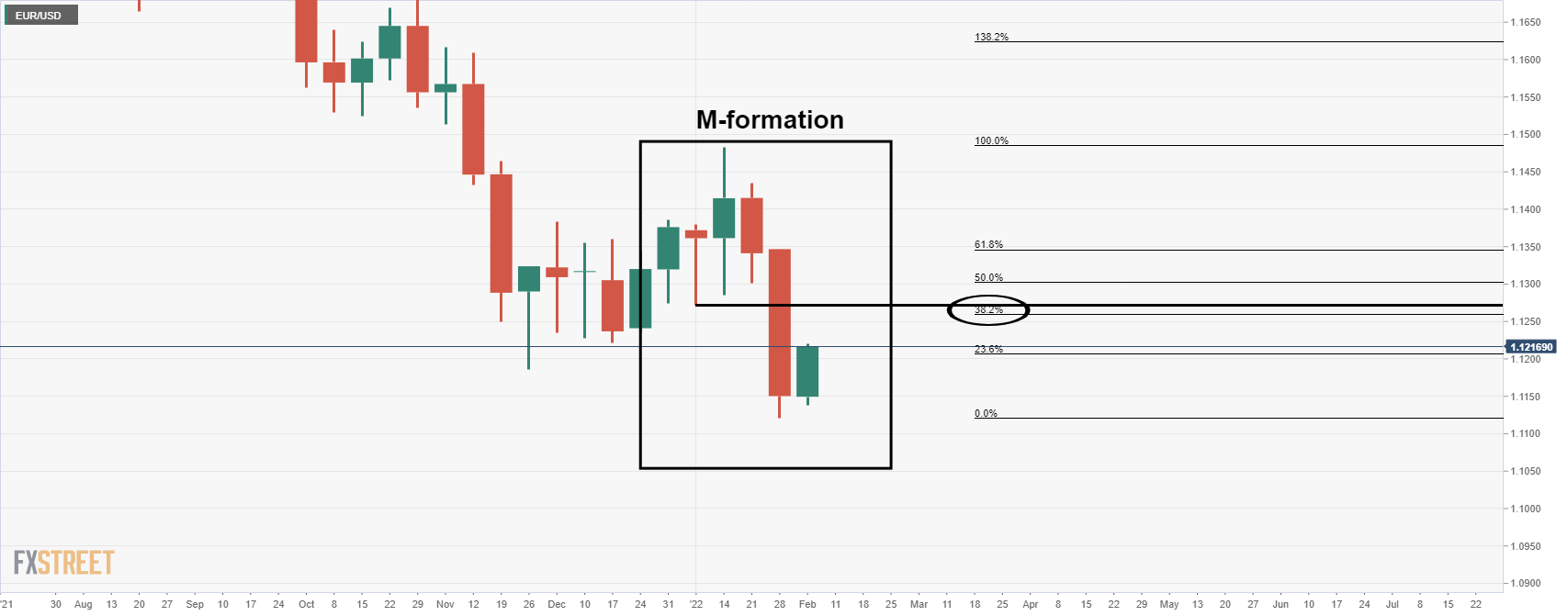
The M-formation is compelling. This is a reversion pattern with a high completion rate whereby the price would be expected to head back towards the neckline of the formation, in this case, this is located near 1.1270 and the 38.2% Fibonacci level as additional confluence.
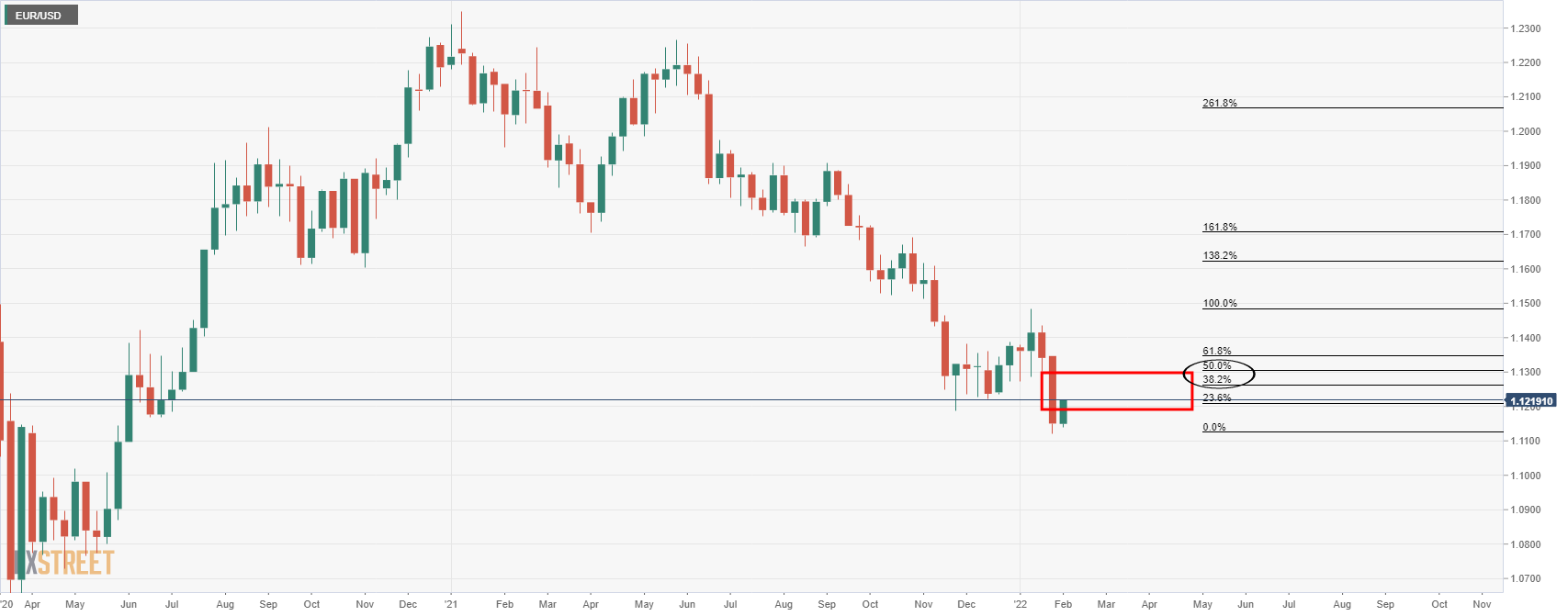
The price, as illustrated has already started to make a move into the prior lows near 1.1220. A bullish weekly close this week will cement the probability of a deeper correction to follow.
EUR/USD daily chart
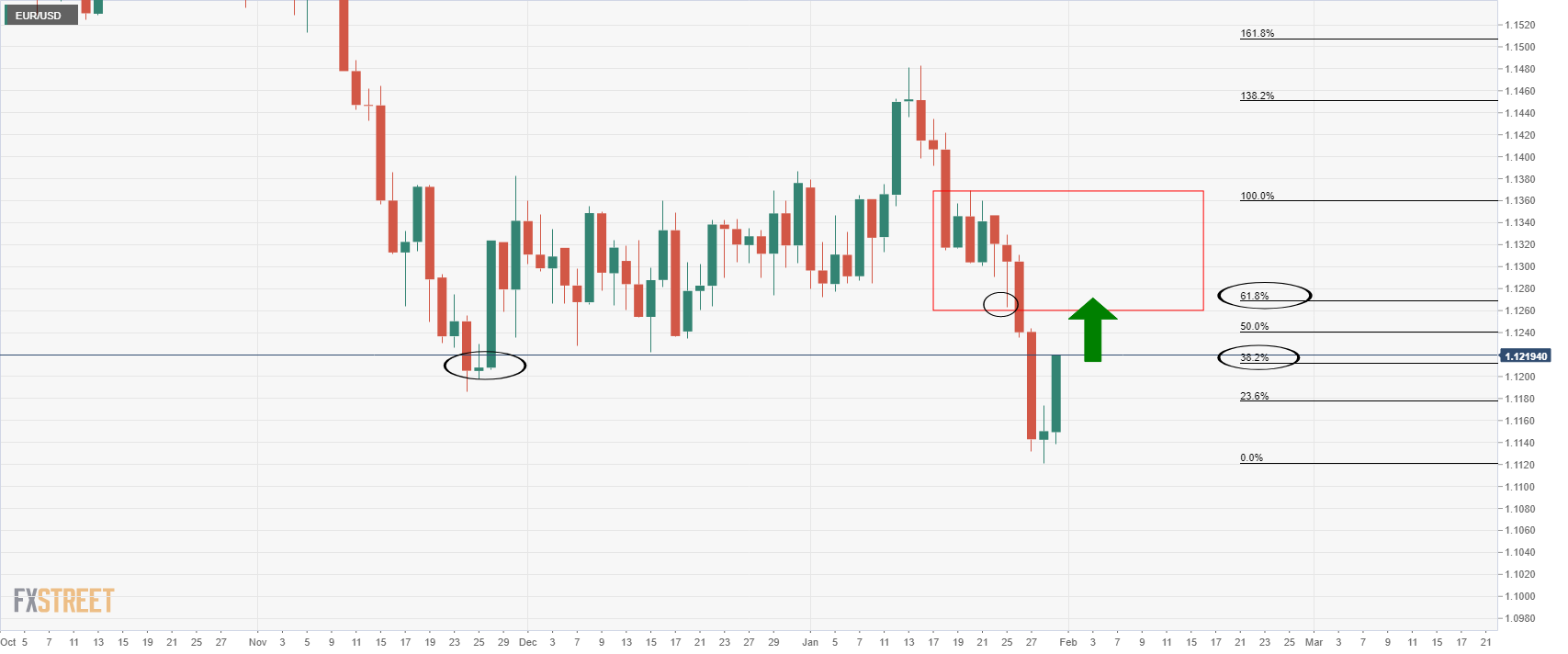
The daily chart shows that the price has rallied sharply into the prior lows following Friday's doji candle. This is a bullish candlestick scenario and is encouraging for the bulls and countertrend traders. The 61.8% Fibonacci retracement of the prior bearish impulse is located at 1.1270 also, cementing the target down for the week ahead.
EUR/USD H1 chart
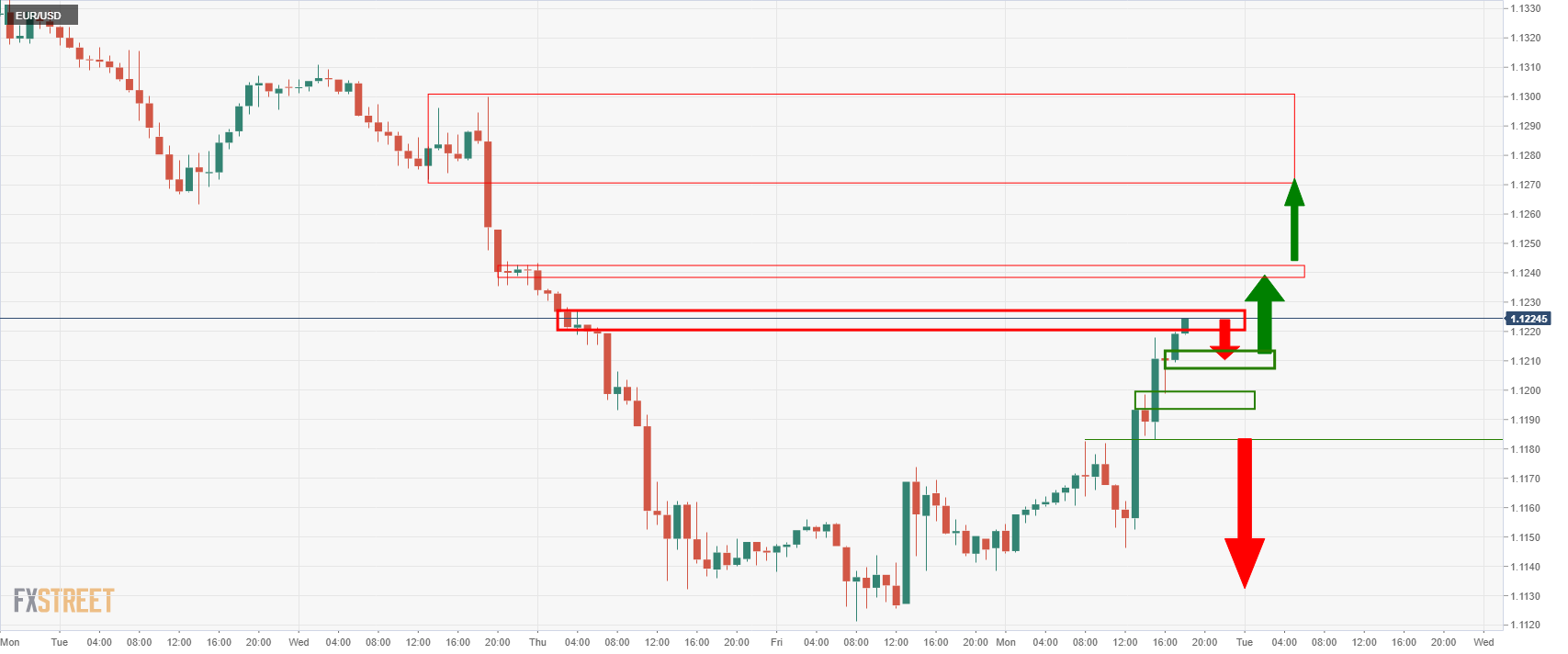
From a near term perspective, the bulls continue to press on in the New York trade. However. there are now up against a wall of resistance near 1.1230 that could be expected to reject the price in initial tests. However, the market is bullish while above 1.1210. 1.1240 should give way to 1.1270 targets in coming sessions. On the flip side, a break below 1.1180 would leave the price in consolidation once again.
- The USD/CAD strengthens despite flat US crude oil prices, as the greenback remains offered.
- Fed speakers crossing the wires failed to lift the US dollar.
- USD/CAD Technical Outlook: Upward biased, but if bears break below the 100-DMA, would expose the 200-DMA.
In the North American sesión, the USD/CAD falls for the first time in four straight trading days, losses 0.60%. At press time, the USD/CAD is trading at 1.2697. European and US cash equity indices gain, except for the Dow Jones, barely down 0.02%. In the FX complex, the commodity currencies led by the AUD, the NZD, and the CAD, are gaining between 0.60% and 1%, to the detriment of the USD and the JPY.
In the meantime, the Western Texas Intermediate (WTI) US crude oil benchmark is trading at $86.71, barely up 0.02%, a tailwind for the Loonie. The US Dollar Index, a gauge of the greenback’s value versus a basket of six rivals, falls sharply more than 0.50%, sitting at 96.75.
Fed speakers crossing the wires fail to boost the greenback
During the weekend, Atlanta’s Fed President Raphael Bostic expressed that he foresees at least three rate hikes, beginning in March, but further noted that the Federal Reserve would increase 50 basis points if inflations remain “stubbornly high,” according to the FT.
Meanwhile, crossing the wires, Fed’s Daily said that “inflation is too high,” but at the same time noted that labor market recovery is uneven. Regarding monetary policy, she noted that the Fed is “not behind the curve at all.” Furthermore said that she “does not want to ratchet up the rates so quickly that it bridles growth to mouch.” Daly further added that if the US central bank gets to 1.25% in the Federal Funds Rate (FFR) by the end of the year, “that is quite a bit of tightening, but still supporting the economy.”
The Canadian economic docket features the Producer Price Index (PPI) for December, which came at 0.7% on its monthly reading, higher than the 0.1% in November. Regarding the annually based figure, it rose by 16.1%, lower than the 17.1%.
Meanwhile, Esther George, and Raphael Bostic, Federal Reserve Presidents, would cross the wires around 17:40GMT, and 18:30 GMT, respectively. Any hints regarding balance sheet reduction and rate hikes could be taken from their words.
USD/CAD Price Forecast: Technical outlook
The USD/CAD daily chart is upward biased at press time, as depicted by the daily moving averages (DMAs) residing above the spot price. However, the 50-DMA is under heavy pressure, lying at 1.2711 gave way to CAD bulls, which try to reclaim control, but they will need to break under the 100-DMA at 1.2620 to have a shot at the 200-DMA at 1.2503.
On the flip side, if USD bulls reclaim the 1.2700 figure, that would expose the USD/CAD to upward pressure. The first resistance would be January 28, a daily high at 1.2797, followed by December 3, 2021, a high at .12854, and then 1.2900.
Reuters has reported that Kansas City Fed President Esther George said on Monday that the Federal Reserve can move sooner to start reducing its bond holdings than in the past and aggressive action to shrink the US central bank's portfolio.
"What we do on the balance sheet will likely affect the path of policy rates and vice versa," George said in remarks prepared for an event organized by the Economic Club of Indiana. "For example, more aggressive action on the balance sheet could allow for a shallower path for the policy rate."
The news agency reported that George said a different approach in which the central bank pairs a "steep path" for rate increases with more modest reductions to the balance sheet could lead to more financial risks.
She said such a scenario where the Fed is raising short-term interest rates while putting downward pressure on long-term yields through its bond holdings "could flatten the yield curve." That could, in turn, lead to "reach-for-yield behaviour from long-duration investors."
"All in all, it could be appropriate to move earlier on the balance sheet relative to the last tightening cycle," George said.
Market reaction
There has been no reaction to the comments in the market and the US dollar remains pressured on Monday, as investors consolidated gains ahead of the closely-watched monthly employment report later this week, Nonfarm Payrolls.
The currency has rallied to a 1-1/2-year high on Friday as investors take stock of the hawkishness at the Fed.
The dollar index DXY was down 0.48% after George's comments at 96.758, putting it on track for its largest daily fall since January 12.
- USD/CHF is trading flat just above 0.9300 after ignoring Fed’s Daly and SNB’s Jordan ahead of more Fed speak.
- Fed speak, alongside US data, will be a key theme for USD/CHF this week.
- Bulls are eyeing a test of H2 2021 highs in the 0.9370 area.
USD/CHF flatlined on Monday, as the safe-haven Swiss franc and US dollar both underperformer their other more risk-sensitive G10 peers amid a broad pick up in the market’s appetite for risk. The pair did manage to squeeze out a fresh 10-week high in the 0.9340s but has since ebbed back to trading flat on the day just above the 0.9300 level, with the December high in the 0.9290s offering decent support. The pair was unreactive to the latest weekly domestic Swiss sight deposits which showed a sharp rise (indicative of an uptick in SNB intervention) or remarks from SNB Chairman Thomas Jordan. Jordan did not say anything new or interesting on central bank policy, though did praise recent moves by the Fed to signal upcoming rate hikes.
Meanwhile, the latest remarks from San Francisco Fed President Mary Daly were also broadly ignored by FX markets. Daly threw her support behind the removal of extraordinary monetary stimulus this year. Reading between the lines, she also hinted that she could be open to five 25bps hikes, as she said that ending the year with rates at 1.25% would still mean providing support to the economy. FX markets don’t have much time to dwell of Daly’s latest remarks, with remarks from Fed policymakers Ester George (at 1740GMT) and Raphael Bostic (at 1830GMT) coming up shortly ahead of a smattering of other Fed speakers throughout the week.
Fed speak will of course be one of the key FX market drivers this week after last week’s hawkish Fed policy announcement sent the US dollar surging across the board. Also feeding into the Fed tightening theme will be a barrage of US data, most important of which will be Friday’s January labour market report. Particular focus will be on indicators of wage inflation and labour market tightness, with the headline NFP number expected to be weak (Omicron deterring workers from finding jobs). If this week’s Fed speak and US data does further pump Fed tightening bets, that could be enough to send USD/CHF to test H2 2021’s double top around 0.9370.
Federal Reserve Bank of San Francisco President Mary Daly on Monday noted that if the Federal Funds rate was to reach 1.25% by the end of the year, that would be quite a bit of tightening but still supportive of the economy. Presumably, she is talking about the possibility of five 25bps rate hikes in 2022 to take the Federal funds target range to 1.25-1.50% by the year's end. The fact that she (as one of the Fed's more dovish policymakers) points out that, even after five hikes, the level of interest rates would still be economically supportive could be seen as a nod of approval by Daly to market expectations for five hikes this year.
Additional Takeaways:
"Our two goals feel somewhat in tension."
"Inflation is too high, and labor market for disadvantaged groups is stronger than it has been in a long time."
"It's time to adjust the policy rate to get the economy on a sustainable path."
"I don't want to be too quick to declare victory on full employment."
"I am completely comfortable with making interest rate adjustments in 2022, but open about 2023."
"You could pretty much use any averaging period you want and the Fed would be meeting 2% inflation on average."
"We still have an aging population, slower productivity growth and lower neutral rate of interest that are putting downward pressure on inflation in the medium run."
On Friday, the US official employment report will be released. Market consensus is for an increase in payrolls of 155K while analysts at Wells Fargo expect a decline by 100K. They anticipate average hourly earnings to rise by 0.6% during January.
Key Quotes:
“In recent months, there have been substantial revisions to the payroll data each month, and January will bring annual benchmark revisions to the payroll survey, shedding additional light on the underlying trend in hiring. Looking ahead, the Omicron wave looks to have slowed hiring markedly in the first month of 2022.”
“Aside from causing a surge in worker absenteeism due to illness, the hiring process was likely significantly derailed by the wave of new infections, which reached a peak during the survey week. On the other hand, employers' reluctance to part ways with seasonal workers amid increasingly dire shortages of labor might help offset the drag from the sharp acceleration in case counts.”
“All together, we stand apart from the consensus view of a modest gain and expect payrolls to decline by 100,000 in January. We look for the unemployment rate to hold steady at 3.9%, although we note that new population controls for the household survey will be released with January's report, which could add extra noise to the household numbers. F
Swiss National Bank Chairman Thomas Jordan told Swiss broadcaster SRF on Monday that we have to take inflation developments seriously, and that while some of this inflation is certainly temporary, all central banks have to be careful it doesn't become permanent. Jordan reiterated that inflation is expected to come down and noted that, in the medium and long-term, monetary policy must ensure that inflation is always within the price stability range.
On the Fed moving towards tightening, Jordan noted that the Fed raising rates is a good sign for the US economy and shows that it is working at capacity. Moreover, the Fed raising rates means that interest rates around the world are going up a little, which is a positive for us (Switzerland).
Market Reaction
CHF has not reacted to the latest remarks from SNB Chair Jordan.
Federal Reserve Bank of San Francisco President Mary Daly reiterated on Monday that she is not comfortable with inflation as high as it is and that she does see a rate hike as soon as March.
Additional Takeaways:
"Balancing the Fed's two mandates is always the challenge."
"The US economy is getting to a more self-sustaining path."
"Supply chain bottlenecks are pushing prices up."
"When trying to get the economy to a self-sustaining path have to be gradual, and not disruptive."
"We are not behind the curve at all."
"In December, no Fed policymakers thought rates would go above terminal rate by end of the cycle."
"What we see today is broad-based price pressures."
"Demand and supply imbalance is pushing prices up and the Fed needs to act."
"There is no preset course for Fed policy... there are a lot of risks."
"If the economy progresses as I expect, it is clear it can stand partially on its own two feet."
"The Fed doesn't need to keep providing extraordinary accommodation."
"It's appropriate to remove accommodation."
"You don't want to ratchet up the rates so quickly that it bridles growth too much."
"We hope that supply chains repair and fiscal aid is rolling off."
The Bank of England will announce its decision on monetary policy. Market consensus points to a rate hike of 25bp to 0.50%. Analysts at Danske Bank see the BoE raising rates three times in 2022 (February, May and November) and consider that expectations of five hikes as being to the aggressive side.
Key Quotes:
“We expect the Bank of England to hike the Bank Rate to 0.50% at its upcoming meeting on Thursday. We expect two additional hikes this year (May and November) but risks are skewed towards more rate hikes. Markets are pricing in nearly five rate hikes this year.”
“We expect the BoE to announce “passive QT” (ceasing reinvestments of maturing bonds) in connection with the upcoming meeting. The BoE has previously stated QT would start when the Bank Rate reaches 0.50%. We expect “active QT” (selling bonds to markets) when the Bank Rate reaches 1%. Our base case right now is that happens in November, but since we believe risks are skewed towards more rate hikes, risk is also skewed towards an earlier start for “active QT”.”
“Our base case is three rate hikes in 2022 (February, May and November) but markets are pricing in around 125bp this year, i.e. five rate hikes. We also see risks skewed towards more rate hikes than the three we have pencilled in right now, but we still see five as being to the aggressive side, also given the headwinds the UK economy may face over the course of the year, such as tighter fiscal policy.”
- Gold advances closes to 0.50% in the North American session, amid US dollar weakness and falling US T-bond yields.
- Atlanta’s Federal Reserve President Raphael Bostic eyes three rate hikes.
- The Ukraine – Russia conflict reclaims the spotlight in talks at the UN.
- XAU/USD Technical Outlook: Neutral bias, though upside/downside risks remain.
Gold (XAU/USD) snaps three days of losses, jumping from a support trendline around the daily lows at $1785. At the time of writing, XAU/USD is trading at $1796, slightly short of the 50-day moving average (DMA), which resides at $1801.
So far, an improvement in the market mood has hurt the prospects of a higher greenback, with the USD Dollar Index down some 0.46% in the day, under the 97.00 handle. Furthermore, the US 10-year Treasury yield undermines the buck, down one basis point sitting at 1.787%.
Fed’s Raphael Bostic would not rule a 50 bps hike
During the weekend, Atlanta’s Fed President Raphael Bostic expressed that he foresees at least three rate hikes, beginning in March, but further noted that the Federal Reserve would increase 50 basis points if inflations remain “stubbornly high,” according to the FT.
Meanwhile, the Fed parade began once the US central bank blackout was lifted. Fed’s Daily, George, and Bostic would cross the wires around 16:30 GMT, 17:40GMT, and 18:30 GMT, respectively. Gold traders might turn their attention to all of them, particularly Kansas City Fed Esther George, a voter in 2022. Any hints regarding balance sheet reduction and rate hikes could be taken from their words.
In the meantime, the Ukraine – Russia conflict, which investors put aside for a moment after the Federal Reserve monetary policy meeting, gets into the spotlight. The UN security council voted to hold a public meeting on a build-up of Russian troops on the Ukraine border. Furthermore, China’s ambassador to the UN said that he does not consider Russia’s troop build-up near the Ukraine border a threat, per Reuters.
Meanwhile, US President Joe Biden commented that if Russia chooses to walk away from diplomacy and attack Ukraine, there will be consequences.
XAU/USD Price Forecast: Technical outlook
The XAU/USD daily chart shows a confluence of the daily moving averages (DMAs) around the $1795-$1805 area, which could pave the way for further gains once broken to the upside.
The first support would be $1,800. A breach of the latter would expose Pitchfork’s channel central line around the $1,825-30 area, followed by July 2021 swing high at $1,834 and the YTD high at $1,854.
Contrarily, failure at $1,800 would expose the January 28 daily low at $1,780. Giving way for USD bulls would reveal crucial support levels like November 3, 2021, daily low at $1,759, followed by December 15, 2021, swing low at $1,753.
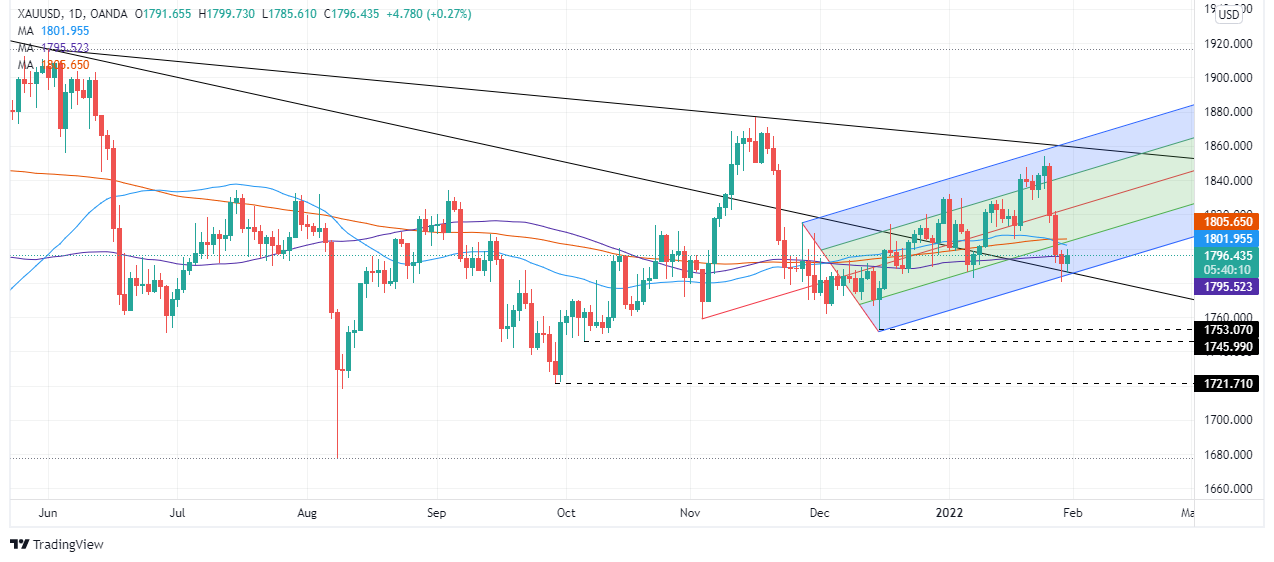
- Aussie strengthens ahead of the RBA meeting.
- More gains seem likely if AUD/NZD breaks above 1.0730.
The AUD/NZD is rising on Monday, testing the 1.0730 resistance area. It has been trading at the highest level since July. The 1.0725/30 is the upper limit of the current range. The cross is moving sideways, consolidating after strong gains with an upside bias.
A break and a consolidation above 1.0730, would clear the way to more gains with the next target at 1.0800, which should limit the upside.
The bullish bias is likely to remain intact while above 1.0650. A daily close clear below 1.0650 should point to an extension on the downside, with the next strong barrier at 1.0570.
Volatility is likely to remain elevated considering the incoming Reserve Bank of Australia meeting and the fact that AUD/NZD is trading at key technical levels. Also, the RSI is about to reach 70, suggesting some exhaustion to the upside.
AUD/NZD daily chart
-637792418141050428.png)
- NZD/USD is enjoying a modest rebound from the 14-month lows it struck last Friday amid better risk appetite.
- NZD/USD traders will have plenty of US data, Fed speak, and Q4 NZ jobs data to monitor this week.
A more risk-on mood in global equity and FX markets at the start of the week has facilitated a rebound in NZD/USD from last Friday’s 14-month, sub-0.6530 lows, with the pair trading about 0.6% higher on the day around 0.6575. Amid the better tone to risk and ahead of a week packed full of key US data releases, the US dollar is taking a breather following last week’s outsized rally (the biggest one-week move higher in seven months). As far as NZD/USD traders are concerned this week, Friday’s official US labour market report is the main risk event. Any signs of growing wage pressures and further reductions in labour market slack could further pump Fed tightening bets and prompt further USD strength, adding downside risks for NZD/USD.
Traders may not have to wait for Friday for a pumping of tightening bets; a smattering of Fed policymakers will be publically orating this week, starting with Fed’s Ester George, Mary Daly and Raphael Bostic later on Monday. The latter already hinted over the weekend that, should the data warrant it (i.e. inflation not subside), he would be open to a 50bps move or more than the three rate hikes he currently expects in his base case. Other US data is less likely to shift the dial. The latest Chicago PMI for January was stronger than expected but didn’t seem to faze FX markets and it may be a similar story for the ISM PMI surveys on Tuesday and Thursday.
While risks do seem tilted towards a stronger US dollar from a fundamentals standpoint, technicals, particularly with regards to NZD/USD, may be pointing in the opposite direction. Admittedly, the pair didn’t quite hit the 0.6500 level (support from August 2020) which many medium-term bears will still be targetting, suggesting further downside remains on the table. But the 14-day Relative Strength Index (RSI) on Friday fell to its lowest since early December at just above 24.00, signaling the currency pair had become oversold (in the short-term, at least). Looking at the performance of the pair in the post-pandemic period, every time the RSI has fallen to the 30 area or below, this has been a leading indicator of near-term consolidation.
Couple with the above with hawkish calls from NZ-based Kiwibank for the RBNZ’s Official Cash Rate to hit 2.5% by November 2020 (a total of seven 175bps of tightening) and the case for a further large drop is substantially weakened. Q4 2021 New Zealand Labour Market data on Wednesday, if it shows an even greater tightening of the country’s labour market, could thus offer the beleaguered kiwi some much-needed support via RBNZ tightening bets. Note that at 3.4% in Q3, the New Zealand unemployment rate was already substantially lower than levels seen (by economists and the RBNZ) as consistent with long-term price stability.
- Japanese yen recovers versus dollar but drops against most G10 currencies.
- DXY drops after five-day rally, down 0.38%.
- USD/JPY heads for the third consecutive daily close near 115.30.
The USD/JPY pair is trading in neutral territory on Monday during the American session. Earlier it peaked at 115.59 but failed again to hold above 115.50 and lost momentum. The US dollar is pulling back after rising sharply last week.
US yields are modestly higher on Monday, with the 10-dayer at 1.79% after making a spike to 1.81% while the 30-year stands at 2.10%, down from 2.13%. In Wall Street, equity prices are rising. The Nasdaq gains 1.65% and the Dow Jones 0.04%.
Economic data released on Monday showed the Chicago PMI rose in January from 64.3 to 65.2 against expectations of a decline to 61.7. The Dallas Fed Manufacturing Business Index dropped from 7.8 to 2, versus market consensus of 9.9. The key report of the week is the official employment report due on Friday.
The greenback opened the week under pressure, correcting lower after the rally following the FOMC meeting that triggered expectations of four to five rate hikes from the Fed during 2022.
The positive momentum of the USD/JPY is easing as it remains unable to hold firm above 115.50. If the dollar manages to confirm levels above the mentioned area, it would point to further gains a possible test of 116.00. On the flip side, the correction could extend to 114.80/85 (20-day moving average) if it breaks below 115.00.
Technical levels
The Reserve Bank of Australia (RBA) will meet on Tuesday, February 1 at 03:30 GMT and as we get closer to the release time, here are the forecasts by the economists and researchers of eight major banks regarding the upcoming central bank's decision. The RBA is expected to end its pandemic-related bond-buying program while market participants speculate policymakers will bring forward rate hikes’ guidance.
ING
“The RBA will probably say they'll keep rates as they are until all, not just most, of the evidence points to a hike. But we might not have too long to wait for that and asset purchases may soon be on the way out. Even if we get a hawkish tilt, the market's already hawkish pricing along with external woes should limit AUD/USD upside”
ANZ
“We expect the RBA to forecast trimmed mean inflation of 3% by mid-2022 with unemployment falling below 4% by the end of year. Despite this we expect the RBA Board to say it will wait until wages growth accelerates further before it lifts the cash rate. This will be a complicated message for the market to absorb. But it will be a clear signal the RBA is serious about wanting to see sustainably faster wages growth before it moves. Its forecast for wages growth will likely point to a rate hike in the first half of 2023 as being its central case, but Lowe will also admit for the first time that a move in 2022 is a possibility if wages growth comes through faster than forecast. This will likely reinforce the market’s belief a rate hike will happen this year.”
Westpac
“The RBA will announce that the QE government bond-buying program will come to an end in February. The cash rate will be held at the record low of 0.1% at this meeting. However, some shift in language is likely in the decision statement. Westpac expects the RBA to begin a tightening cycle this August. The RBA will acknowledge that inflation is now back in the target band and that the unemployment rate is nearing full employment. The RBA expects wages growth to lift – but will highlight uncertainty around the speed and timing of that likely acceleration.”
Standard Chartered
“We maintain our call for the RBA to end QE in February. The bigger question will be how RBA responds to recent labour and inflation data. Notably, Q4 trimmed mean CPI rose 2.6% YoY, moving above the mid of RBA’s target range of 2-3%. In addition, the print is higher than the end-2022 projection of 2.25% in the November Statement on Monetary Policy. While one print does not mean that underlying inflation is now sustainably within the 2-3% range, RBA may need to acknowledge upside risk to inflation. We will watch for any removal of reference to wages and inflation to take some time to reach its target or the RBA “being prepared to be patient”. We will also watch for any changes to the reference on materially high wage growth being needed to generate higher inflation. We currently expect the RBA to start hiking rates in November this year; however, the risk is increasing for the first hike to be earlier.”
Danske Bank
“The RBA is widely expected to end QE purchases. We do, however, think RBA is unlikely to take a hawkish stance as markets are currently pricing.”
TDS
“The Target Cash rate is likely to remain at 0.10% but the Bank's central scenario for the u/e rate, trimmed mean and wages growth is likely to be consistent with the Bank lifting the cash rate this year. The economic forecasts and the Bank formally announcing an end to QE provide room for the removal of state-based forward guidance. The Aus front end should underperform.”
SocGen
“We expect the RBA to maintain the cash rate target of 0.10% and to announce that the government bond purchase programme will end from mid-February. The question is whether they will revise the forward guidance on the timing of the first policy rate hike. We think the RBA is likely to introduce a subtle change; maintaining the conditions for a rate hike, but removing the qualifications of ‘likely to take some time’ and ‘the Board is prepared to be patient’.”
Citibank
“The RBA’s first meeting for 2022 is likely to see it end its QE program and upwardly revise its underlying inflation forecasts following the Q4 CPI upside surprise. But although we now believe the RBA is poised to hike rates twice in H2’22, it’s probably still early for the RBA to turn hawkish. But hawkish risks could arise this week if the Bank softens its language around the requirement for wages growth, though unlikely.”
- EUR/USD approaches the key barrier at 1.1200.
- German 10y Bund yields advance past 0.03%.
- EMU flash Q4 GDP rose 4.6% YoY, 0.3% QoQ.
The buying interest around the European currency keeps growing on Monday and pushes EUR/USD to the very boundaries of 1.1200 the figure.
EUR/USD bid on risk-on trade, data
EUR/USD posts gains for the second session in a row on Monday, bolstered by the generalized risk-on sentiment, positive data releases and investors’ repricing of a potential interest rate hike by the ECB at some point by year end.
In addition, yields of the key German 10y Bund advance to levels last seen in May 2019 past 0.03%, while yields of the US 10y benchmark navigate above 1.80%.
In the euro docket, advanced EMU Q4 GDP figures showed the economy is expected to have expanded 0.3% QoQ and 4.6% YoY. In Germany, preliminary inflation figures now see the CPI rising 0.4% MoM in December and 4.9% from a year earlier.
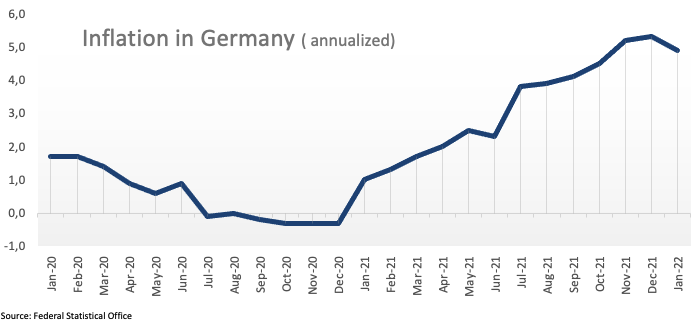
EUR/USD levels to watch
So far, spot is gaining 0.38% at 1.1190 and faces the next up barrier at 1.1198 (weekly high January 31) seconded by 1.1304 (55-day SMA) and finally 1.1369 (high Jan.20). On the other hand, a break below 1.1121 (2022 low Jan.28) would target 1.1100 (round level) en route to 1.1000 (psychological level).
- WTI recently dipped below $87.00 back towards session lows, but remains broadly well supported close to recent highs.
- Strategists cite geopolitics (Russia/Ukraine/Nato), OPEC+ supply concerns and robust/recovering demand as sources of oil market support.
Oil markets have seen a subdued start to the week, with front-month WTI futures spending most of Monday’s session thus far consolidating within an $87.00-$88.00 range, not far below last week’s multi-year highs at $88.82 per barrel. More recently, WTI has dipped under the $87.00 level and is trading in the red by about 50 cents and at session lows. However, WTI remains well within recent ranges and there is plenty of support in the form of recent bottoms in the low $86.00s.
Analysts/market commentators continue to cite uncertainty relating to future Russian oil supply in case the country takes military action against Ukraine, which the UK warned was “highly likely” over the weekend, as supportive to crude oil prices. The head of NATO has subsequently called for the military alliance to “diversify” its energy supply (i.e. the EU becoming less reliant on Russia for oil and gas). Moreover, the US government has been engaging the UAE and other Middle Eastern nations to make up for the shortfall if Russian energy exports are barred as a result of sanctions for military action against Ukraine.
Meanwhile, ahead of this week’s OPEC+ meeting, where the group is expected to stick to its policy of gradual 400K barrels per day in output hikes each month, analysts continue to cite concerns about the inability of smaller producers to keep up with production quota hikes. The latest OPEC Monthly Oil Market Report from two weeks ago highlighted Nigeria and Angola as facing the worst production struggles, though Libya has also been a culprit of low supply recently. Elsewhere, one oil market strategist said that an outage of a major pipeline in Ecuador after a spill was also providing support.
To put it bluntly, there are plenty of supply-side factors supporting crude oil at multi-year highs right now. Analysts at Reuters pointed out that the Brent futures curve is in its steepest backwardation since 2013 when oil prices were at the time about $100 per barrel. Last Friday, the Brent future for March delivery was $6.75 more expensive than the Brent future for September delivery, suggestive of expectations that market conditions are expected to be significantly tighter in the near-term than the medium-term. That tightness, said some analysts, is being exacerbated by economic reopening in Europe as Omicron, with much of it having been under some sort of lockdown in late-2021.
- The GBP/USD advances 0.28% during the North American session.
- An improved market mood and increasing bets of the BoE hiking five times keep the GBP bid.
- GBP/USD is downward biased in the long-term but, in the near-term, is under upward pressure.
The British pound extends its recovery, amid on Friday snapping two days in a row loss. At the time of writing, the GBP/USD is trading at 1.3434 in the North American session. As shown by the cash markets in Europe, the market sentiment is positive but, US equity futures point to a lower open. Nevertheless, risk-sensitive currencies, led by the antipodeans and the GBP, rise in the day to the detriment of the greenback.
Risk appetite and money markets expecting five rates hikes by the BoE underpins the GBP
Since the Asian session, the pair remained buoyant, rising to the daily high around 1.3450, as market mood carried the New York appetite throughout the weekend. It appears the lift in the GBP is attributed to the Bank of England monetary policy meeting, to be held on February 3, where market participants expect a rate hike towards 0.50%. Furthermore, In the last couple of hours, money markets expect five rates of the Bank of England, expecting the bank’s rate to finish around 1.50%, according to Reuters.
In the meantime, some headlines throughout the weekend, the UK’s PM Boris Johnson and Chancellor Rishi Sunak aim to finalize a package of measures to support low-income households. Regarding domestic political issues, UK’s Foreign Secretary Liz Truss said that PM Boris Johnson is the best person to lead the Tories to the next election.
Atlanta’s Fed President does not rule out a 50 bps rate hike
Over the weekend, Atlanta’s Fed President Raphael Bostic expressed that he foresees at least three rate hikes, beginning in March, but emphasized that the US central bank would increase 50 basis points if inflations remain “stubbornly high,” according to the FT.
An absent UK economic docket left the pair lying in the dynamics of the BoE’s monetary policy meeting ahead. In contrast, the US economic docket on Monday would feature the Chicago PMI and the Dallas Fed Manufacturing Index, both for January. The readings for the former is expected at 61.7, while Dallas Mfg. Index for December was 8.1.
GBP/USD Price Forecast: Technical outlook
The GBP/USD remains downward biased. The daily moving averages (DMAs) stay above the spot price, except for the 50-DMA, underneath at 1.3416, acting as support. Nevertheless, the 100-DMA at 1.3517 is at the reach of the GBP/USD spot price, though a daily close above is required to open the door for higher prices.
That said, the GBP/USD first resistance would be 1.3500. A breach of the latter would expose the former 100-DMA at 1.3517.
Contrarily, the GBP/USD first support would be the 50-DMA at 1.3416. A break of that level would open the door towards 1.3400 that if it gives way to USD bulls (let’s not count them out, as month-end flows loom), that would pave the way towards the 2022 YTD low at 1.3357.
- USD/TRY adds to Friday’s losses and retests 13.3000.
- The softer dollar collaborates with the downside in spot.
- Turkey’s trade deficit widened in December.
The Turkish lira extends Friday’s renewed upside bias and drags USD/TRY to the area of multi-day lows near 13.3000 on Monday.
USD/TRY weaker on USD selling, risk-on
USD/TRY trades on the defensive for the second session in a row at the beginning of the week following the broad-based risk-on environment as well as the offered stance in the US Dollar.
Indeed, better-than-expected Manufacturing PMI in China for the current month and published over the weekend lent support to the risk-associated universe at the beginning of the week, supporting the demand for lira as well as the rest of the EM FX space.
In the meantime, the pair continues to move within a consolidative mood, which kicked in with the new year and after investors seem to have digested the government’s FX-protected lira deposits scheme (announced in late December).
In the domestic docket, December’s trade deficit widened to $6.79B, with exports rising 22.2% and imports expanding 23.2%. Further data saw tourism income increasing 95% to $7.631B during the October-December period.
What to look for around TRY
The pair keeps the multi-session consolidative theme well in place, always within the 13.00-14.00 range. The range bound stance appears reinforced by the recent steady hand by the Turkish central bank, while skepticism keeps running high over the effectiveness of the recently announced plan to promote the de-dollarization of the economy. In the meantime, the reluctance of the CBRT to change the (collision?) course and the omnipresent political pressure to favour lower interest rates in the current context of rampant inflation and (very) negative real interest rates are forecast to keep the domestic currency under pressure for the time being.
Key events in Turkey this week: Manufacturing PMI (Tuesday) - January CPI, Producer Prices (Thursday).
Eminent issues on the back boiler: Progress (or lack of it) of the government’s new scheme oriented to support the lira via protected time deposits. Constant government pressure on the CBRT vs. bank’s credibility/independence. Bouts of geopolitical concerns. Much-needed structural reforms. Growth outlook vs. progress of the coronavirus pandemic. Earlier Presidential/Parliamentary elections?
USD/TRY key levels
So far, the pair is retreating 1.11% at 13.3991 and a drop below 12.7523 (2022 low Jan.3) would expose 10.2027 (monthly low Dec.23) and finally 9.9082 (200-day SMA). On the other hand, the next up barrier lines up at 13.9319 (2022 high Jan.10) followed by 18.2582 (all-time high Dec.20) and then 19.0000 (round level).
A number of lockdown gatherings should not have been allowed to take place or develop in the way that they did, the Sue Gray inquiry into No10. Downing Street lockdown breaches said, according to a government update. The full report has not been released due to an ongoing police enquiry, but the UK government has released an update on its contents.
The S&P 500 held near-term support at 4287/76 on Friday and the subsequent strong recovery has turned the spotlight back on resistance at 4434/50 – the key 200-day average and 38.2% Fibonacci retracement of the January collapse. Analysts at Credit Suisse think the pressure is now for a close above here for a deeper corrective recovery to 4495, potentially 4521/31.
S&P 500 Index to reassert a bearish tone again beneath 4292/76
“A close above 4450 should see resistance next at the 13-day exponential average at 4481, then 4495, which we would look to cap at first. Should strength extend, we would see scope for the recovery to extend to 4521/31.”
“Near-term support moves to 4388, then 4374, with a break below 4332 needed for a retest of 4292/76. Beneath here can quickly reassert a bearish tone again for a retest of support at 4223/4199 – the recent low, the 23.6% retracement of the entire 2020/2021 uptrend and the 38.2% retracement of the rally from October 2020.”
See: S&P 500 Index to tank towards a 3,400-3,700 range on escalation of Ukraine-Russia crisis – UBS
GBP/USD rises to mid-1.34s. This move leaves the pair technical picture looking less bearish but economists at Scotiabank still expect the cable to suffer further losses towards the 1.33/32 region.
First real test of momentum is 1.3450 resistance zone
“The overall trend in the pound remains bearish, but the recovery from the break under 1.34 on Thursday leaves the shorter-term GBP picture looking a touch less negative.”
“The first real test of momentum is 1.3450 resistance zone. Beyond the mid-figure zone, the GBP faces resistance around 1.3500 and the 100-day MA of 1.3521.”
“Support is 1.3390/400 followed by 1.3355/75. Below this area, the pound risks losses to 1.33/1.32.”
EUR/USD is making a weak attempt to recover from the lows on Friday, remaining short of a test of 1.12. A break above here would be the first sign of a possible reversal in the EUR’s losses, economists at Scotiabank report.
Price trends point to an imminent test of 1.11
“The currency’s quick drop from the high 1.14s through the low 1.10s over the course of two weeks has maybe briefly stalled as it nears oversold conditions. However, price trends point to an imminent test of 1.11, with little in the EUR’s way to prevent then a test of 1.10.”
“A topside break of 1.12 would be the first sign to watch for a possible reversal in the EUR’s losses.”
The Norwegian krone has been supported by higher petroleum prices through the latest market turbulence. Economists at Nordea see EUR/NOK trading in a range around 10.00 and USD/NOK slightly above 9.00 this year, however, with significant volatility.
High oil and gas prices to support the NOK
“As long as oil and gas prices remain elevated, the NOK will continue to benefit from high oil and gas prices and high purchases of NOK from oil companies to cover taxes paid in NOK.”
“Any negative impact on the NOK will be dampened by Norges Bank hiking the key rate to 1.5% this year – making it more expensive to bet against the NOK.”
“We see EUR/NOK trading around 10.00 – however with significant volatility.”
“We see USD/NOK slightly above 9.00 this year. The pair has potential on the upside as we continue to believe that higher US rates will drive the USD stronger.”
- EUR/GBP squeezed out a fresh 23 month low under 0.8305 but has since rebounded to around 0.8330.
- A barrage of Eurozone GDP and inflation data has done little ot shift the dial for EUR/GBP thus far.
- The pair is likely to trade in rangebound fashion ahead of Thursday’s BoE and ECB rate decisions.
A barrage of Eurozone GDP and inflation data has done little ot shift the dial for EUR/GBP thus far on the session, with the pair just about squeezing out a fresh 23-month low earlier in the session just under 0.8305. The pair has since rebounded to trade around the 0.8330 mark, up a modest 0.1% on the day, as euro traders mull what the latest Eurozone data will mean for the ECB and sterling traders await a statement from the PM on the Sue Gray report. Regarding the latter, “partygate” as it has been coined (referring to multiple accusations of lockdown breaches in Downing Street over the past years), while fuelling rampant speculation that UK PM Boris Johnson might be ousted, has not impacted sterling yet.
The latest batch of Eurozone data, meanwhile, confirmed a robust 2021 GDP growth rate of 4.6% (a tad under the expected 4.7%). According to flash estimates, the headline YoY HICP inflation rates in both Spain and Germany fell in January (though not quite as much as expected). Investors do not seem to have interpreted the data as changing much from the perspective of the ECB. The central bank is issuing its latest monetary policy announcement on Thursday, an event ahead of which euro traders are likely to keep their powder dry/refrain from placing any big bets.
The same can be said for sterling traders ahead of the upcoming BoE rate decision, also on Thursday. That suggests trading conditions for the pair is likely to be rangebound in the coming days. The ECB announcement is not expected to yield any policy/policy guidance changes, thus will likely not be too much of a market mover. The same cannot be said for the BoE, who are expected to implement a 25bps rate hike (to 0.5%) and kick off quantitative tightening by ending balance sheet reinvestments.
Sterling will likely be most sensitive to guidance on the future of the rate path, with money markets currently pricing a terminal BoE rate of around 1.25%. The consensus amongst analysts is that as the BoE brings expected monetary tightening into reality, thus widening the BoE/ECB policy divergence, this will likely keep EUR/GBP under pressure. Medium-term bears continue to target a test of the late-2019/early-2020 lows in the 0.8280 area.
- AUD/USD staged a solid rebound on Monday and was supported by modest USD weakness.
- Any meaningful recovery still seems elusive as the focus remains on the RBA on Tuesday.
- Bears might now wait for some follow-through selling below the 0.6970-0.6965 swing low.
The AUD/USD pair gained strong positive traction on Monday and for now, seems to have stalled its recent decline to the lowest level since July 2020. The pair maintained its bid tone through the early North American session and was last seen trading near the daily high, just above mid-0.7000s.
Bulls are now looking to build on the momentum further beyond the 23.6% Fibonacci retracement level of the 0.7315-0.6967 downfall amid modest US dollar pullback from a one-and-half-year high. Apart from this, the uptick could also be attributed to some repositioning trade ahead of the RBA on Tuesday.
From a technical perspective, any subsequent move up is likely to confront stiff resistance near the 0.7090 strong horizontal support breakpoint. This should act as a key pivotal point for traders, which if cleared decisively will suggest that the AUD/USD pair has bottomed out in the near term.
Some follow-through buying above the 0.7100 mark, which coincides with the 38.2% Fibo. level, will reaffirm the positive bias and pave the way for additional gains. The AUD/USD pair could then accelerate the move towards testing the 50% Fibo. level, around the 0.7140-0.7145 region.
On the flip side, a fresh leg down might now find decent support near the key 0.7000 psychological mark ahead of last week's swing low, around the 0.6970-0.6965 region. A convincing break below will be seen as a fresh trigger for bearish traders and make the AUD/USD pair vulnerable.
The downward trajectory could then get extended towards the next relevant support near mid-0.6800s before the AUD/USD pair eventually drops to the 0.6800 mark for the first time since June 2020.
AUD/USD 4-hour chart
-637792335243256583.png)
Levels to watch
Having dipped below the AUD/USD 0.70 level on Friday to its lowest level since July 2020, the currency pair has bounced a little higher. With a hawkish tilt already expected from the Reserve Bank of Australia (RBA) on Tuesday, the aussie could be facing disappointment. Nonetheless, economists at Rabobank expect the AUD/USD pair to drift back higher towards 0.74 later in the year.
Near-term the RBA is likely to provide the cue for AUD/USD
“Over time it is likely that the AUD will lose some of its sensitivity to risk appetite given that Australia is no longer running a current account deficit and its government bond yields are no longer offering a large carry over their US counterparts. This should reduce speculative flows in and out of the currency. Another factor that should be supportive for the AUD is the current strength of commodities such as oil (a substitute good for coal) and LNG.”
“Even though the RBA could project a more constructive tone regarding the economic outlook at its February 1 meeting, there is a strong risk that Governor Lowe will push back at market expectations of progressive rate hikes this year. Although this could leave AUD/USD on the back foot near-term, we see AUD/USD recovering to the 0.74 level towards the latter part of the year as policy tightening from the RBA moves more clearly into focus.”
- German annual HICP fell in January to 5.1% from 5.7% last month but was well above the 4.7% expected reading.
- The euro did not react to the latest German inflation figures.
Germany's Harmonized Index of Consumer Prices (HICP), which is the ECB's preferred gauge of inflation, fell to 5.1% YoY in January from 5.7% in December, above consensus forecasts for a 4.7% reading, according to a preliminary estimate published by Destatist. The MoM change in HICP was 0.9%, well above consensus forecasts for a 0.4% decline in January and an unexpected acceleration from the 0.3% MoM gain in December.
Meanwhile, the headline Consumer Price Index (CPI) rose at an annual pace of 4.9% in January, down from December's 5.3% reading, but well above the 4.3% consensus forecast. As with the HICP measure, the MoM change in CPI saw an unexpected rise in January, gaining 0.4% versus consensus expectations for a 0.3% decline, marking a slight deceleration from December's 0.5% MoM gain.
Market Reaction
The euro has not reacted to the latest German inflation figures, which, though stronger than expected, confirmed a drop-off in the YoY rate of inflation that the ECB had been predicting. Some will argue this data plus the Spanish data earlier in the session will strengthen the ECB's conviction that inflation in the Eurozone is "transitory" and not worthy of responding to with tighter policy.
- A combination of factors assisted USD/CAD to attract some buying near the 1.2720 area.
- Retreating crude oil prices undermined the loonie and extended some support to the pair.
- The Fed’s hawkish stance, the risk-off impulse drove some haven flows towards the USD.
The USD/CAD pair trimmed a part of its intraday losses and was last seen hovering around mid-1.2700s heading into the North American session.
A combination of supporting factors assisted the USD/CAD pair to attract some dip-buying near the 1.2720 area on Monday, though the uptick lacked bullish conviction or a strong follow-through. An intraday pullback in crude oil prices undermined the commodity-linked loonie. Apart from this, the not so hawkish Bank of Canada rate decision to leave the benchmark interest rate unchanged last week continued weighing on the Canadian dollar and extended some support to the USD/CAD pair.
On the other hand, the prospects for a faster policy tightening by the Fed remained supportive of elevated US Treasury bond yields and acted as a tailwind for the US dollar. This, along with a fresh leg down in the equity markets, helped revive demand for the safe-haven greenback. That said, the flattening of the US Treasury yield curve held back the USD bulls from placing aggressive bets and kept a lid on any meaningful upside for the USD/CAD pair, at least for the time being.
Hawkish comments by Atlanta Fed President Raphael Bostic over the weekend bolstered bets of aggressive policy tightening by the Fed and dampened future growth expectations. This is playing out in the money markets, where the spread between two and ten-year US government bonds fell below 59 bps for the first time since early November. This, in turn, warrants some caution before positioning for the resumption of the USD/CAD pair's recent move up from over two-month low, around mid-1.2400s set last week.
Market participants now look forward to the US economic docket – featuring the release of the Chicago PMI. This, along with the US bond yields, will influence the USD and provide some impetus to the USD/CAD pair. Apart from this, traders will take cues from oil price dynamics to grab some short-term opportunities.
Technical levels to watch
- Spot gold is going sideways in the $1790 area ahead of a busy week for US data and central banks.
- XAU/USD looks vulnerable from a technical perspective after it fell under key levels of support last week.
- If strong/inflationary US data this week further boosts Fed tightening speculation, gold could be headed towards $1750.
Spot gold (XAU/USD) prices are going sideways in the $1790 area amid a quiet start to a busy week of central bank policy decisions and important economic data releases. The subdued tone to trade is not surprising given the lack of price action in FX and bond markets, where the DXY is consolidating close to recent highs above 97.00, as are bond yields, with the US 10-year just under 1.80%.
As attention turns to the US January ISM PMI surveys scheduled for release on Tuesday and Thursday ahead of the release of the official January labour market report on Friday, XAU/USD is looking vulnerable from a technical perspective.
Gold clatters below key support
Gold’s swift sell-off in the latter three days of last week that saw it drop more than 3.0% from around the $1850 level has seen the precious metal clear a number of key areas of support to the downside.
First, spot gold broke below an upwards trend channel that had been in plan since mid-December and secondly, spot prices broke below the 21, 50 and 200DMAs between the $1800-$1820 levels. For now, annual lows in the $1780s are offering support, but a break below here would open the door to a test of the December lows near $1750.
Hawkish Fed vibes weigh on gold
Federal Reserve Bank of Atlanta Raphael Bostic, whilst sticking to his expectation that the Fed would hike rates three times this year, hinted over the weekend that significantly more rate hikes could be in order should the data require it. He also openly hinted at the possibility that the Fed could depart from its usual policy of implementing 25bps moves by hiking interest rates by 50bps if required.
His remarks come on the back of last week’s hawkish Fed policy announcement that triggered speculation of as many as seven rates hikes in 2022 from some US banks, speculation which at the time hit gold hard (and benefitted the US dollar and US yields).
Upcoming jobs report key
On a week where strong US data could spur further hawkish speculation, gold also looks vulnerable from a fundamental perspective. Friday’s jobs report will be the most important metric to keep an eye on, with measures of labour market slack (unemployment and participation rate) and wage inflation (average hourly earnings growth) more important than the headline NFP number.
That is expected to be weak due to the spread of Omicron dissuading workers from returning to the workforce. Some analysts are calling for gold to head lower to $1600 if the wage and inflation data in the coming weeks (ahead of the March Fed meeting) suggests more persistent inflationary pressures than expected by the Fed.
EUR/GBP remains on the back foot for the fifth consecutive day. Economists at Société Générale expect the pair to finally have a crack at 0.8300 this week as the Bank of England (BoE) is set to raise rates by 25bp.
Sterling to rally on a BoE rate hike
“We don’t think the BoE will disappoint and this time will play a straight bat on Thursday. A 25p rate increase looks like done deal. Markets only discount 20bp so if the bank does hike, sterling should rally.”
“A hawkish hike – including ending the reinvestment of maturing Gilts – could set EUR/GBP on course for a decline below 0.8300. Support below the figure is situated at 0.8282/77 before 0.8218 (50% Fibo retracement of 0.9500-0.6936).”
- A combination of supporting factors assisted GBP/USD to gain positive traction on Monday.
- The UK political drama held bulls from placing aggressive bets and capped gains for the pair.
- Investors now look forward to the US economic docket for some short-term trading impetus.
The GBP/USD pair surrendered a major part of its intraday gains and was last seen hovering near the lower end of its daily trading range, just above the 1.3400 mark.
A combination of supporting factors assisted the GBP/USD pair to gain positive traction for the second successive day on Monday and recover further from over one-month low touched last week. The US dollar witnessed some profit-taking from a one-and-half year high amid the continued flattening of the US Treasury yield curve.
Hawkish comments by Atlanta Fed President Raphael Bostic over the weekend bolstered bets of aggressive policy tightening by the Fed and dampened future growth expectations. This is playing out in the money markets, where the spread between two and ten-year US government bonds fell below 59 bps for the first time since early November.
On the other hand, expectations that the Bank of England will hike interest rates at its meeting on Thursday underpinned sterling and provided an additional boost to the GBP/USD pair. Bulls, however, seemed reluctant ahead of the report into alleged lockdown-busting parties at Downing Street, expected to be released later today.
Apart from this, traders on Monday will take cues from the US economic docket – featuring the release of the Chicago PMI. This, along with the US bond yields, will influence the USD price dynamics. Apart from this, the UK political developments should allow traders to grab some short-term opportunities around the GBP/USD pair.
Technical levels to watch
USD/KRW has broken out above the consolidation since October pointing towards continuation in the uptrend. Economists at Société Générale expect the pair to advance towards the May 2020 high at 1237/1245.
Short-term support located at 1196
“Daily MACD is anchored within positive territory which denotes upward momentum is still prevalent.”
“The pair is likely to head higher gradually towards projections of 1217 and 1227. May 2020 peak of 1237/1245 could be next significant hurdle.”
“Short-term supports are located at 1196 and the low formed earlier this month at 1185.”
AUD/USD returns above 0.70 helped by risk-on mood. However, economics at Société Générale expect the aussie to suffer a deeper slump to the 0.6770 mark.
Key support for AUD/USD next at 0.6770
“An initial bounce is under way however signals of a meaningful up move are still not visible.”
“Failure to hold 0.6990 can result in continuation of downtrend towards next objectives at 0.6910 and 0.6770, the 50% retracement from 2020.”
“Immediate upside is likely to remain contained at 0.7130/0.7150.”
- EUR/USD adds to Friday’s small gains and revisits 1.1180.
- A breach of YTD low at 1.1121 should target 1.1100/1.1000.
EUR/USD stages a decent come back following last week’s fresh lows in the 1.1120 region (January 28), an area las visited in the summer of 2020.
So far, the ongoing strength is deemed as corrective only. That said, further downside appears likely and could extend to the round levels at 1.1100 and 1.1000 once the pair clears the so far 2022 low.
Extra losses in the pair remains well on the cards as long as it remains capped by the 4-month resistance line, today in the 1.1330/25 band.
In the longer run, the negative outlook is seen unchanged below the key 200-day SMA at 1.1690.
EUR/USD daily chart
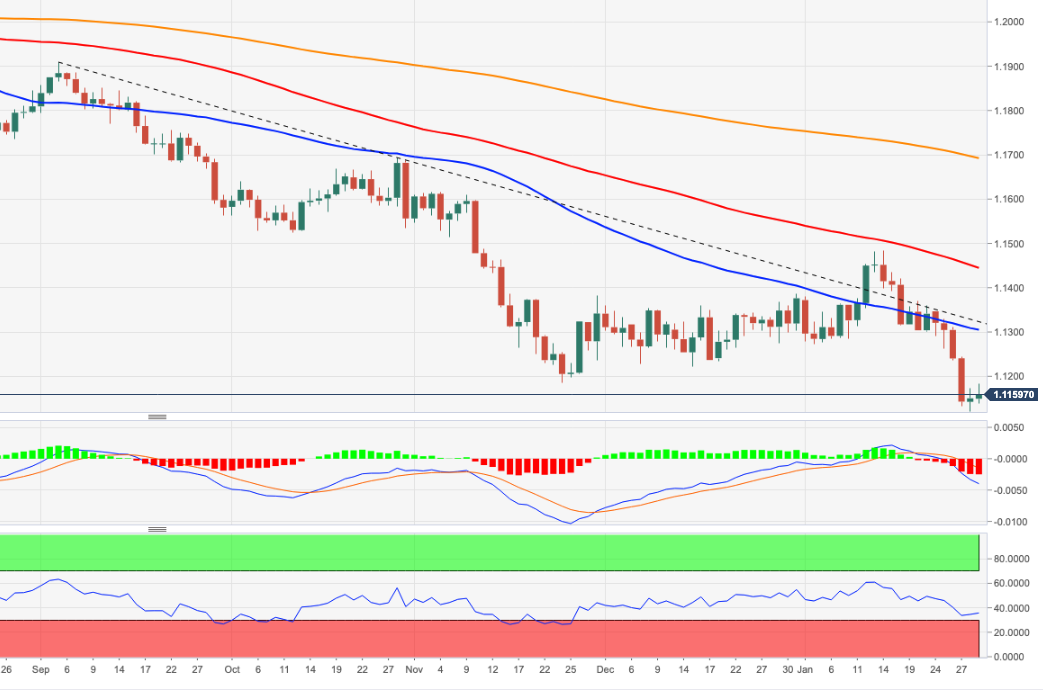
- DXY corrects lower following Friday’s new cycle tops.
- Next on the upside is seen the June 2020 high at 97.80.
DXY meets some selling pressure following the recent tops near 97.50 (January 28).
The intense upside in the dollar quickly left behind the 97.00 barrier and approached the 97.50 level on Friday, always supported by strong fundamentals and amidst a constructive outlook for the time being. That said, the door now remains open to a potential move to the June 2020 peak at 97.80 (June 30) ahead of the round level at 98.00 if the index manages to clear recent tops in the short-term horizon.
In the near term, the upside pressure remains intact while above the 4-month line near 95.50. Looking at the broader picture, the longer-term positive stance in the dollar remains unchanged above the 200-day SMA at 93.38.
DXY charts
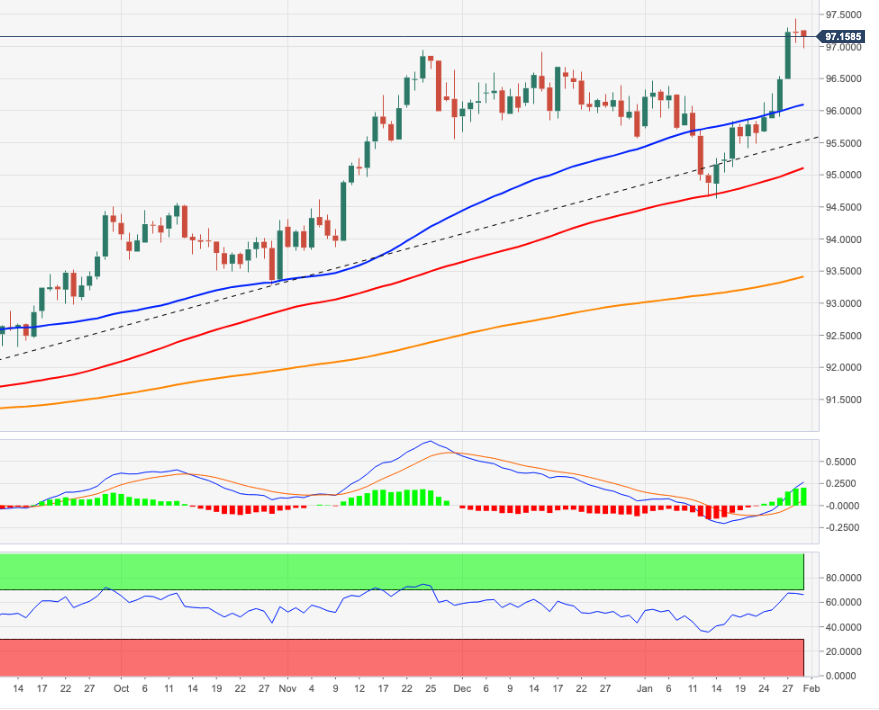
- EUR/JPY manages to stage a decent rebound and retests 129.00.
- Further consolidation seems well in place for the time being.
EUR/JPY reverses two daily pullbacks in a row and briefly surpasses the 129.00 hurdle at the beginning of the week.
In light of the recent price action, the cross seems to have moved into a consolidative phase, with support emerging around 128.20 so far. On the upside, the temporary hurdle at the 55-day SMA at 129.27 keeps capping the upside for the time being. The surpass of the latter could alleviate the downside pressure and allow for a probable move to the more relevant 200-day SMA.
While below the 200-day SMA AT 130.47, the outlook for the cross is expected to remain negative.
EUR/JPY daily chart

- NZD/USD gained some positive traction on Monday and snapped seven days of the losing streak.
- The USD witnessed profit-taking from a 19-month high and extended some support to the major.
- The Fed’s hawkish stance, cautious market mood should help limit USD losses and cap the pair.
The NZD/USD pair maintained its bid tone through the first half of the European session and was last seen trading near the daily high, around the 0.6580 region.
The pair witnessed some short-covering bounce on the first day of a new week amid oversold conditions on the daily chart and snapped seven consecutive days of the losing streak. The uptick allowed the NZD/USD pair to reversed Friday's losses to the lowest level since September 2020 and was sponsored by modest US dollar weakness.
The USD pullback lacked any obvious fundamental catalyst and could be attributed to some profit-taking following the post-FOMC bullish run to a 19-month high. That said, the prospects for a faster policy tightening by the Fed should act as a tailwind for the greenback and keep a lid on any meaningful recovery for the NZD/USD pair.
In fact, the markets have fully priced in an eventual Fed liftoff in March and expect five quarter-point rate hikes by the end of 2022. This was reinforced by elevated US Treasury bond yields, which support prospects for the emergence of some USD dip-buying and warrant caution before placing bullish bets around the NZD/USD pair.
Apart from this, an intraday turnaround in the US equity futures should further lend some support to the safe-haven greenback and cap the perceived riskier kiwi. This, in turn, makes it prudent to wait for a strong follow-through buying in order to confirm that NZD/USD pair has bottomed out and positioned for any further gains.
Market participants now look forward to the US economic docket, highlighting the release of the Chicago PMI. This, along with the US bond yields, will influence the USD price dynamics. Apart from this, traders will take cues from the broader market risk sentiment to grab some short-term opportunities around the NZD/USD pair.
Technical levels to watch
GBP/USD continues to essentially hold the “neckline” to the December base at 1.3376 for now. But the broader risk is seen lower for a retest of medium-term support at 1.3189/35, according to economists at Credit Suisse.
Resistance stays seen at 1.3526
“With the USD expected to strengthen further, we look for a sustained move below 1.3376 in due course to clear the way for further weakness to 1.3296 and eventually a retest of medium-term support at 1.3189/35 – the 38.2% retracement of the 2020/2021 uptrend and 2021 lows. We would look for a fresh floor here. Should weakness extend this would warn of a significant break lower with support seen next at 1.2855/29.”
“Resistance stays seen at 1.3435/36 initially, above which can see strength back to 1.3470, then 1.3492, but with a tactical negative bias maintained whilst below 1.3526.”
EUR/USD is seen at risk of a near-term bounce, but with strength seen as corrective only ahead of an eventual fall to the 1.1019/02 region, economists at Credit Suisse report.
Resistance at 1.1312 ideally caps a rebound
“EUR/USD is seen at risk to a near-term counter-trend rebound. Resistance for a rebound is seen at 1.1186 initially, then 1.1206 with a cluster of levels at 1.1259/72 ideally capping a bounce.”
“We shall maintain an immediate tactical negative outlook whilst below 1.1312.”
“Post a rebound we will look for a resumption of the decline with a break of 1.1115 seeing support next at the ‘measured top objective’ at 1.1075 and then our 1.1019/02 long-held objective – the 78.6% retracement of the 2020/2021 bull trend and top of the base from April/May 2020. We would look for a fresh phase of consolidation to develop from here.”
The Eurozone economy expanded by 0.3% on quarter in the three months to December of 2021, meeting 0.3% expected and 2.3% prior, the preliminary estimate showed on Monday.
On an annualized basis, the bloc’s GDP rate rose by 4.6% in Q4 vs. 3.9% booked in the third quarter of 2021 while missing 4.7% expectations.
FX implications
The euro appears unfazed by the mixed Eurozone GDP report, as EUR/USD remains underpinned by the US dollar’s corrective pullback across the board. The spot is last seen trading at 1.1177, up 0.30% on a daily basis.
About Eurozone Preliminary GDP
The Gross Domestic Product released by Eurostat is a measure of the total value of all goods and services produced by the Eurozone. The GDP is considered as a broad measure of the Eurozone's economic activity and health. Usually, a rising trend has a positive effect on the EUR, while a falling trend is seen as negative (or bearish).
- Gold price recovery eyes $1,800 but sellers refuse to give up yet.
- US dollar corrects from 18-month peak, offers temporary reprieve to gold bulls.
- Gold Price set to test key $1,775 support, as a big week kicks off.
Gold price has kicked off a busy week on a wrong footing, as the Fed’s hawkishness continues to play out strong. Further, the RBA and BOE are expected to deliver a hawkish stance at their monetary policy meetings this week, making the non-interest-bearing gold less appealing. However, bulls are finding some temporary reprieve, courtesy of the corrective pullback in the US dollar alongside the Treasury yields. Looking forward, traders will eagerly await the key central banks’ meetings and the top-tier US economic data for the next direction in gold price.
Read: Forex Today: Dollar bulls take a breather amid a quiet start to a Big week
Gold Price: Key levels to watch
The Technical Confluences Detector shows that the gold price is battling strong resistance around $1,791, where the Fibonacci 61.8% one-day aligns.
The next resistance is seen at $1,796, the SMA100 one-day. A sustained move above the latter will see a test of a dense cluster of healthy resistance levels around $1,800.
That point is the convergence of the pivot point one-day R1, the previous day’s high and Fibonacci 23.6% one-week.
Further up, gold buyers will then aim for a powerful barrier at $1,806, which is the SMA200 one-day.
On the flip side, defending the daily lows of $1,786 is critical for gold bulls, below which a fresh downside could kick in towards the $1,782-$1,780 price zone.
The demand area is the confluence of the previous day’s low, Fibonacci 61.8% one-month and pivot point one-day S1.
The next stop for sellers is seen at the pivot point one-month S1 of $1,779.
Here is how it looks on the tool
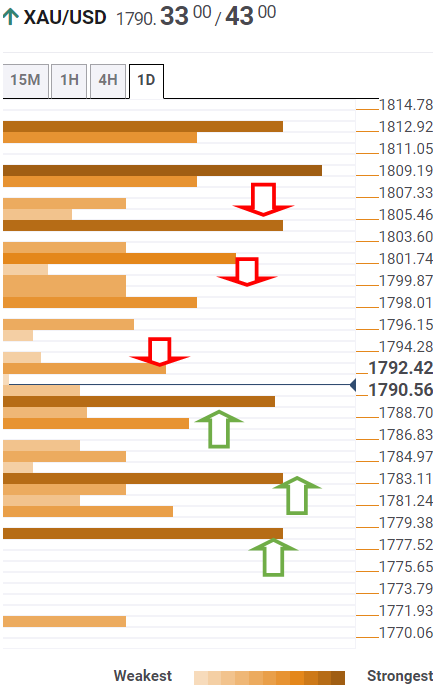
About Technical Confluences Detector
The TCD (Technical Confluences Detector) is a tool to locate and point out those price levels where there is a congestion of indicators, moving averages, Fibonacci levels, Pivot Points, etc. If you are a short-term trader, you will find entry points for counter-trend strategies and hunt a few points at a time. If you are a medium-to-long-term trader, this tool will allow you to know in advance the price levels where a medium-to-long-term trend may stop and rest, where to unwind positions, or where to increase your position size.
- EUR/USD extends the rebound to the 1.1180 area.
- The greenback starts the week in an offered fashion.
- EMU Q4 GDP, German CPI next on tap in the calendar.
The single currency extends the optimism seen at the end of last week and advances for the second session in a row vs. the greenback, managing at the same time to motivate EUR/USD to retest the 1.1180 region at the beginning of the week.
EUR/USD up on risk appetite, dollar losses
The renewed upside mood in the pair appears so far underpinned by the rebound in yields of the German 10y Bund, which in turn motivates another drop in the yield spread differential vs. its US counterpart.
Extra upside in spot comes amidst some profit taking in the buck in light of recent strong gains – including new cycle highs in the US Dollar Index – and the improved sentiment in the risk complex after the Chinese Manufacturing PMI surprised to the upside, albeit marginally, in January.
In the docket, advanced Q4 GDP figures are due for the broader Euroland seconded by Germany flash inflation figures for the month of January. Across the pond, minor data releases include the Chicago PMI seconded by the Dallas Fed Manufacturing Index.
What to look for around EUR
EUR/USD sold off to levels last traded in June 2020 near 1.1120 during a week marked by the solid performance of the greenback, which was in turn exacerbated after the hawkish message from the FOMC event (January 26). Moving forward, the outlook for the pair remains far from rosy, particularly in light of the Fed’s imminent start of the tightening cycle vs. the accommodative-for-longer stance in the ECB, despite the high inflation in the euro area is not giving any things of cooling down for the time being. On another front, the unabated advance of the coronavirus pandemic remains as the exclusive factor to look at when it comes to economic growth prospects and investors’ morale in the region.
Key events in the euro area this week: EMU Advanced Q4 GDP, Germany Preliminary January CPI (Monday) – Germany Retail Sales/Unemployment Rate/Unemployment Change/Final January Manufacturing PMI, EMU Unemployment Rate/Final January Manufacturing PMI (Tuesday) – EMU Flash January CPI (Wednesday) – EMU, Germany Final January Services PMI, ECB Meeting (Thursday) – EMU Retail Sales (Friday).
Eminent issues on the back boiler: Asymmetric economic recovery post-pandemic in the euro area. ECB stance/potential reaction to the persistent elevated inflation in the region. ECB tapering speculation/rate path. Italy elects President of the Republic in late January. Presidential elections in France in April. Geopolitical concerns from the Russia-Ukraine conflict.
EUR/USD levels to watch
So far, spot is gaining 0.18% at 1.1167 and faces the next up barrier at 1.1304 (55-day SMA) seconded by 1.1369 (high Jan.20) and finally 1.1443 (100-day SMA). On the other hand, a break below 1.1121 (2022 low Jan.28) would target 1.1100 (round level) en route to 1.1000 (psychological level).
- GBP/USD extends rebound into the second straight day.
- The US dollar corrects further, undermined by the upbeat mood.
- GBP bulls jump back above 50-DMA, as the focus shifts to the BOE decision.
GBP/USD is looking to build onto Friday’s rebound from five-week lows of 1.3357 reached last Thursday, as the overall upbeat market mood favors the high-beta currency in the pound.
Collaborating with the upswing in the cable, the US dollar eases from one-and-a-half-year highs against its main peers, as investors take profits off the table ahead of the BOE interest rate decision and US payrolls.
The BOE is likely to deliver a second 25-bps post-pandemic rate hike on Thursday, slightly ahead of the Fed in the tightening cycle.
Apart from the BOE outcome this week, markets also remain focussed on the Brexit Freedoms Bill passage and the UK’s political scenario for fresh trading opportunities in GBP/USD.
Looking at GBP/USD’s daily chart, the pair is recovering ground above the horizontal 50-Daily Moving Average (DMA) at 1.3419.
The 14-day Relative Strength Index (RSI) is recovering from lower levels while below the midline, aiding the upturn in the spot.
However, for the rebound to gather steam, the major needs to find acceptance above the January 27 highs of 1.3468.
The next upside target is aligned at the 1.3500 round level.
GBP/USD: Daily chart
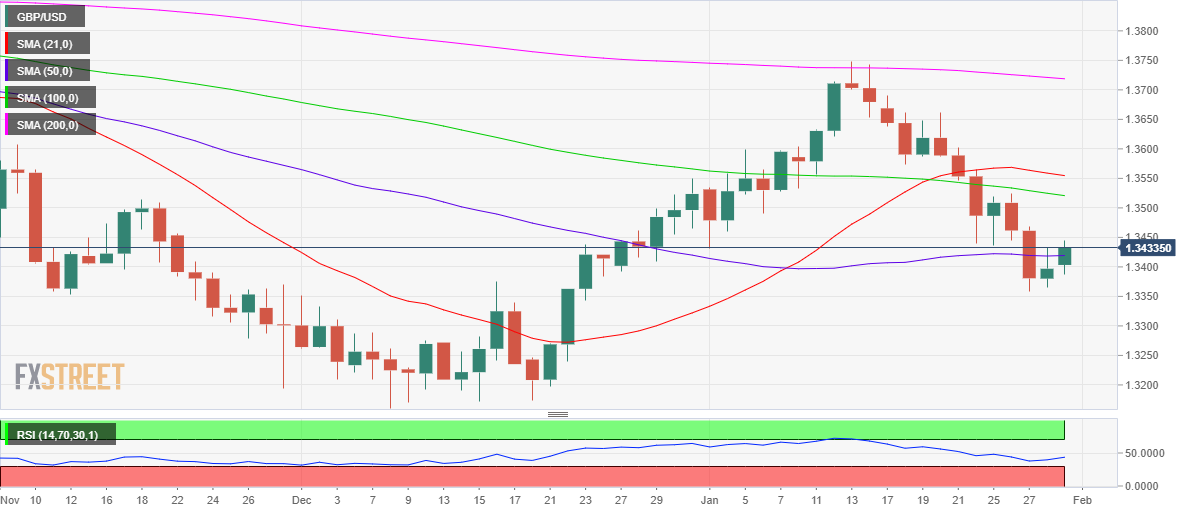
Alternatively, if the bulls fail to yield a daily closing above the 50-DMA hurdle, then the downside momentum could resume towards the intraday lows of 1.3387.
Further south, GBP bears will challenge the bullish commitments at the five-week lows.
GBP/USD: Additional technical levels
- AUD/USD ends a three-day sell-off to recapture 0.7000 and beyond.
- The US dollar retreat remains the may theme amid risk-on mood.
- Impending bear cross caution AUD bulls ahead of the RBA verdict.
AUD/USD has reversed Friday’s drop, as it extends its recovery from 18-month lows of 0.6966 on Monday.
In doing so, the spot has recaptured the 0.7000 barrier, closing in on the 0.7050 psychological hurdle, as the US dollar extends its correction amid a risk-on market profile.
The greenback is paring back the hawkish Fed-led gains, as the Treasury yields turn south in early European trading. The aussie bulls ignore the discouraging Chinese business PMIs released over the weekend, as the sentiment around the US dollar remains in play.
The uptick in the aussie could be associated with the market’s repositioning ahead of Tuesday’s Reserve Bank of Australia’s (RBA) first monetary policy meeting of 2022, where the central bank is widely expected to end the emergency asset purchases.
Technically, AUD/USD is looking to extend the rebound towards 0.7100, backed by the V-shaped recovery in the 14-day Relative Strength Index (RSI).
However, the further upside appears limited, as the RSI still remains below the midline, despite the renewed upside.
Adding credence to the downbeat view, the 21-Daily Moving Average (DMA) is on the verge of cutting the 50-DMA for the downside, which if materializes on a daily closing basis will confirm a bear cross.
If the selling spiral resumes, then the 0.7000 resistance-now-support will get tested again, below which floors will open for a retest of the multi-month troughs.
AUD/USD: Daily chart
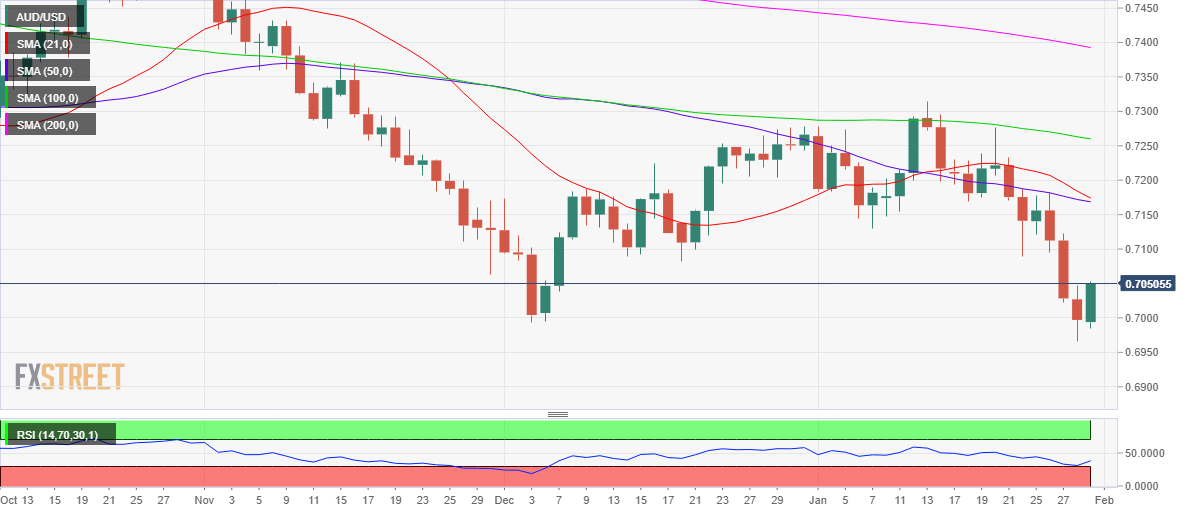
AUD/USD: Additional levels to consider
USD/CAD is trading near its daily low, around the 1.2720 region. Still, economists at Scotiabank believe that the pair should trend higher in the short-term.
CAD needs to crack 1.2645 to improve technically
“We spot USD/CAD resistance at 1.2815 but there is little obvious, additional resistance above there until the 1.2900/50 range.”
“Support is 1.2715 and 1.2645/50 (formerly the bearish breakdown point for what now looks to be an invalidated H&S top).”
“We look for the USD to remain better supported in the short run; the CAD needs to crack 1.2645 to improve technically.”
Since omicron cases spiked in December, fears of slower growth and higher inflation have weighed on equities. Tensions between Russia and Ukraine are exacerbating these concerns. Economists at UBS see three alternative paths for economies and markets.
A bull case seems hard to envisage
“Markets are now pricing in between four and five rate hikes this year, with the first move anticipated in March. In our base case, we do not think this amount of rate hikes would derail economic growth, and we would expect the negative impact of tightening to be more than offset by continued robust earnings. Our base case for the Russia-Ukraine situation is for an eventual stabilization and easing of tensions. In this scenario, we would expect the S&P 500 to finish the year at 5,100.”
“In our bear case, fears about inflation would lead the Fed to increase rates more aggressively than markets currently expect. In this scenario, our downside target for the S&P 500 is 4,100. The situation could be complicated further if an escalation of the Ukraine-Russia crisis were to cause a commodity price shock. If this more extreme scenario – which we think is unlikely – prompted a recession, there could be further downside for equities toward a 3,400-3,700 range for the S&P 500.”
“A bull case seems hard to envisage at such a turbulent time for equity markets, but if inflation starts to retreat, markets could go back to viewing the Fed as flexible and responsive to financial conditions. In this more benign scenario, we would expect the S&P 500 to finish the year at 5,300.”
The US dollar has continued to trade at stronger levels with the US dollar index holding above the 97.000-level for the first time since the middle of 2020. Economists at MUFG expect the greenback to see further gains ahead.
Long US dollar positions are not yet a crowded trade
“Market expectations for the terminal Fed funds rate have remained stable with rates seen peaking at just below 2.00% which would be lower than the peak from the previous tightening cycle of 2.50% despite more elevated upside inflation risks. It still leaves room for US yields to continue to head higher in the near-term and supports for further US dollar strength at the start of this year.”
“The latest IMM positioning report revealed that market participants have been caught out by the latest leg higher for the US dollar. The report highlights that long US dollar positions are not yet a crowded trade and provides further reason why upward momentum can extend further.”
The first reading of the Eurozone fourth-quarter GDP figures is due for release later today at 10:00 GMT. As there are downside risks to this reading, the EUR/USD pair should stall at the key 1.1200 hurdle, economists at ING report.
Thursday's ECB meeting unlikely to provide EUR/USD with much support
“Downside risks to the Eurozone GDP number are possible, given Germany's poor reading, but our team still expects a rebound in the spring or summer. That should be a key theme in helping EUR/USD to build a floor in the 1.08/1.10 area later this year.”
“In the shorter term, the biggest input to EUR this week will be Thursday's ECB meeting. This looks unlikely to provide EUR/USD with much support. And we think today's correction in EUR/USD should be relatively shallow and stall ahead of 1.1200.”
- DXY starts the week on the defensive near the 97.00 zone.
- US yields extend the corrective downside from recent peaks.
- Chicago PMI, Dallas Fed Manufacturing Index come next in the docket.
The US Dollar Index (DXY), which tracks the greenback vs. a bundle of its main competitors, kicks in the trading week near the 97.00 area following the opening bell in Euroland.
US Dollar Index weaker on profit taking, yields
The index comes under some selling pressure following Friday’s new cycle tops near 97.50. The current knee-jerk in the dollar seems to be suffering some profit taking in light of the recent strong gains, while another so far negative performance of US yields also collaborates with the downbeat mood around the buck. Furthermore, the bear flattening of the curve remains well in place, while the closely watched 2y-10y yield spread remained at recent lows around 63 pts at the end of last week.

It is worth recalling that the recent strong inflows into the dollar have been reinforced following the hawkish message from the FOMC event last Wednesday as well as Chair Powell’s indication of an interest rate hike as soon as at the March 16 meeting. Indeed, on the latter and according to CME Group’s FedWatch Tool, the probability of a 25 bps rate hike hovers around 85% and 15% when it comes to a larger 50 bps hike.
Minor releases in the US calendar will see the Chicago PMI and the Dallas Fed Manufacturing Index, both for the month of January.
What to look for around USD
The dollar’s strong march north gathered further steam during last week, particularly in response to the expectations that the Federal Reserve will start its hiking cycle and quantitative tightening in the relatively short-term horizon. Against that, the US Dollar Index (DXY) surpassed the 97.00 barrier quite convincingly and recorded fresh cycle tops near 97.50 (January 28). Furthermore, the constructive outlook for the greenback is expected to remain unchanged for the time being on the back of rising yields, persistent elevated inflation, supportive Fedspeak and the solid pace of the US economic recovery.
Key events in the US this week: ISM Manufacturing, Final Manufacturing PMI (Tuesday) – ADP Employment Change (Wednesday) – Initial Jobless Claims, ISM Non-Manufacturing PMI, Factory Orders (Thursday) – Nonfarm Payrolls, Unemployment Rate (Friday).
Eminent issues on the back boiler: Fed’s rate path this year. US-China trade conflict under the Biden administration. Debt ceiling issues. Escalating geopolitical effervescence vs. Russia and China.
US Dollar Index relevant levels
Now, the index is losing 0.20% at 97.02 and a break above 97.44 (2022 high Jan.28) would open the door to 97.80 (high Jun.30 2020) and finally 98.00 (round level). On the flip side, the next down barrier emerges at 96.08 (55-day SMA) seconded by 95.41 (low Jan.20) and then 94.62 (2022 low Jan.14).
AUD/USD broke heavily below major support at 0.70 on Friday - but has since bounced back. In the view of economists at ING, some temporary calm in Eastern Europe and the Chinese Lunar New Year holidays could make for some better conditions for risk assets, allowing some FX recovery stories to come through – such as the Australian dollar.
Short squeeze pre-RBA?
“A possibly quieter week in terms of geopolitical risk (and US 10 year Treasury yields perhaps more contained) could provide a breather to risk assets and allow some currencies such as the Australian dollar to recover ahead of big event risks such as tomorrow's RBA meeting.”
“We think now the risk is greater of a short squeeze in the run-up to the RBA's event risk tomorrow.”
“Credit data released overnight in Australia showed some very healthy 7% YoY credit growth (albeit business rather than consumer-led) and a change in RBA language and a potential end to QE could send AUD/USD back towards the 0.7080/7100 area.”
Economists at Rabobank expect that USD upside has further to run in the first half of 2022 and maintain a six-month EUR/USD forecast of 1.10, but see potential for the euro to recover some ground in the second half of the year.
USD could struggle in the latter part of 2022
“We retain our bullish outlook for the USD and our forecast of a move to EUR/USD 1.10 by the middle of the year.”
“The money market is currently priced for five 25 bps rate hikes on a one-year view. This may yet prove to be too aggressive an assumption. It is our house view that the Fed will hike four times during the course of 2022. The USD could be subjected to pullbacks if the market reassesses the likely pace of rate hikes.”
“The relative flatness of the US treasury yield curve reflects the market’s view that the tightening cycle the Fed is about to embark upon could be relatively short-lived. This factor could limit upside for the USD in the medium-term.”
The kiwi continued tumbling on Friday and closed just on support at 0.6540 (the 50% Fibonacci retracement of the entire up-move from March 2020). However, the New Zealand dollar could get a helping hand from data and the Reserve Bank of Australia (RBA) this week, economists at ANZ Bank report.
NZD/USD remains above key support at 0.6540
NZD/USD could be in for some consolidation or even a bit of a bounce given the reversal from highs in US bond yields (which was one of the things that gave the USD legs last week), and tentative signs of stability in correlated risk assets like US equities, and with broad commodity indices still buoyant.”
“The kiwi will benefit if HLFS data later this week is strong, and if RBA action tomorrow firms the AUD.”
“Support 0.6470/0.6500/0.6540 – Resistance 0.6700/0.6995.”
- A combination of factors prompted some selling around USD/CAD on Monday.
- Bullish oil prices underpinned the loonie and acted as a tailwind for the major.
- A positive risk tone prompted USD profit-taking and added to the selling bias.
The USD/CAD pair extended its steady intraday descent and dropped to a fresh daily low, around the 1.2720 region heading into the European session.
The pair witnessed some selling on the first day of a new week and extended Friday's late pullback from the vicinity of the 1.2800 mark, or over a three-week high. Crude oil prices held steady near a multi-year high amid concerns about global supply shortages and geopolitical risks. This, in turn, underpinned the commodity-linked loonie and exerted some pressure on the USD/CAD pair.
On the other hand, a positive tone around the equity markets prompted some profit-taking around the safe-haven US dollar and further contributed to the offered tone surrounding the USD/CAD pair. That said, the prospects for a faster policy tightening by the Fed, along with elevated US Treasury bond yields should help limit losses for the buck and the USD/CAD pair, at least for now.
The markets now seem convinced that the Fed will begin raising interest rates in March and have been pricing in the possibility of five quarter-point rate hikes by the end of 2022. Moreover, short-term interest rate futures imply a 20% risk that the first hike could be 50 basis points. Conversely, the Bank of Canada disappointed investors anticipating an imminent start of the tightening cycle.
The fundamental backdrop seems tilted in favour of bullish traders and supports prospects for the emergence of some dip-buying at lower levels. Hence, it will be prudent to wait for a strong follow-through selling before confirming that the USD/CAD pair has topped out and that the recent strong rebound from the mid-1.2400s has run its course. This, in turn, warrants some caution for aggressive bearish traders and positioning for an extension of the intraday depreciating move.
Market participants now look forward to the US economic docket, highlighting the release of the Chicago PMI later during the early North American session. This, along with the US bond yields and the broader market risk sentiment, will influence the USD. Apart from this, oil price dynamics should provide some impetus to the USD/CAD pair and allow traders to grab some short-term opportunities.
Technical levels to watch
Considering preliminary readings from CME Group for natural gas futures markets, open interest added nearly 9K contracts to Thursday’s increase. Volume followed suit and rose for the third session in a row, this time by around 226.8K contracts.
Natural Gas now looks to $5.00 and above
Prices of natural gas extended the rally on Friday amidst rising open interest and volume, leaving the door open to the continuation of the uptrend in the very near term and with the immediate target at the $5.00 mark per MMBtu and beyond, area last traded back in late November 2021.
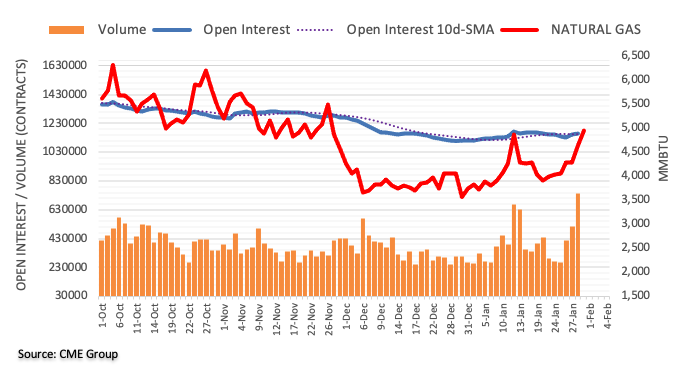
Eurozone Preliminary GDP Overview
The first reading of the Eurozone fourth-quarter GDP figures is due for release later today at 1000 GMT.
The consensus amongst traders expects Eurozone's economic growth rate to rise by 0.3% inter-quarter in Q4 2020 vs. a 2.2% expansion reported in the previous quarter.
On an annualized basis, the bloc’s GDP rate is expected to arrive at 4.7%. vs. 3.9% booked in Q3 2021.
How could it affect EUR/USD?
Upbeat the EZ growth numbers could help accelerate the recovery in the euro. The key hurdle at 1.1200 could be challenged once again. Should the macro data disappoint, the major could resume its downtrend towards 1.1100.
The data release could set the tone for the EUR markets in the session ahead, as the US docket remains devoid of top-tier macros news this Monday.
Looking at it from a technical perspective, “EUR/USD bulls approach a convergence of the last year’s low marked in December 2021 and 61.8% Fibonacci retracement (Fibo.) of the pair’s 2017-18 advances, near 1.1185, as RSI bounces from the oversold territory. If the pair manages to cross the 1.1185 resistance confluence, the corrective pullback could eye the 50-DMA level near 1.1300. Alternatively, a downward sloping trend line from March 2021, near 1.1030, will lure the EUR/USD bears on breaking the recent multi-day bottom around 1.1120.,” FXStreet’s Analyst Anil Panchal notes.
Key notes
Forex Today: Dollar bulls take a breather amid a quiet start to a Big week
EUR/GBP stays pressured near 23-month low as traders await ECB, BOE
About Eurozone Preliminary GDP
The Gross Domestic Product released by the Eurostat is a measure of the total value of all goods and services produced by the Eurozone. The GDP is considered as a broad measure of the Eurozone economic activity and health. Usually, a rising trend has a positive effect on the EUR, while a falling trend is seen as negative (or bearish).
Economists at ING highlight no signs of concern from Japan regarding JPY weakness. As such, they expect USD/JPY to race higher given that no action is set to take place until the pair reaches the 120 level.
No concern from Tokyo
“Clearly there is no panic in Tokyo over USD/JPY back near 116. And we suspect that it would take a fast move to 120 to trigger a little more concern.”
“We know that the JPY has the highest negative correlation with global equity markets. But were some stability to emerge in equities, and US 10-year yields to drive up to the 2.00/2.25% area as we suspect, USD/JPY could start to motor on the upside.”
“As for other currencies, expect the JPY to be interested in the big energy meetings this week, including OPEC+. Brent pushing towards $90/bl – and coal prices rising too – are negative for Japan’s terms of trade and the JPY.”
Gold is licking its wounds below $1,800, slightly off its six-week troughs of $1,780. In the view of FXStreet’s Dhwani Mehta, XAU/USD is set to test key $1,775 support.
RBA and BoE to lean hawkish amid rising inflationary pressures
“The Reserve Bank of Australia (RBA) is set to announce an end to its quantitative easing (QE) program on Tuesday while the Bank of England (BoE) is seen hiking the key rate by 25-bps on ‘Super Thursday’. Hawkish central banks’ outcomes could likely keep gold bulls at bay.”
“If Friday’s low of $1,780 gives way, then a test of the December 16 troughs of $1,776 will be imminent. A sustained move below the latter will open floors towards the $1,750 psychological barrier.”
“On the flip side, bulls will meet the horizontal 100-Daily Moving Average (DMA) initial hurdle at $1,795 on the road to recovery. The next significant barrier is seen at the bearish 50-DMA at $1,801, above which the 200-DMA at $1,806 will act as a strong supply zone. Should the recovery momentum sustain, gold will look out to test the wedge support-turned-resistance at $1,811.”
- EUR/GBP remains on the back foot for the fifth consecutive day.
- Brexit, political optimism in UK joins hopes of BOE rate hike to favor bears.
- Eurozone Q4 GDP, German HICP will direct intraday moves.
- EZ CPI will decorate calendar on Wednesday ahead of Thursday’s ECB, BOE.
EUR/GBP grinds lower around 0.8320, down 0.06% intraday heading into Monday’s European session.
In doing so, the cross-currency pair prints a five-day downtrend while staying near the lowest levels marked since February 2020 before the key monetary policy meetings of the European Central Bank (ECB) and the Bank of England (BOE).
It’s worth noting that the recently stronger data enable market players to stay more hawkish on the BOE than the ECB.
On an intraday basis, EUR/GBP traders await the preliminary readings of the Q4 Eurozone GDP, expected to rise to 4.7% YoY versus 3.9% prior, will precede Germany’s first readings of the Harmonized Index of Consumer Prices (HICP) for January, forecast -0.4% versus +0.3% prior.
Other than the pre-data caution and central bank-linked moves, optimism that UK PM Boris Johnson will stay as the national leader despite the recent allegations over the covid-linked performance also weigh on the EUR/GBP prices. On the same line were hopes of 1 billion pounds ($1.3 billion) of benefits from the Brexit Freedoms Bill that recently reached parliament to tackle Brexit red tape. Furthermore, the UK’s lowest covid cases in seven weeks also help the pair sellers.
Alternatively, recently hawkish comments from the ECB policymakers and inflation fears join geopolitical concerns to keep the EUR/GBP pair buyers hopeful.
Ahead of the BOE, FXStreet’s Yohay Elam said, “A rate hike is priced in, and if the BOE settles for only that action, GBP/USD could suffer a "buy the rumor, sell the fact" retreat. Therefore the pound will probably fall in the unlikely case that the BOE sits on its hands.”
On the other hand, Danske Bank said, “While we do not expect the meeting to bring significant new signals to the market, attention to the elevated inflation and even more data dependence, as well as the difference to Fed, will be in focus.”
Technical analysis
Unless refreshing the monthly high near 0.8422, EUR/GBP remains vulnerable to break the 0.8300 threshold while eyeing lows marked during 2020 and 2019.
CME Group flash data for crude oil futures markets noted traders trimmed their open interest positions for the second straight session on Friday, this time by around 11.4K contracts. Volume, instead, reversed two daily drops in a row and went up by more than 7K contracts.
WTI still targets the $90.00 mark near term
Prices of the WTI charted another inconclusive session at the end of the week amidst diminishing open interest and volume, which could leave the current consolidative stance somewhat unchanged at least in the very near term. In case crude oil resumes the upside, the next target of note remains at the $90.00 mark per barrel.
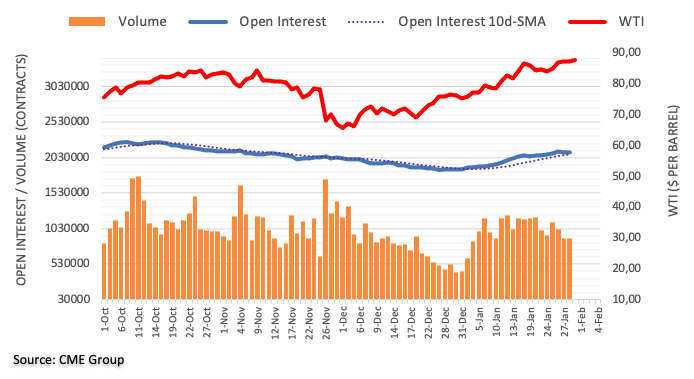
The New Zealand dollar has been hit very hard by the adverse risk environment and dollar strength. But solid prospects of domestic economic data may lift the NZD/USD back to the 0.66/67 area, economists at ING report.
Jobs data could fuel 50bp hike speculation
“NZD is one of those currencies that could look at a faster recovery thanks to strong fundamentals.
“Inflation neared 6% in 4Q, calling for fast RBNZ action, and signs that the jobs market has remained quite tight in the 4Q numbers published this week may allow markets to speculate that the next rate hike (on 23 February) will be a 50bp one.”
“We could see a move back to 0.66/0.67.”
Here is what you need to know on Monday, January 31:
The sentiment on the global markets remains perky following an impressive turnaround on Wall Street last Friday, courtesy of a beat on Apple Inc.’s earnings. Despite the positive mood, thin trading prevails as a bunch of Asian markets, including China, are closed due to the Lunar New Year holiday break. Traders seem to have shrugged off the weak Chinese business PMI for January, which flagged economic slowdown concerns amid surging covid cases in the country.
Investors also pay close attention to the Ukraine crisis, as Russia added more troops around the Ukrainian border. The US and its NATO allies continue to see a likely Russian invasion. US Senators are close to finalizing a deal on legislation to sanction Russia over its actions regarding Ukraine this week.
Meanwhile, a sense of calm prevails ahead of the key central banks’ meetings, comprising the RBA, BOE and ECB, scheduled later this week. Friday will see the critical US Nonfarm Payrolls release.
The US dollar index retreats from the highest level since July 2020 amid reduced demand for safe havens. The US Treasury yields keep the hawkish Fed-led upbeat momentum intact, with the two-year rates spiking above 1.20%.
EUR/USD is bouncing back above 1.1150, although the further upside appears elusive amid firmer yields. The Fed-ECB divergence theme is here to stay. The focus shifts to the Eurozone Preliminary GDP and Germany’s Prelim CPI data.
GBP/USD has recaptured 1.3400 amid a better mood and the dollar’s retreat. The Sue Gray report is yet to be announced but the UK Foreign Secretary Liz Truss says that “the future of the PM is assured.” Meanwhile, Brexit concerns continue to loom, as markets keep their eyes on the Brexit Freedoms, which will introduce new legislation allowing it to change or scrap retained European Union (EU) laws.
USD/JPY is strongly bid around 115.50, as the yen emerges as the weakest in Asia. The spot tracks the Treasury yields higher.
Gold is licking its wounds below $1,800, slightly off its six-week troughs of $1,780. The Russia-Ukraine crisis offers some support to bulls, although the downside appears compelling amid hawkish Fed.
The barrel of West Texas Intermediate (WTI) is heading back towards seven-year highs above the $88 mark amid supply concerns and political tensions in Eastern Europe. Brent oil tops $91.
Bitcoin is down roughly 3% so far this Monday, hovering around $37,000 amid a bearish potential.
Open interest in gold futures markets shrank for the third session in a row on Friday, this time by around 14.1K contracts according to flash data from CME Group. In the same line, volume dropped for the second consecutive session, now by around 164.5K contracts.
Gold looks supported around $1,800
Gold remained under pressure and dropped significantly in past sessions after hitting new peaks past the $1,850 mark per ounce troy (January 25). Friday’s downtick was on the back of shrinking open interest and volume, which could prompt some loss of downside momentum in the yellow metal. That said, the precious metal appears initially supported around the $1,780 region so far.
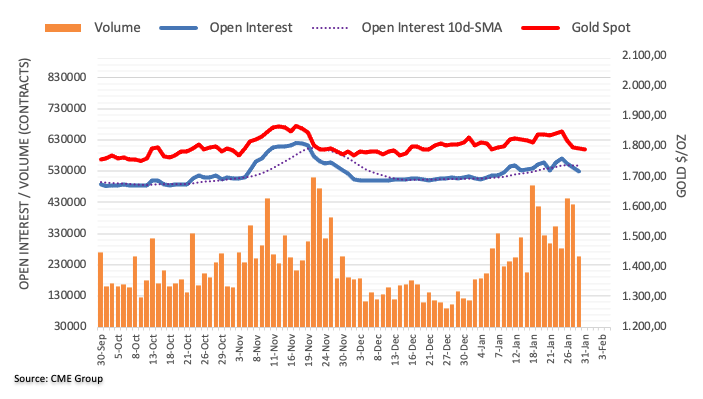
- USD/CHF regained traction on Monday despite a modest USD pullback from a multi-month high.
- A positive risk tone undermined the safe-haven CHF and remained supportive of the move up.
- The fundamental backdrop favours bullish traders and supports prospects for further gains.
The USD/CHF pair maintained its bid tone heading into the European session and was last seen hovering near the daily high, around the 0.9310-0.9315 region.
Following last week's modest pullback from a two-month high, the USD/CHF pair caught fresh bids on Monday and might now be looking to build on its recent strong rally from the 0.9100 mark. The positive move was sponsored by a generally positive tone around the equity markets, which tends to undermine the safe-haven Swiss franc.
On the other hand, the US dollar witnessed some profit-taking and moved away from the highest level since July 2020 touched on Friday. That said, an uptick in the US Treasury bond yields and a more hawkish tone adopted by the Fed should act as a tailwind for the buck. This supports prospects for further gains for the USD/CHF pair.
The Fed indicated last Wednesday that it could raise interest rates at a faster pace than anticipated to contain stubbornly high inflation. The market quickly started pricing in the possibility of five quarter-point rate hikes by the end of 2022 and that the first hike in March could be 50 bps, which, in turn, favours the USD bulls.
Even from a technical perspective, last week's convincing breakthrough the 0.9265-0.9270 resistance zone and the emergence of some dip-buying on Monday add credence to the positive outlook. Hence, a subsequent move back towards the monthly swing high, around the 0.9335-0.9340 region touched last Thursday, remains a distinct possibility.
Market participants now look forward to the release of the Chicago PMI later during the early North American session. This, along with the US bond yields, will influence the USD price dynamics. Traders will also take cues from the broader market risk sentiment to grab some short-term opportunities around the USD/CHF pair.
Technical levels to watch
- GBP/JPY grinds higher around intraday top during five-day uptrend.
- Upper line of the bearish chart pattern, 100-SMA challenge further advances.
- Bears need validation from 154.30 to refresh monthly low.
GBP/JPY takes the bids to refresh intraday top around 155.00, up 0.42% on a day ahead of Monday’s London open.
In doing so, the cross-currency pair battles a short-term rising wedge bearish chart pattern after crossing a two-week-old descending trend line.
It should be noted, however, that the stated wedge’s resistance line limits the quote’s immediate upside around 155.00 even as the MACD signals lure buyers. Also favoring the GBP/JPY buyers past 155.00 is the 100-SMA level of 155.55.
In a case where the quote fails to stay beyond the aforementioned nearby hurdle, pullback moves may initially aim for the previous resistance line near 154.80 before direct GBP/JPY sellers towards the support line of the stated wedge, near 154.30.
If at all GBP/JPY bears conquer the 154.30 key support, the monthly low of 152.90 and early November’s bottom surrounding 152.35-40 will gain the market’s attention.
Overall, GBP/JPY witnesses corrective pullback inside a bearish chart formation and hence bulls have a long way before retaking the controls.
GBP/JPY: Four-hour chart
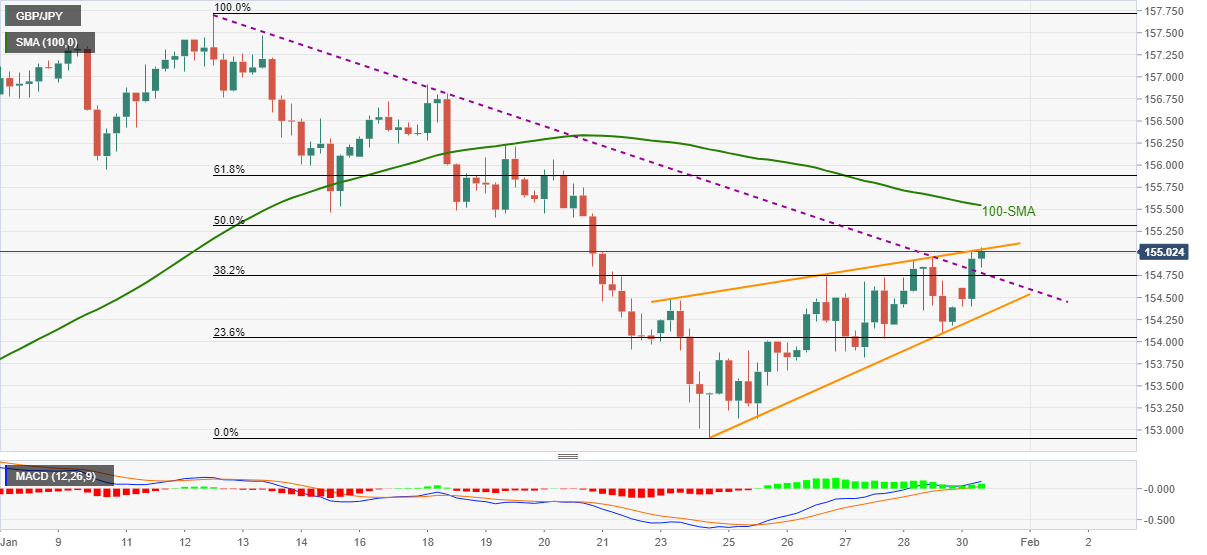
Trend: Pullback expected
These are the main highlights of the CFTC Positioning Report for the week ended on January 25th:
- Speculators reduced both their long and shorts positions in USD, taking the net long position to a 3-week high. The greenback remained side-lined during the week under scrutiny amidst rising concerns surrounding the Russia-Ukraine front while Fed-speakers had already started to signal three or four interest rate hikes by the Federal Reserve this year.
- Gross longs in EUR went up for the sixth consecutive week, lifting the net longs to the highest level since mid-August 2021. Further rangebound in EUR/USD remained in place against the backdrop of alternating risk appetite trends amidst the rate cut by the PBoC, geopolitical effervescence and supportive comments for a sooner-than-expected Fed’s lift-off.
- Net shorts in the Japanese yen retreated to 3-week low following the combination of the corrective move in US yields and some geopolitics-induced risk aversion. That said, USD/JPY eased to as low as the mid-113.00s, where some decent contention turned up.
- The negative stance in the British pound remained well in place after net shorts rose to 2-week highs, as investors continued to fade the December-January rally on the back of domestic political turmoil and the unabated spread of the omicron pandemic.
- Net longs in the Russian ruble dropped to levels last seen in mid-June of last year, all amidst the increasing political effervescence as well as rising rumours of a potential military intervention in Ukraine, at the time when West powers continued to threaten with strong sanctions, both against Russian individuals and companies.
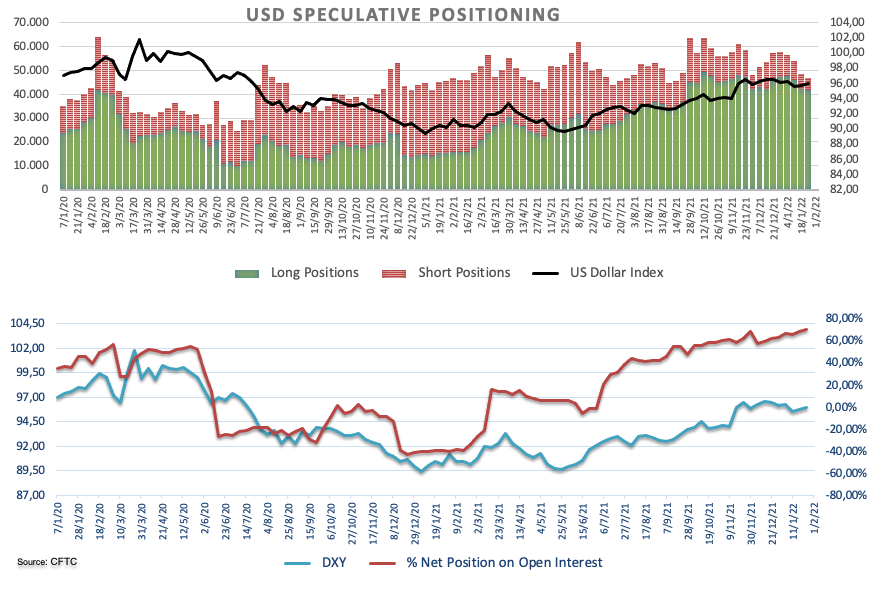
- EUR/USD stretches Friday’s corrective pullback amid US dollar weakness, pre-ECB optimism.
- US Treasury yields remain firmer but indecision over Fed’s rate-hike pace drags greenback amid sluggish start to the crucial week.
- Eurozone Q4 GDP, German HICP for January may test ECB hawks for today but Wednesday’s Eurozone CPI is more important.
- Russian headlines, Fedspeak may also entertain traders before Friday’s US jobs report.
EUR/USD extends Friday’s U-turn from the lowest levels since June 2020, up 0.15% intraday around 1.1165 heading into Monday’s European session.
The major currency pair’s latest recovery could be linked to the US dollar’s pullback from an 18-month top as the market’s brace for Friday’s US jobs report amid mixed signals concerning March’s rate-hike. Adding to the EUR/USD pair’s upside momentum could be the traders’ consolidative performance ahead of the key data/events, as well as amid an absence of China and a light calendar during Monday’s Asian session.
That said, the US Dollar Index (DXY) reversed from the highest levels since July 2020 on Friday, down 0.11% on a day around 97.10 at the latest, after the US Q4 Employment Cost Index (ECI) raises challenges for the Fed policymakers who expect 0.50% rate hikes. Though, strong readings of the Fed’s preferred gauge of inflation, namely Core PCE Price Index for December rose to 4.9%, versus 4.8% forecast and 4.7% prior, keeping the Fed hawks on the table.
Following the US data release, Federal Reserve Bank of Minneapolis President Neel Kashkari said that he expects Fed to raise rates at the March meeting. Though, the policymaker emphasized the importance of incoming data while also saying, “Have to see how data plays out.”
On the same line was Atlanta Fed President Raphael Bostic who said during an interview with the Financial Times (FT), “If the data say that things have evolved in a way that a 50 basis point move is required or [would] be appropriate, then I’m going to lean into that . . . If moving in successive meetings makes sense, I’ll be comfortable with that.”
Elsewhere, the US Senate's aggression towards passing a law to sanction Russia weighs on the risk appetite and probes the EUR/USD bulls.
Against this backdrop, the US Treasury yields print mild gains but stocks in Asia-Pacific and the US stock futures remain steady amid a sluggish start to the key week.
Looking forward, the preliminary readings of the Q4 Eurozone GDP, expected to rise to 4.7% YoY versus 3.9% prior, will precede Germany’s first readings of the Harmonized Index of Consumer Prices (HICP) for January, forecast -0.4% versus +0.3% prior, to direct immediate EUR/USD moves. “The spread of COVID and health restrictions are expected to weigh on Eurozone Q4 GDP growth,” said Westpac ahead of the data release.
It’s worth noting that major attention will be given to Wednesday’s Eurozone Consumer Price Index (CPI) and Thursday’s European Central Bank (ECB) monetary policy meeting.
Read: EUR/USD Weekly Forecast: ECB’s decision and Nonfarm Payrolls take center stage
Technical analysis
EUR/USD bulls approach a convergence of the last year’s low marked in December 2021 and 61.8% Fibonacci retracement (Fibo.) of the pair’s 2017-18 advances, near 1.1185, as RSI bounces from the oversold territory. If the pair manages to cross the 1.1185 resistance confluence, the corrective pullback could eye the 50-DMA level near 1.1300.
Alternatively, a downward sloping trend line from March 2021, near 1.1030, will lure the EUR/USD bears on breaking the recent multi-day bottom around 1.1120.
- A combination of supporting factors assisted USD/JPY to regain some positive traction on Monday.
- A positive risk tone undermined the safe-haven JPY and extended support amid rising US bond yields.
- The onset of some USD profit-taking held back bulls from placing fresh bets and capped the upside.
The USD/JPY pair retreated a few pips from the Asian session high and was last seen trading just below mid-115.00s, still up nearly 0.20% for the day.
Following Friday's pullback from the 115.70 area, or a three-week high, the USD/JPY pair attracted fresh buying on the first day of a new week and was supported by a combination of factors. A recovery in the global risk sentiment – as depicted by a generally positive tone around the equity markets – undermined the safe-haven Japanese yen. Bulls further took cues from an uptick in the US Treasury bond yields, bolstered by a more hawkish tone coming out of the FOMC meeting last week.
It is worth recalling that the Fed indicated last Wednesday that it could raise interest rates at a faster pace than anticipated to contain surging inflation. The market was quick to react and started pricing in the possibility of five quarter-point rate hikes by the end of 2022 and that the first hike in March could be 50 bps. This resulted in the widening of the 2-year US-Japanese government bond yield spread to its highest since late February 2020, which further weighed on the JPY.
That said, the rise in the benchmark 10-year JGB to the highest level since January 2016 helped limit any deeper losses for the domestic currency. Apart from this, modest US dollar profit-taking held back traders from placing aggressive bets and kept a lid on any further gains for the USD/JPY pair, at least for the time being. This makes it prudent to wait for a strong follow-through buying before positioning for an extension of the recent strong rally witnessed over the past one week or so.
Market participants now look forward to the US economic docket, highlighting the release of Chicago PMI later during the early North American session. This, along with the US bond yields, will influence the USD price dynamics and provide some impetus to the USD/JPY pair. Apart from this, traders will further take cues from the broader market risk sentiment to grab some short-term opportunities around the major.
Technical levels to watch
- AUD/USD bounces off 18-month low as traders brace for RBA amid quiet session.
- USD extends Friday’s pullback from July 2020 highs amid indecision over the pace of Fed’s rate hike in March.
- Bulls await clues for the RBA rate hike during 2022, Aussie Private Sector Credit rallied in December.
- NSW announced an AUD1bn package to battle covid, China data came in softer ahead of Lunar New Year holidays.
AUD/USD portrays a corrective pullback near an 18-month low, up 0.25% intraday around the daily high of 0.7018 heading into Monday’s European session.
In doing so, the Aussie pair cheers the US dollar’s weakness, as well as stimulus and upbeat second-tier data from Australia, to snap a three-day downtrend near a multi-day low.
During the weekend, Australia’s largest state by population announced relief measures for small and medium business owners. “The NSW government announced on Sunday an AUD1bn package to support small and medium-sized businesses through the Omicron wave. Payments of up to AUD5,000/week for businesses with revenue between AUD75,000 and AUD50m will start on 1 February,” said ANZ.
Also favoring the AUD/USD rebound is Australia’s December month Private Sector Credit for December, up 0.8% MoM versus 0.5% forecast and 0.9% prior. Furthermore, recently upbeat Inflation and jobs report keep RBA hawks hopeful with the ANZ saying, “(RBA) forecast for wages growth will likely point to a rate hike in the first half of 2023 as being its central case, but Lowe is expected to admit for the first time, in Tuesday’s statement and/or his speech the following day, that a move in 2022 is a possibility if wages growth comes through faster than forecast.”
It’s worth noting that doubts over the pace of the Fed’s rate hike in March and the downbeat Q4 US Employment Cost Index (ECI) could be held responsible for the softer USD. However, upbeat Treasury yields and hawkish comments from the US Fed officials keep AUD/USD bears hopeful.
Federal Reserve Bank of Minneapolis President Neel Kashkari said that he expects Fed to raise rates at the March meeting. Though, the policymaker emphasized the importance of incoming data while also saying, “Have to see how data plays out.”
On the same line was Raphael Bostic, President of the Fed’s Atlanta branch who reiterated his call for three Fed rate lifts in 2022 in an interview with the Financial Times (FT), with the first coming in March. “If the data say that things have evolved in a way that a 50 basis point move is required or [would] be appropriate, then I’m going to lean into that . . . If moving in successive meetings makes sense, I’ll be comfortable with that,” said Fed’s Bostic per FT.
Amid these plays, the US Treasury yields print mild gains but stocks in Asia-Pacific and the US stock futures remain steady amid a sluggish start to the key week.
On a different page, China’s week-long holidays may test AUD/USD pair traders. It should be observed that Beijing’s official PMI data eased for January, per the preliminary readings flashed during the weekend.
That said, a light calendar on Monday will add to the momentum traders’ hardships during the pre-RBA cautious mood.
Technical analysis
Although an upside break of December 2021 low near 0.6995 favors the AUD/USD pair’s corrective pullback towards 0.7080, the August 2021 bottom surrounding 0.7105 will be crucial for the bulls.
Alternatively, a five-month-old descending trend line near 0.6930 will challenge the quote’s further downside.
- Asia-Pacific shares grind higher as investors await key data/events amid off in regional major China.
- Japan PM Kishida rejects rumors over covid-linked state of emergency.
- China official PMIs came in softer for January before the Lunar New Year festivities began.
Asian equities begin the key week on a slightly positive tone despite China’s holidays and a light calendar. It’s worth noting that the market’s consolidation also ignores firmer US Treasury yields and covid fears in Japan.
While portraying the mood, the MSCI index of Asia-Pacific shares ex-Japan rises 0.70% intraday whereas Japan’s Nikkei 225 rises over 1.20% heading into Monday’s European session.
The record top covid numbers in Tokyo earlier raised speculations that Japan will be forced to announce the second virus-linked state of emergency. However, the Japanese Prime Minister (PM) Fumio Kishida recently rejected those fears while citing no such consideration on hand. Also favoring Japanese equity traders could be the comments from Japan Cabinet Secretary Matsuno who said, “Not appropriate to unfreeze program that would temporarily suspend taxation on gasoline.”
Furthermore, softer prints of Japan’s December month Industrial Production and Retail Trade also favored the equities.
Elsewhere, Australia’s ASX 200 prints mild losses whereas New Zealand’s NZX 50 rises 0.80% amid mixed concerns over the covid woes at respective ends.
It should be noted that stocks in Hong Kong, South Korea and India rise over 1.0% whereas Indonesian markets print sluggish moves of late.
On a broader front, the US 10-year Treasury yields stay firmer around 1.79% whereas the 2-year counterpart rises past 1.2% at the latest.
Moving on, preliminary readings of Eurozone Q4 GDP and Germany’s key inflation data, namely the Harmonized Index of Consumer Prices for January will be crucial for intraday direction. However, major attention will be given to Friday’s US NFP as Fed hawks struggle to justify a 0.50% rate hike after downbeat prints of the US Q4 Employment Cost Index (ECI).
Talking about commodities, oil prices stay firmer around the multi-day top on geopolitical concerns ahead of the OPEC+ meeting whereas gold drops for the fourth consecutive day even as the US dollar extends Friday’s pullback.
Read: Gold Price Forecast: XAU/USD bears eye $1,753 despite softer USD
- Gold remains on the back foot for fourth consecutive day, keeps downside break of 100-DMA previous support from August.
- Market sentiment dwindles amid indecision over the pace of Fed’s March rate hike after Friday’s US Employment Cost Index.
- US Treasury yields fail to recall USD buyers amid a sluggish start to the NFP week.
- Gold Weekly Forecast: XAU/USD poised for further losses on Fed's hawkish stance
Gold (XAU/USD) prices drop for the fourth day in a row, refreshing intraday bottom around $1,786 heading into Monday’s European session.
In doing so, the yellow metal fails to cheer the US dollar pullback as the US Treasury yields stay firmer and stock futures fail to extend Friday’s rebound.
The reason could be linked to the market’s indecision ahead of the March month Federal Reserve (Fed) meeting, as well as this week’s US jobs report. It should be noted that the geopolitical fears surrounding Russia add to the risk-off mood and drown gold prices to justify the technically bearish confirmation.
the US Dollar Index (DXY) tracks downbeat Treasury yields to extend Friday’s pullback from the highest levels since July 2020. Behind the moves could be the market’s indecision over the pace of the Fed’s rate hike in March after the recently downbeat wage price data.
Although the Fed’s hawkish halt drowned gold prices the last week, the US Q4 Employment Cost Index (ECI) raises challenges for the Fed policymakers who expect 0.50% rate hikes. Though, strong readings of the Fed’s preferred gauge of inflation, namely Core PCE Price Index for December rose to 4.9%, versus 4.8% forecast and 4.7% prior, keeping the Fed hawks on the table.
Following the US data release, Federal Reserve Bank of Minneapolis President Neel Kashkari said that he expects Fed to raise rates at the March meeting. Though, the policymaker emphasized the importance of incoming data while also saying, “Have to see how data plays out.”
On the same line was Raphael Bostic, President of the Fed’s Atlanta branch who reiterated his call for three Fed rate lifts in 2022 in an interview with the Financial Times (FT), with the first coming in March. “If the data say that things have evolved in a way that a 50 basis point move is required or [would] be appropriate, then I’m going to lean into that . . . If moving in successive meetings makes sense, I’ll be comfortable with that,” said Fed’s Bostic per FT.
Elsewhere, the US Senate's aggression towards passing a law to levy economic sanctions on Russia also weighs on the risk appetite. “US senators are very close to reaching a deal on legislation to sanction Russia over its actions on Ukraine, including some measures that may take effect before any invasion, two leading senators said on Sunday,” said Reuters.
Moving on, a light calendar on Monday may challenge gold traders but major attention will be given to Friday’s US jobs report, as well as Treasury yields for fresh impulse.
Technical analysis
Gold prices stay below the $1,795-96 resistance confluence, including 100-DMA and an ascending trend line from August, while portraying a four-day downtrend of late.
The metal’s declines also take clues from bearish MACD signals and downbeat RSI, not oversold.
As a result, the 61.8% Fibonacci retracement (Fibo.) of April-June 2021 upside, near $1,770, can act as immediate support to watch for the gold sellers.
Following that, December’s bottom surrounding $1,753 will be crucial as it holds the key to the quote’s further downside towards September’s low of $1,721.
Alternatively, a daily closing beyond $1,796 will need validation from the $1,800 threshold to again aim for the yearly resistance line, around $1,845.
Even if the gold buyers manage to cross the $1,845 resistance, the monthly high near $1,853 will be crucial for the metal’s further upside.
Gold: Daily chart
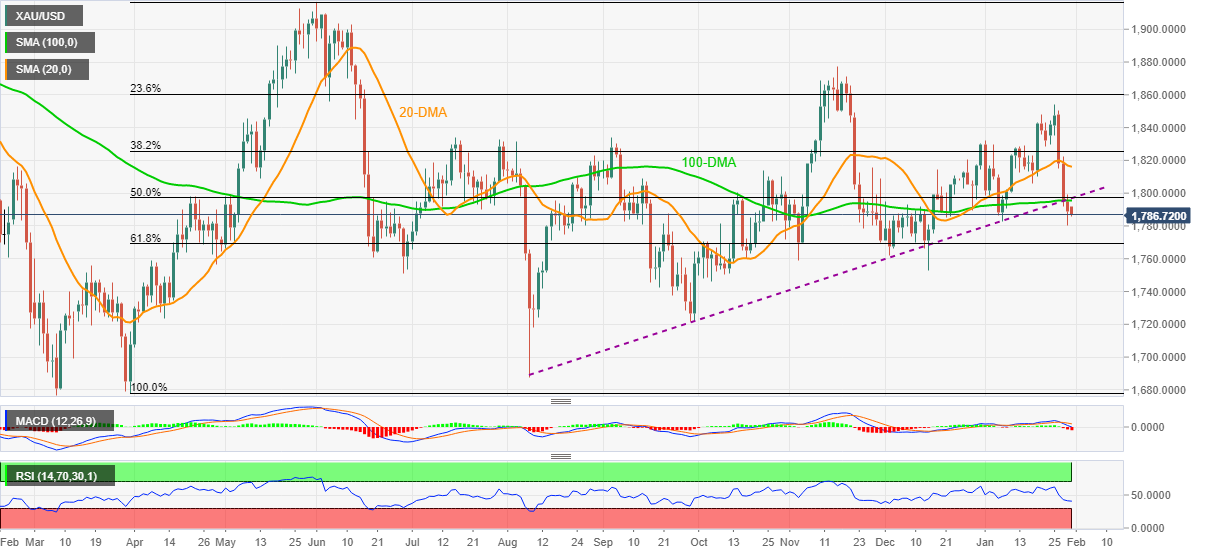
Trend: Further weakness expected
- USD/CAD snaps three-day uptrend, refreshes intraday low amid sluggish session.
- Failures to cross two-month-old horizontal hurdle battles bullish MACD above 50-DMA to keep buyers hopeful.
- 50-% Fibonacci retracement, 200-DMA act as strong supports, multiple tops marked during late 2021 guard immediate upside.
USD/CAD consolidates recent losses around 1.2735, down 0.30% intraday while reversing from a three-week high on early Monday morning in Europe.
In doing so, the Loonie pair takes a U-turn from a two-month-old horizontal area around 1.2780-85 but bullish MACD signals keep sellers unconvinced around the 50-DMA level of 1.2715.
Even if the USD/CAD bears manage to conquer the 1.2715 level, 50% Fibonacci retracement (Fibo.) of October-December advances, near 1.2630, will be in focus as a break of which will direct the pair towards the 200-DMA level of 1.2507.
On the contrary, a clear upside break of 1.2785 immediate hurdle will need validation from the monthly high of 1.2813 to recall the USD/CAD bulls.
Following that, multiple tops marked during late 2021 around 1.2850 and 1.2900 will challenge the pair buyers before directing them to the year 2021 peak of 1.2964.
Overall, USD/CAD bulls take a breather amid a sluggish start to the crucial week.
USD/CAD: Daily chart
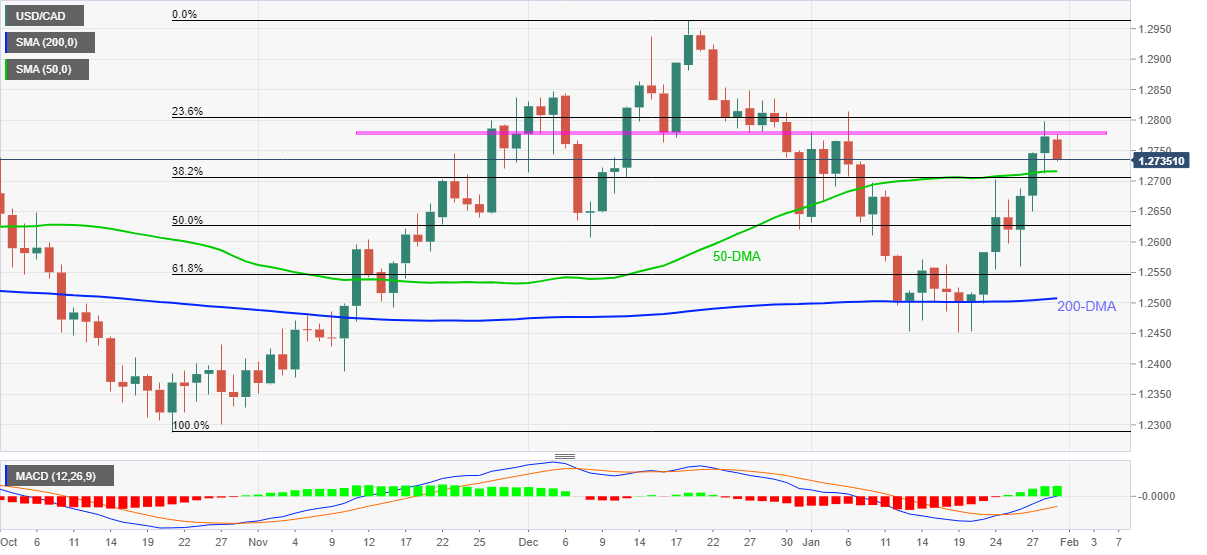
Trend: Further weakness expected
- GBP/USD extends Friday’s corrective pullback from five-week low.
- UK Foreign Secretary Truss hints at PM Johnson’s job safety despite ‘Partygate’ issue.
- Devolved administrations criticize Brexit Freedoms Bill despite claims to cut £1 billion of red tape.
- US Treasury yields drown USD amid a quiet start to the key week.
GBP/USD picks up bids to refresh intraday high near 1.3415, up 0.11% on a day as markets cheer USD pullback during a sluggish start to a crucial week. Also favoring the cable buyers could be the political optimism in the UK.
Although Sue Gray report is yet to be announced, Bloomberg quotes Foreign Secretary Liz Truss as saying, “The future of the PM is assured,” The news relied on the BBC interview also mentions UK’s Truss as saying, “He’s doing an excellent job on the things that matter -- recovering the economy from Covid, getting Brexit done, getting this country going again.”It should be observed that the official report on the covid-linked allegations over UK PM Johnson has been delayed by over two days as the police investigate the matter.
Elsewhere, UK PM Johnson praises Brexit Freedom Bill ahead of its official passage even as devolved governments in Welsh, Scotland and Northern Ireland criticize the plan. “Legislation building on Britain’s exit from the EU would make it easier to amend or remove statutes that remain on U.K. books, a measure that will help the government strip away regulations costing businesses 1 billion pounds ($1.3 billion), Johnson’s office said in a statement released Monday,” said Bloomberg.
On a different page, “UK reports the lowest number of daily COVID cases since 14 December,” per Sky News.
Alternatively, the US Dollar Index (DXY) tracks downbeat Treasury yields to extend Friday’s pullback from the highest levels since July 2020. Behind the moves could be the market’s indecision over the pace of the Fed’s rate hike in March after the recently downbeat wage price data.
On Friday, markets raised doubts on the Fed’s hawkish action in March following softer prints of the US Q4 Employment Cost Index (ECI). However, strong readings of the Fed’s preferred gauge of inflation, namely Core PCE Price Index for December rose to 4.9%, versus 4.8% forecast and 4.7% prior, keeping the Fed hawks on the table.
Following the US data release, Federal Reserve Bank of Minneapolis President Neel Kashkari said that he expects Fed to raise rates at the March meeting. Though, the policymaker emphasized the importance of incoming data while also saying, “Have to see how data plays out.”
On the same line was Raphael Bostic, president of the Fed’s Atlanta branch who reiterated his call for three Fed rate lifts in 2022, in an interview with the Financial Times (FT), with the first coming in March. “If the data say that things have evolved in a way that a 50 basis point move is required or [would] be appropriate, then I’m going to lean into that . . . If moving in successive meetings makes sense, I’ll be comfortable with that,” said Fed’s Bostic per FT.
Looking forward, developments surrounding Brexit and UK politics may entertain GBP/USD traders. However, major attention will be given to the Bank of England (BOE) rate hike concerns after recently upbeat British statistics.
Technical analysis
Sustained bounce from the 61.8% Fibonacci retracement (Fibo.) level of December-January upside, near 1.3385, needs to overcome the 50-DMA and a 12-day-old resistance line, respectively around 1.3420 and 1.3445, to convince GBP/USD buyers.
- AUD/JPY bears are moving the price to the edge of the abyss.
- 78.50 is a focus for days ahead so long as bears commit below 81 the figure.
The markets are trying to stabilise yet there are plenty of risks weighted to the downside for the cross. the technical outlook, as illustrated below, offers a compelling bearish bias while the price tests critical weekly territories.
AUD/JPY weekly chart
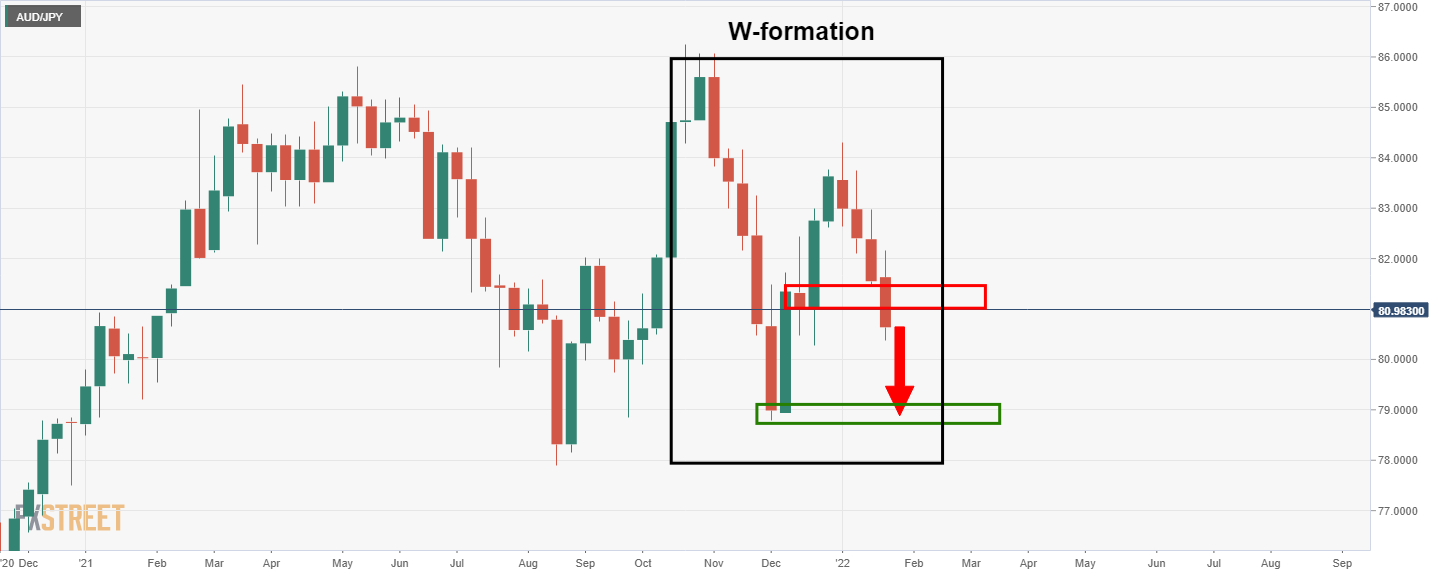
The move and close below the close of the neckline's candle, 81.01, was a significant move last week and leaves a bearish bias for the week ahead.
AUD/JPY daily chart
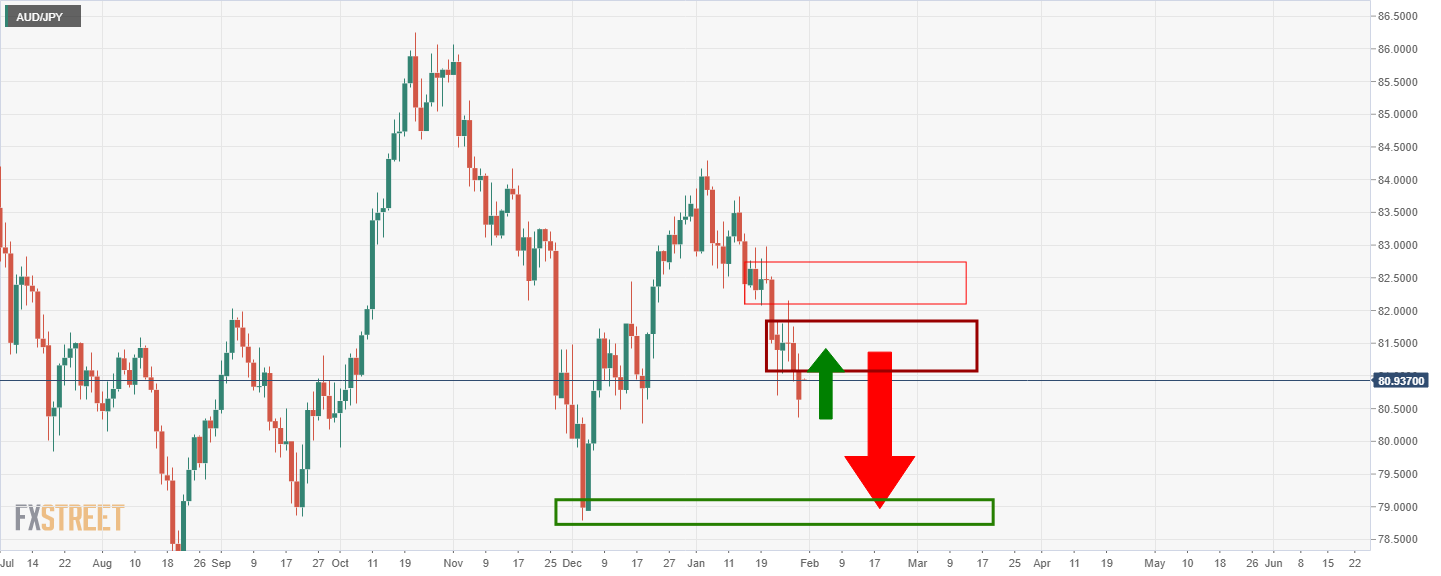
The daily chart's path of least resistance appears to be to the downside as well. There are two solid resistance structures that the bulls will need to overcome. The bears, on the other hand, are pushing the price to the edge of the abyss where 78.50 comes into reach for the days ahead.
The Goldman Sachs economists predict three interest rate hikes by the Bank of England (BOE) this year, which would mark the quickest tightening in 25 years.
Key quotes
“We now expect the BOE to hike in back-to-back meetings through May, in order to demonstrate to markets and businesses that the MPC is serious about the inflation target, and will act to ensure the U.K. does not face the risk of a wage-price spiral.”
“We expect the BOE to announce a fixed and gradual schedule of asset sales to begin in the summer, after hitting the stated 1% threshold in May.”
“While highly uncertain, we are expecting asset sales of around 20 billion pounds ($26.8 billion) per quarter.”
- It is a big week for the single currency and US dollar with plenty on the events calendar to rock the apple cart.
- The ECB and NFP will be the highlights as markets trade the central bank divergence theme.
EUR/USD is up slightly at the start of the week, trading 0.10% higher at the time of writing. The bulls are engaging at a critical support level on the charts, as illustrated below. Meanwhile, the dollar stays near a year-and-a-half high against the euro with equities markets volatility expected to underpin the greenback on a very busy schedule for the week ahead.
The markets will eye the upcoming Australian, UK and European central bank meetings as the key events while continuing to price the Federal reserve's hawkish dominance into the market. This has been supporting the dollar index (DXY), which measures the greenback against six major peers in the 97.00 areas. Friday's 18-month top of 97.441 was a critical milestone that has set the scene for the week ahead.
The greenback had its best week in seven months last week supported by investors seeking safety amid a sell-off in riskier assets. With the market pricing more than 90% chance of at least four rate hikes by the end of the year and a 67% chance of at least five, the greenback remains underpinned.
However, the data this week could rock the apple cart. US payroll figures are out on Friday. ''Consensus sees 150k jobs added vs. 199k in December, while the Unemployment Rate is seen steady at 3.9% and average hourly earnings are seen picking up to 5.2% YoY from 4.7% in December,'' analysts at Brown Brothers Harriman said.
Other key events for the US will include the ADP report that provides its private-sector jobs estimate Wednesday, with consensus at 200k vs. 807k in December.
The analysts also noted that the December JOLTS job openings will be reported Tuesday saying that 10.3 mln are expected and explained that this should help round out the labor market picture. ''Barring a complete collapse in the economy, the Fed is going on the assumption that we are nearing full employment and will continue to tighten until the data warrant a pause.''
Meanwhile, the European Central Bank also has a policy meeting Thursday. The central bank is on cruise control, at least for the first half of 2002, but analysts are starting to warn that approaching rate hikes from the Fed will shrink the ECB's window for action.
''The ECB is in cruise control for 2022H1, and we expect little change in messaging at this week's policy decision, especially as no new forecasts will be released,'' analysts at TD Securities explained.
''President Lagarde is likely to emphasise policy flexibility during the press conference, but re-iterate that a 2022 rate hike is highly unlikely. Views on energy prices and inflation expectations will be key,'' the analysts added.
EUR/USD technical analysis
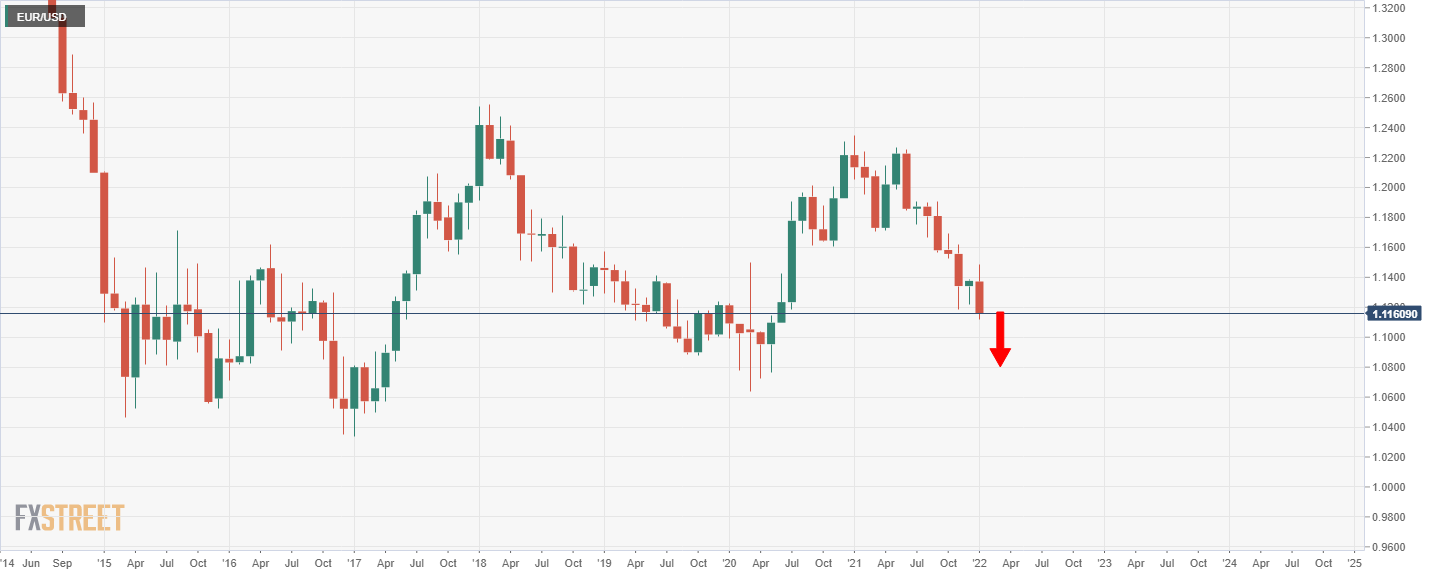
The bears are in control from a monthly perspective as January comes to a bearish close.

EUR/USD weekly charts
However, the price has run into a wall of weekly support at this juncture and if the bears do not commit this week to push the price further lower, then the upside will be compelling for next week.
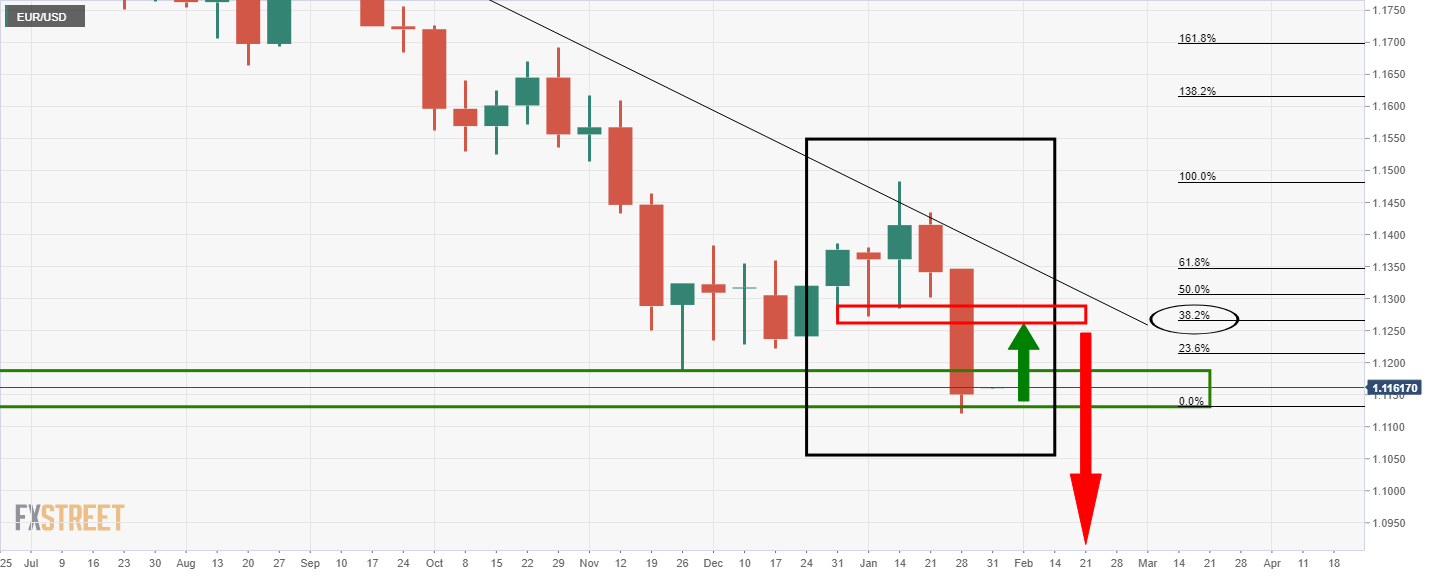
The M-formation is a reversion pattern that has a high completion rate in that the price would be expected to be drawn to the neckline of the M. In this case, it has a confluence with the 38.2% Fibonacci area near 1.1305.
EUR/USD daily chart
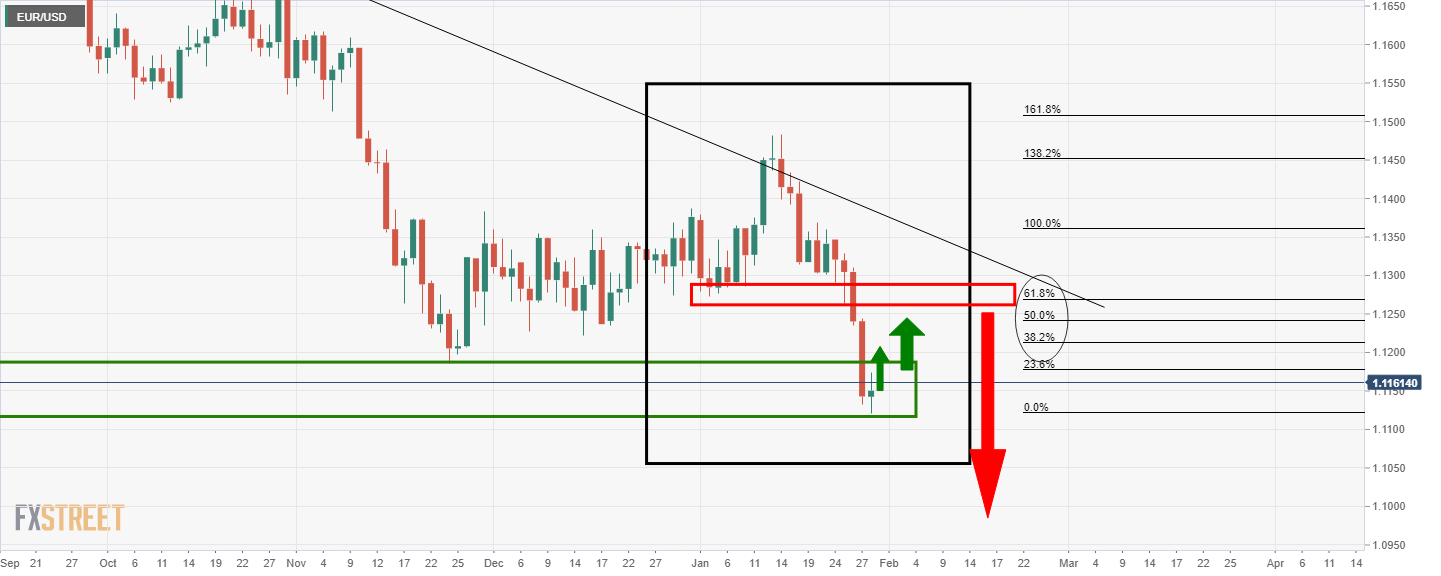
From a daily perspective, the Fibonacci scale of ratios is a focus leading into the prior supporting structure near 1.1250.
In an interview with the Financial Times (FT) on Sunday, Atlanta Federal Reserve (Fed) President Raphael Bostic said he could lean towards a 50-basis point (bps) rate hike, depending on the economic data.
Key quotes
Every option is on the table for every meeting.
If the data say that things have evolved in a way that a 50-basis point move is required or [would [ be appropriate, then I am going to lean into that.
Comfortable with moving in successive meetings.
Sticks to 3 rate increases in 2022 with the first in March.
Will be looking for deceleration in monthly CPI price gains.
Looking for further evidence that rising wages are not feeding meaningfully into higher inflation.
Encouraged by latest employment cost index and expects a moderation in wage growth going forward.
Markets are acting rationally and responding with tighter financial markets.
Supports reducing the $9T balance sheet as quickly as possible without impairing market functioning.
Optimistic on the economy.
If we do three hikes, that'll still leave our policy in a very accomodative space.
Market implications
The US dollar is on a corrective move lower after the recent upsurge. Bulls take a breather ahead of key central bank meetings and the US NFP release.
The US dollar index is currently trading at 97.18, down 0.10% on the day, having hit multi-month highs at 97.44 on Friday.
Bank of America (BofA) Chief Economist Ethan Harris remains overtly hawkish on the Fed’s outlook, expecting seven rate hikes this year.
Key quotes
"We point out that markets have underpriced Fed hikes at the start of the last two hiking cycles and we think that will be the case again.”
"Starting in March, we expect the Fed to start raising rates by 25bp at every remaining meeting this year for a total of seven hikes, with four more hikes next year.”
"This would take the terminal rate to 2.75-3.00% by the end of 2023, which should slow down growth and inflation."
- NZD/USD leads G10 gainers while snapping seven-day downtrend around 16-month low.
- Bullish MACD signals back descending trend channel breakout to underpin corrective pullback.
- Previous support line from mid-January, 100-HMA restricts nearby advances.
NZD/USD takes the bids to refresh intraday high around 0.6562, up 0.26% on a day while consolidating the recent losses around multi-day low during early Monday.
The pair’s recent corrective pullback takes clues from a clear upside break of a three-day-old descending trend channel, as well as the firmer MACD signals.
Even so, the previous support line from January 14, around 0.6595, precedes the 100-HMA level of 0.6628, challenging the NZD/USD bulls.
On the contrary, pullback moves may initially aim for the stated channel’s upper line, near 0.6545, before eyeing the recent multi-day bottom of 0.6532.
Also likely to challenge the NZD/USD bears is the channel’s support line and the 50% Fibonacci retracement (Fibo.) of March 2020 to February 2021 upside, respectively around 0.6500 and 0.6465.
NZD/USD: Hourly chart
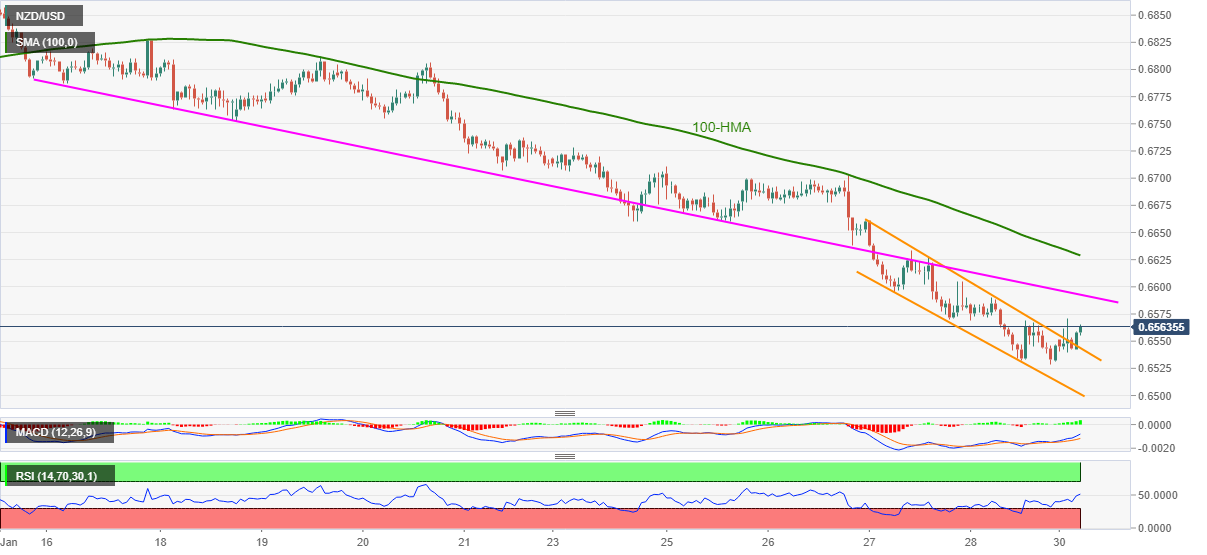
Trend: Further recovery expected
| Raw materials | Closed | Change, % |
|---|---|---|
| Brent | 88.83 | 0.32 |
| Silver | 22.405 | -1.69 |
| Gold | 1789.283 | -0.45 |
| Palladium | 2375.14 | 0.33 |
- WTI prints five-day uptrend near seven-year high, seesaws around daily top of late.
- OPEC+ is likely to keep production hike targets on the table but geopolitical tensions test the output promises.
- US Senate eyes law to levy sanctions on Russia even before Ukraine invasion, NATO raises concerns over European energy supplies.
- Off in China, no major data on Monday restricts oil moves.
WTI remains on the front foot around $87.30, up 0.76% intraday with the latest grind surrounding the daily top.
Although the black gold remains firmer around the highest levels since October 2014, an absence of Chinese traders and cautious sentiment ahead of the OPEC+ verdict, up for publishing on Wednesday, seem to challenge the quote’s recent moves. That said, OPEC+ is a group of the Organization of the Petroleum Exporting Countries (OPEC) and its allies led by Russia.
Oil bulls recently cheered the escalation in the geopolitical risks between Ukraine and Russia as Western policymakers tried hard to stop Moscow from war but gained no positive response. As a result, the US Senate braces for a law to levy economic sanctions on Russia while the North Atlantic Treaty Organization (NATO) said on Sunday, per Reuters, that Europe needs to diversify its energy supplies as Britain warned it was "highly likely" that Russia was looking to invade Ukraine.
On the same line is the OPEC+ inability to match the output hike targets of the 400,000 barrels per day (BPD) due to capacity constraints.
It’s worth noting that the escalating inflation fears and firmer US dollar also challenge oil buyers at the multi-month top.
Amid these plays, the benchmark US 10-year Treasury yields rose 1.6 basis points (bps) to 1.796% whereas the S&P 500 Futures drop 0.30% intraday at the latest. It should be noted that off in China restricts Asia-Pacific market moves of late.
Moving on, oil traders will keep their eyes on Russia-linked headlines for intermediate moves ahead of Wednesday’s OPEC+ decision. Also important will be Friday’s US monthly jobs report as the Fed rate hike concerns probe oil buyers, despite recently failing to do so.
Technical analysis
Although overbought RSI conditions test WTI bulls below the $90.00 threshold, the year 2021 high near $85.00 puts a floor on the commodity’s pullback moves.
The Globe & mail last Friday published remarks from the Bank of Canada's governor Tiff Macklem made in an interview on Wednesday, Jan 26 following the central bank's decision to hold on rates.
"I'm not comfortable with where inflation is, but I don't regret the actions we took," the news agency reported him saying to them.
Key comments
"Interest rates very clearly have to go up to dampen spending and bring demand in line with supply," Mr. Macklem told The Globe.
"I think that deliberate approach where we are clear with Canadians on how we see things and what we think needs to happen has been very helpful through this crisis," Mr. Macklem said.
"We're starting at ultralow. And it's clear we need to move up. At first, I think the implications are fairly obvious for interest rates. The further down the path you get, the more finely balanced those decisions will become, the more data-dependent they will become," Mr. Macklem said, seeming to suggest the first few hikes could happen soon.
"I have a lot of time for the argument that the bank wanted to put distance between rate hikes and the Omicron lockdown, and I don't think it's likely that there will be much, if any, damage done to their credibility by waiting the five weeks," Mr. Kelvin said in an interview.
"But waiting until April, given where inflation is, it does start to run the risk of inflation expectations becoming unanchored, which would make the bank's task going forward far more difficult."
"By inflaming the housing market side of the picture, the combined effects of hot inflation and hot asset prices I worry could be destabilizing to the economy and the financial system over time," Mr. Holt said in an interview.
"If you're Canadian and you have a variable rate mortgage, we're effectively telling you that you can expect that variable rate mortgage is going to go up," he said.
"It's also important to remember that the federal mortgage stress test, while very helpful for lenders to gauge whether a household could handle higher mortgage rates, doesn't provide a certificate of perfect financial health," Mr. Beaudry said.
"Whether a household could withstand higher rates without slashing other spending depends on how well it manages its finances overall before rates rise," he said.
"We think it would be healthy to see some gradual slowing in the housing market. We can't sustain the kind of strength in housing we've seen. I think that would be a good thing, not a bad thing," Mr. Macklem said.
"I've learned this now a few times in my career," he said. "I remember this after 9/11; I remember after the global financial crisis. We lowered interest rates and people said, 'Well, this is a terrorist attack, monetary policy is not going to work. This is a financial crisis, monetary policy is not going to work. This is a pandemic, monetary policy is not going to work.' Well, it works.
"It worked on the downside," he said. "It's going to work on the upside."
Market implications
The comments from last week will have already started to have made their way through to the price, although they may get some more traction this week as sentiment shifts to central banks again. The Reserve Bank of Australia, the European Central Bank and the Bank of England are all slated for the week ahead. Hawkish tones all around will likely cement the prospect of a 50bp at the BoC which would be expected to underpin the loonie. Meanwhile, the focus will be on January jobs data in Canada this week, which will offer traders the opportunity to measure the impact of Omicron restrictions in the country.
The tensions over a possible Russian invasion of Ukraine still remain alive, in the face of the latest news that Russia added more troops around the Ukrainian border.
Russia further leveled up troops on the Ukrainian border this weekend, Pentagon spokesman John Kirby said on ‘Fox News Sunday’.
Key quotes
“He can execute some of those options imminently.”
“Imminent means it could happen really, honestly, at any time. It depends on what Vladimir Putin might want to do.”
Putin “could do something on a small scale, he could do something on a fairly large scale.”
“And he continues to add troops to that border with Ukraine. We’re watching that even over the course of this weekend.”
On the other side, the US and its NATO allies are building up the military and diplomatic pressure on Russia after the Kremlin added an estimated 100,000 troops near Ukraine.
Meanwhile, US President Joe Biden has said Friday he’ll send troops to eastern Europe, though “not a lot” of soldiers would be involved “in the near term.”
Further, US Senators are close to finalizing the language for a sanctions bill. Two leading senators said Sunday that they are very close to reaching a deal on legislation to sanction Russia over its actions regarding Ukraine this week.
The European Union (EU) foreign policy chief Josep Borrell said in a blog post, “…will stick to its “twin tracks of diplomacy and deterrence” and expand support to Ukraine in all areas,
Jens Stoltenberg, head of the NATO military alliance, however, said there are “no plans to deploy NATO combat troops to Ukraine” even as members help in various ways to boost Ukraine’s own defenses.
- GBP/JPY bulls tinkering with bearish commitments below 155 the figure.
- BoE and BoJ views on currency value is a theme.
GBP/JPY has been making gains at the open this week with the yen on the backfoot. At the time of writing, the cross is 0.22% higher and is moving in on the end of last week's European highs near 115 the figure. The high today, so far, has been 154.82.
The move in the cross has stood out considering the lack of action elsewhere. However, there is plenty of meanwhile resistance across the hourly time frame and a lack of volume in this Lunar New Year market conditions.
Nevertheless, the week will pick up on the calendar elsewhere and Russia/Ukraine tensions will keep traders on their toes. However, far more fundamental to sterling will be the Bank of England this week. ''The economy has proven to be in better shape — and inflation much higher — than the MPC expected at its recent meetings, and we expect a rate hike on worries about rising inflation expectations,'' analysts at TD Securities explained.
''This year's growth forecast will be revised down, but inflation sharply upward over this year and next. Longer-term projections may remain roughly unchanged despite higher yields.''
Meanwhile, money markets are very close to pricing a 25bp BoE rate hike at Thursday’s meeting which is likely supporting GBP crosses at the open n Monday, much to the central bank's pleasure as it seeks to cap inflation.
Aas for the Bank of Japan, the board members there have been commenting around the value of their own currency of late. Last week, the BoJ Governor Kuroda downplayed what concerns there might be at the bank over JPY weakness. Kuroda stated that a little JPY weakness was good for the economy. This gives the market the green light to short the yen and the divergence between the BoE and BoJ could playout for the bulls in the coming days.
In this regard, US yields will also be a focus. The US 10-year yield has started to show signs of robustness on the daily chart, supported by the 10-EMA. Should global equities and yields pick up, the yen bulls could find themselves on the wrong side of the market.
and that commodity prices, not JPY weakness, was more relevant for inflation. Clearly, there is no panic in Tokyo over USD/JPY back near 116. And we suspect that it would take a fast move to 120 to trigger a little more concern.
GBP/JPY technical analysis
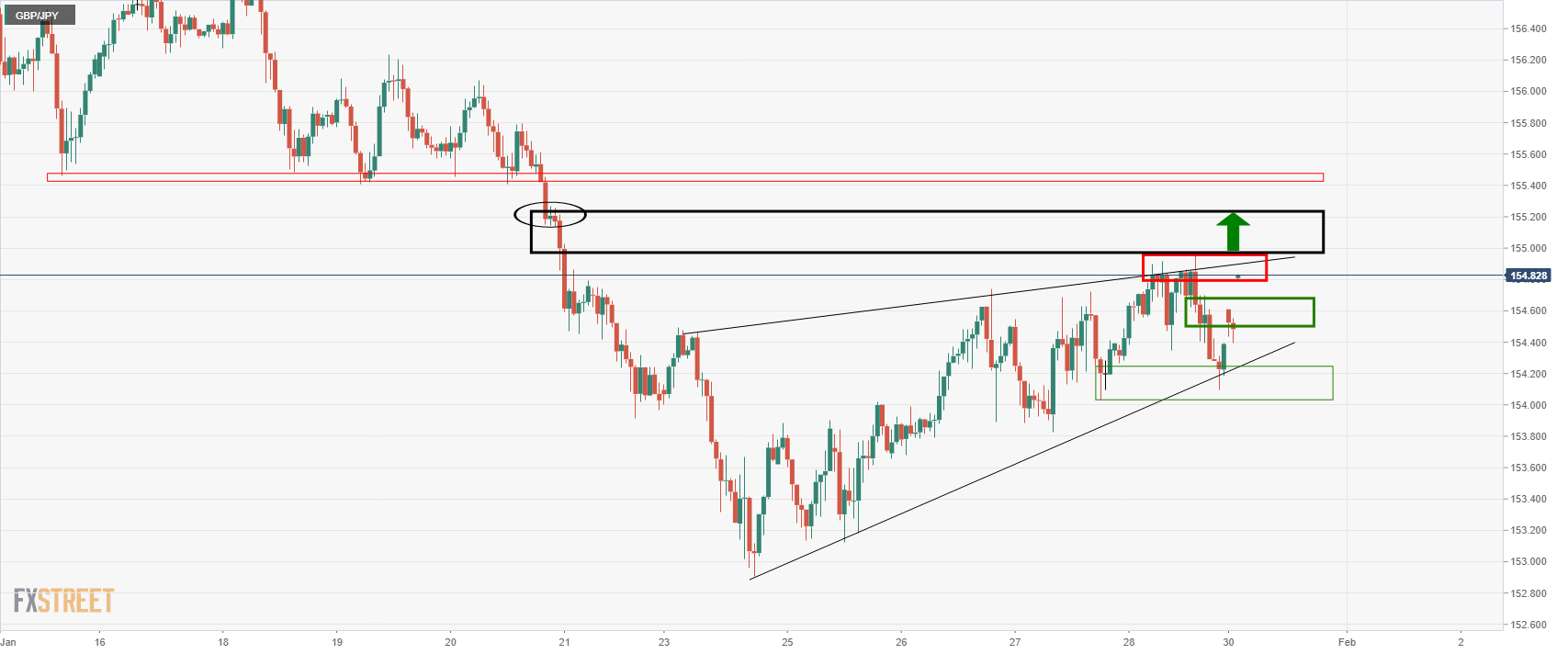
The price is testing critical hourly resistance near 1.5490 that could give way to a fast run to 155.20 in the coming hours if broken. Thereafter, 155.50 will be eyed as old support.
- US 10-year Treasury yields pare recent losses around 1.79%, S&P 500 Futures drop 0.30%.
- Fed’s Kashkari, Bostic keep 50 bps rate-hike expectations on the table, emphasize on data.
- US Senate braces for a law to sanction Russia, US data came in mixed.
Global markets struggle to extend Friday’s corrective moves as challenges to risk appetite regain strength. Among them, comments from the US Federal Reserve (Fed) officials and geopolitics gain major attention amid a light calendar during Monday’s Asian session.
That said, the benchmark US 10-year Treasury yields rose 1.6 basis points (bps) to 1.796% whereas the S&P 500 Futures drop 0.30% intraday at the latest. It should be noted that off in China restricts Asia-Pacific market moves of late.
On Friday, markets raised doubts on the Fed’s hawkish action in March following softer prints of the US Q4 Employment Cost Index (ECI). However, strong readings of the Fed’s preferred gauge of inflation, namely Core PCE Price Index for December rose to 4.9%, versus 4.8% forecast and 4.7% prior, keeping the Fed hawks on the table.
Following the US data release, Federal Reserve Bank of Minneapolis President Neel Kashkari said that he expects Fed to raise rates at the March meeting. Though, the policymaker emphasized the importance of incoming data while also saying, “Have to see how data plays out.”
On the same line was Raphael Bostic, president of the Fed’s Atlanta branch who reiterated his call for three Fed rate lifts in 2022, in an interview with the Financial Times (FT), with the first coming in March. “If the data say that things have evolved in a way that a 50 basis point move is required or [would] be appropriate, then I’m going to lean into that . . . If moving in successive meetings makes sense, I’ll be comfortable with that,” said Fed’s Bostic per FT.
It’s worth noting that the US Senate's aggression towards passing a law to sanction Russia weighs on the risk appetite. “US senators are very close to reaching a deal on legislation to sanction Russia over its actions on Ukraine, including some measures that may take effect before any invasion, two leading senators said on Sunday,” said Reuters.
Elsewhere, the virus woes worsen in Japan while Turkish President Erdogan fired another diplomat on disappointing inflation data. Further, Australia data came in mixed and New Zealand PM Ardern is waiting for her covid reports after one of the office staff traveled with covid positive.
Moving on, US jobs report and monetary policy meetings from the BOE, ECB and RBA will be crucial moving forward. For today, a light calendar emphasizes the risk catalysts as the key drivers.
Read: Stocks rebound on Apple and ECI decline, US Data, Crude's great week, Gold extends losses, BTC rebounds
| Time | Country | Event | Period | Previous value | Forecast |
|---|---|---|---|---|---|
| 00:30 (GMT) | Australia | Private Sector Credit, y/y | December | 6.6% | |
| 00:30 (GMT) | Australia | Private Sector Credit, m/m | December | 1.0% | |
| 05:00 (GMT) | Japan | Construction Orders, y/y | December | 0.0% | |
| 05:00 (GMT) | Japan | Housing Starts, y/y | December | 3.7% | 7.8% |
| 05:00 (GMT) | Japan | Consumer Confidence | January | 39.1 | |
| 10:00 (GMT) | Eurozone | GDP (QoQ) | Quarter IV | 2.2% | 0.3% |
| 10:00 (GMT) | Eurozone | GDP (YoY) | Quarter IV | 3.9% | 4.7% |
| 13:00 (GMT) | Germany | CPI, m/m | January | 0.5% | -0.3% |
| 13:00 (GMT) | Germany | CPI, y/y | January | 5.3% | 4.3% |
| 14:45 (GMT) | U.S. | Chicago Purchasing Managers' Index | January | 63.1 | 61.7 |
| 21:30 (GMT) | Australia | AIG Manufacturing Index | December | 54.8 | |
| 21:45 (GMT) | New Zealand | Trade Balance, mln | December | -864 | |
| 23:30 (GMT) | Japan | Unemployment Rate | December | 2.8% | 2.8% |
- USD/INR struggles to extend pullback from five-week high.
- Bullish MACD, sustained trading beyond 50-DMA favor buyers.
- 12-day-old support line follows 50-DMA to test bears, October 2021 high challenge buyers after refreshing monthly high.
USD/INR seesaws around 75.00 during Monday’s Asian session, following a pullback from the highest levels since December 23 the previous day.
In doing so, the Indian rupee (INR) pair stays past the 50-DMA level near 74.90, which restricted the quote’s pullback from the multi-day top on Friday.
Also acting as immediate support is an upward sloping trend line from January 13, near 74.80.
It’s worth mentioning that the 50% Fibonacci retracement (Fibo.) of September-December upside close to 74.75 becomes important to watch during the USD/INR weakness past 74.80 as a break of which will direct the quote towards 74.30 level.
On the flip side, the recent high surrounding 75.35 lure short-term USD/INR buyers ahead of the November 2021 peak of 75.65.
During the quote’s rise past 75.65, the 76.00 threshold and December 2021 high near 76.60 will be in focus.
Overall, bullish MACD signals and the pair’s sustained trading beyond the short-term key supports keep USD/INR buyers hopeful.
USD/INR: Daily chart
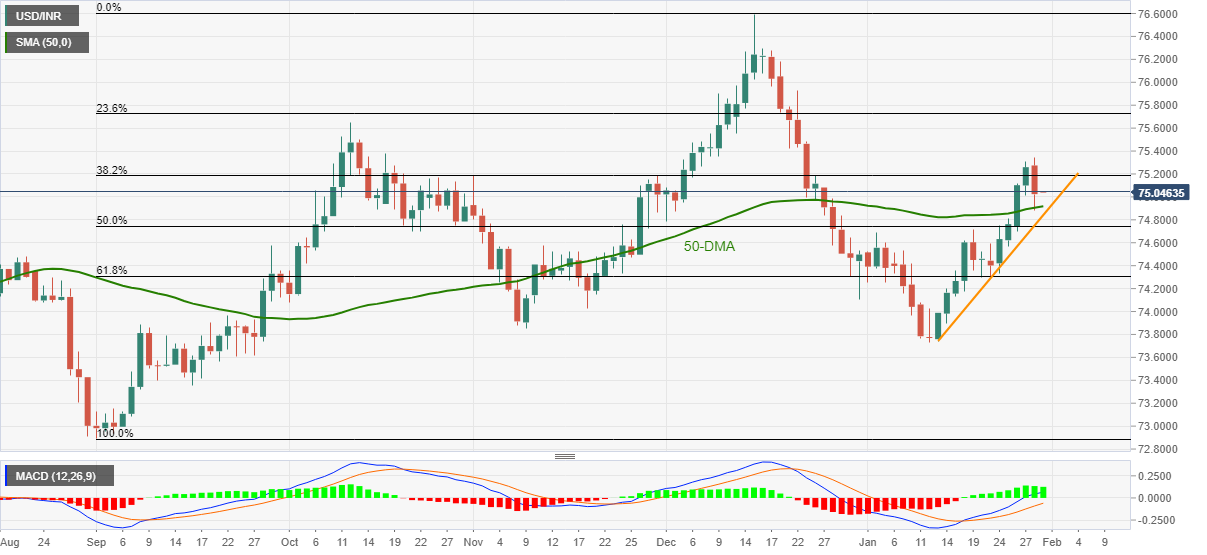
Trend: Further upside expected
- USD/TRY pares Friday’s losses during a sluggish session, refreshes intraday high at the latest.
- Erdogan sacks Head of Turkish Statistical Institute as inflation rallied in December.
- Hawkish Fedspeak, geopolitical fears also challenge pair bears.
USD/TRY picks up bids to refresh intraday high around $13.55, up 0.30% on a day during Monday’s Asian session.
In doing so, the Turkish lira (TRY) pair reacts to the weekend news that the national leader Recep Tayyip Erdogan fires another diplomat after witnessing disappointing inflation data.
This time it’s the Head of the Turkish Statistical Institute, which posts official inflation data, Sait Erdal Dincer who got replaced with Erhan Cetinkaya previous Vice President of Turkey's banking regulatory agency. It’s worth noting that the nation’s inflation data for December rose to 36.08% versus 21.31% previous.
On the other hand, hawkish comments from the US Federal Reserve (Fed) officials and the US Senate’s aggression towards passing a law to sanction Russia also play their role to propel USD/TRY prices, by way of the US dollar’s safe-haven appeal.
Federal Reserve Bank of Minneapolis President Neel Kashkari said on Friday that he expects Fed to raise rates at the March meeting. Though, the policymaker emphasized the importance of incoming data while also saying, “Have to see how data plays out.” On the same line was Raphael Bostic, President of the Fed’s Atlanta branch who mentioned, per the Financial Times (FT), “If the data say that things have evolved in a way that a 50 basis point move is required or [would] be appropriate, then I’m going to lean into that . . . If moving in successive meetings makes sense, I’ll be comfortable with that.”
While portraying risk-off mood, the US 10-year Treasury yields add 1.5 basis points (bps) to 1.795% whereas S&P 500 Futures drop 0.30% intraday at the latest.
Looking forward, a light calendar emphasizes the risk catalysts as the key drivers.
Technical analysis
USD/TRY seesaws between the 50-DMA and a descending resistance line from December 21, 2021, respectively around $13.35 and $13.75.
- AUD/USD is correcting and on the verge of a break of hourly resistance.
- The 15-min chart is showing signs of demand at a critical level.
AUD/USD bulls are attempting to correct the downtrend. The price is stuck below 0.7010 resistance but the lower time frame offers a compelling series of accumulation that could result in a strong move towards the next layer of resistance near 0.7030.
AUD/USD H1 chart
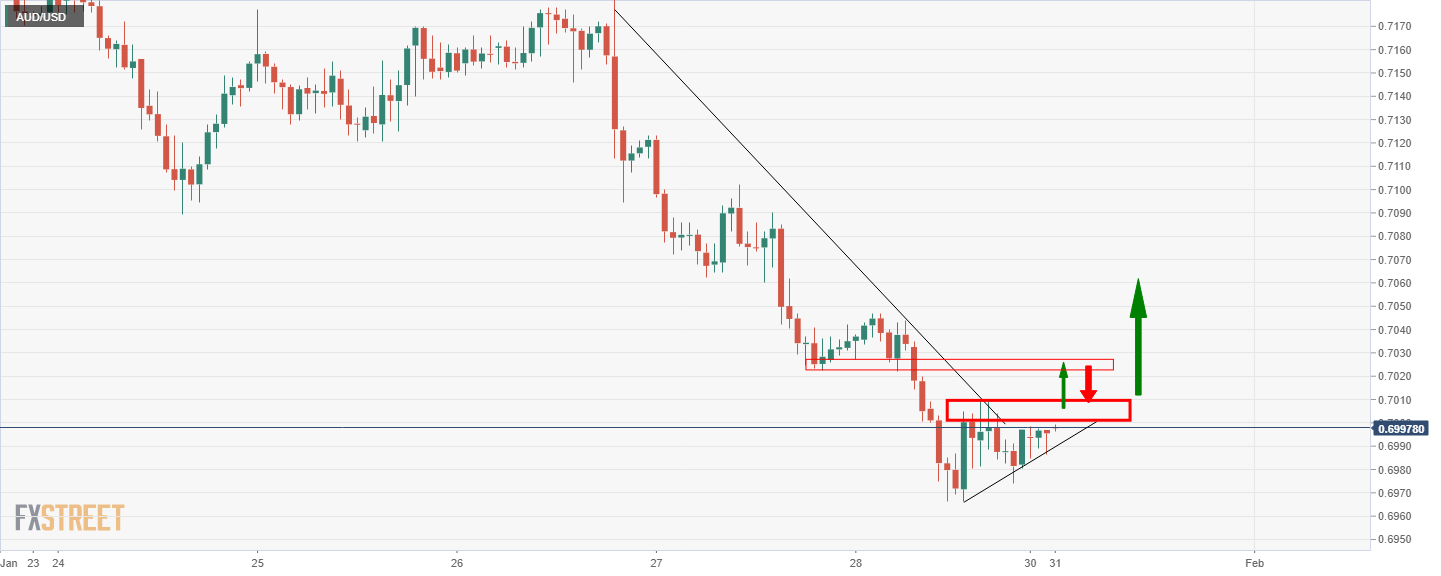
AUD/USD M15 chart
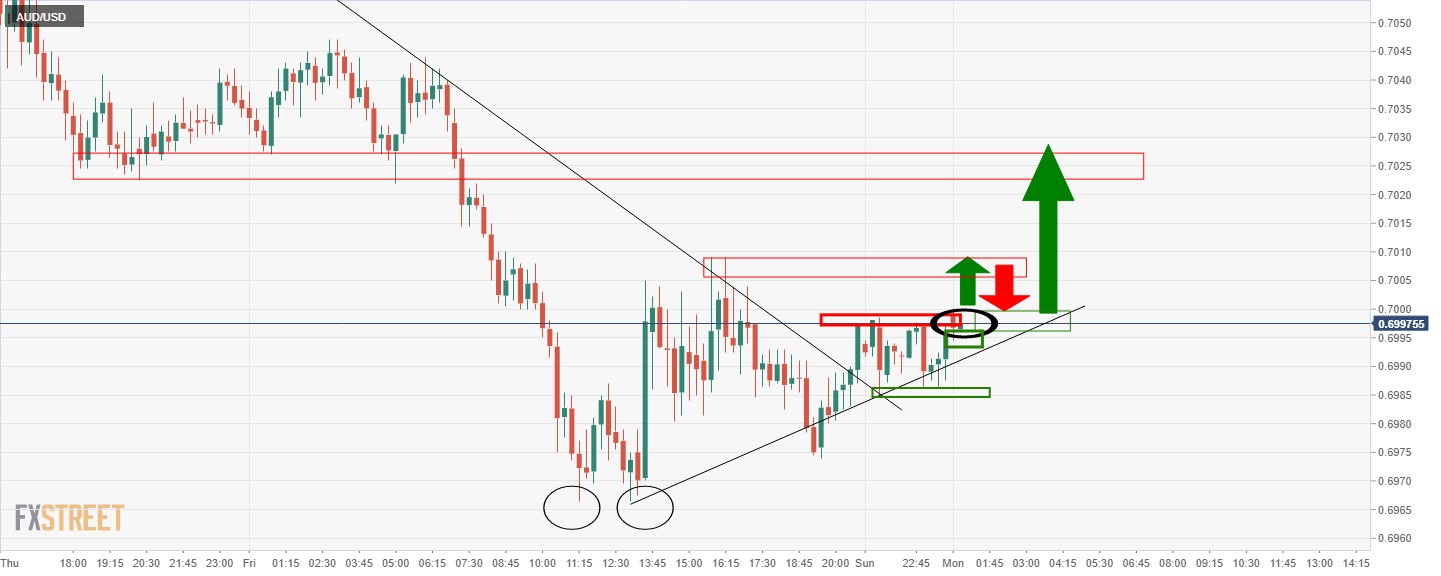
AUD/USD has started to lay a fresh foundation of support on the 15-min chart that could turn out to be crucial for the sessions ahead. If the bulls build from here, then there is a high probability that 0.7030 will be tested in the day ahead. The double bottom lows and respect of the trendline support are encouraging, as is the break of the trendline resistance. The bulls have been accumulating and a mark-up is probable.
- DXY struggles for clear direction after Friday’s pullback from multi-day peak.
- Overbought RSI conditions challenge further upside, 2021 top offers immediate support.
- Bulls remain hopeful until witnessing 100-DMA breakdown, previous resistance from November adds to the downside filters.
US Dollar Index (DXY) dribbles around the highest levels since July 2020, taking rounds to 97.20 during Monday’s Asian session.
The greenback gauge refreshed multi-month high the previous day but the overbought RSI conditions and doubts over the size of the Fed’s rate hike in March triggered the quote’s pullback.
Even so, sustained trading beyond the year 2021 peak and the resistance-turned-support line from November 2021, respectively around 96.95 and 96.25, keep DXY bulls hopeful.
It’s worth noting that the US Dollar Index bears will remain cautious, even if the quote drops below 96.25 until witnessing a clear downside break of the 100-DMA level of 95.05.
Meanwhile, further upside may initially aim for the latest peak of 97.44 and then to the 97.50 round figure.
Though, 61.8% Fibonacci Expansion (FE) of September 2021 to January 2022 moves, around 97.70, will precede the late June 2020 swing high near 97.80 to challenge the US Dollar Index bulls afterward.
DXY: Daily chart
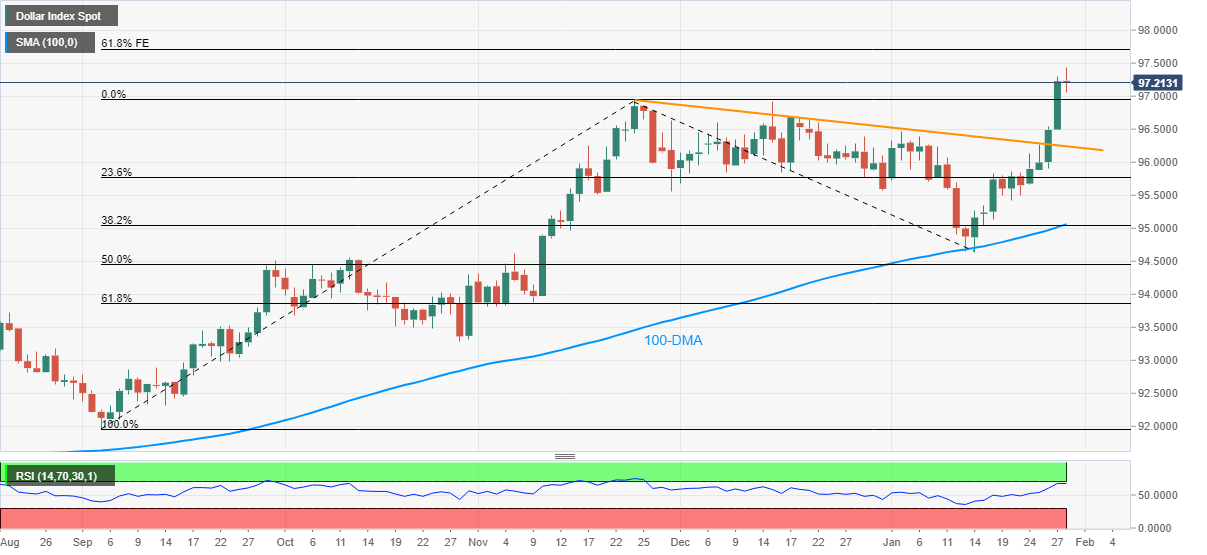
Trend: Bullish
- USD/JPY picks up bids to challenge Friday’s pullback from three-week high.
- Japan’s preliminary Industrial Production, Retail Trade eased in December.
- Pressure mounts on Japan PM to announce emergency on Tokyo as virus infections refresh record top.
- Hawkish Fedspeak, Russia tensions keep yields firmer amid a softer start to the week.
USD/JPY consolidates Friday’s losses near 115.30, the highest level in three weeks as markets in Tokyo open for Monday.
In doing so, the yen pair justifies downbeat Japanese data and firmer US Treasury yields amid a sluggish start to the week.
That said, the preliminary readings of Japan’s Industrial Production for December dropped to 2.7% YoY versus 9.7% expected and 5.1% prior. On the same line was the Retail Trade for the said month, 1.4% YoY versus 2.7% forecast and 1.9% previous readouts.
Elsewhere, coronavirus conditions in Japan continue to worsen with the escalating numbers of hospital beds in Tokyo pushing the government to announce the virus-led emergency for the second time. “Japan confirmed more than 82,000 daily coronavirus infections on Saturday, reaching a new record for the fifth straight day, as the highly transmissible Omicron variant continues to spread across the country,” said the Kyodo News.
Amid these plays, the US 10-year Treasury yields add 1.5 basis points (bps) to 1.795% whereas S&P 500 Futures drop 0.30% intraday at the latest.
It’s worth noting that Friday’s US Q4 Employment Cost Index (ECI) probed USD/JPY bulls after easing to eased to 1.0% from 1.2% market consensus and 1.3%. The wage-related data challenged the market’s previous concerns of 50 basis points (bps) of a rate hike by the Fed when it meets in March. It should be noted, however, that the Fed’s preferred gauge of inflation, namely Core PCE Price Index for December rose to 4.9%, versus 4.8% forecast and 4.7% prior, to keep the Fed hawks on the table.
Following the US data release, Federal Reserve Bank of Minneapolis President Neel Kashkari said that he expects Fed to raise rates at the March meeting. Though, the policymaker emphasized the importance of incoming data while also saying, “Have to see how data plays out.”
On the same line was Raphael Bostic, president of the Fed’s Atlanta branch who reiterated his call for three Fed rate lifts in 2022, in an interview with the Financial Times (FT), with the first coming in March. “If the data say that things have evolved in a way that a 50 basis point move is required or [would] be appropriate, then I’m going to lean into that . . . If moving in successive meetings makes sense, I’ll be comfortable with that,” said Fed’s Bostic per FT.
It’s worth noting that the US Senate's aggression towards passing a law to sanction Russia weighs on the risk appetite and test the USD/JPY bulls but the hawkish Fed favors the quote’s upside momentum.
Moving on, US jobs report and virus updates will join the Russia-Ukraine story to direct short-term USD/JPY moves amid a light calendar on Monday.
Technical analysis
A daily closing beyond the November 2021 peak of 115.52 becomes necessary for the USD/JPY bulls to aim for the 116.00 threshold and the monthly high near 116.35. Alternatively, the 20-DMA level of 114.82 restricts short-term declines of the yen pair.
| Pare | Closed | Change, % |
|---|---|---|
| AUDUSD | 0.69947 | -0.5 |
| EURJPY | 128.447 | -0.01 |
| EURUSD | 1.11476 | 0.07 |
| GBPJPY | 154.355 | 0.08 |
| GBPUSD | 1.33963 | 0.13 |
| NZDUSD | 0.65416 | -0.56 |
| USDCAD | 1.27726 | 0.27 |
| USDCHF | 0.93109 | 0.07 |
| USDJPY | 115.222 | -0.09 |
© 2000-2024. All rights reserved.
This site is managed by Teletrade D.J. LLC 2351 LLC 2022 (Euro House, Richmond Hill Road, Kingstown, VC0100, St. Vincent and the Grenadines).
The information on this website is for informational purposes only and does not constitute any investment advice.
The company does not serve or provide services to customers who are residents of the US, Canada, Iran, The Democratic People's Republic of Korea, Yemen and FATF blacklisted countries.
Making transactions on financial markets with marginal financial instruments opens up wide possibilities and allows investors who are willing to take risks to earn high profits, carrying a potentially high risk of losses at the same time. Therefore you should responsibly approach the issue of choosing the appropriate investment strategy, taking the available resources into account, before starting trading.
Use of the information: full or partial use of materials from this website must always be referenced to TeleTrade as the source of information. Use of the materials on the Internet must be accompanied by a hyperlink to teletrade.org. Automatic import of materials and information from this website is prohibited.
Please contact our PR department if you have any questions or need assistance at pr@teletrade.global.
















